Proxim Wireless U5358-480 U-NII Radio User Manual TsunamiGigabit
Proxim Wireless Corporation U-NII Radio TsunamiGigabit
Installation Manual
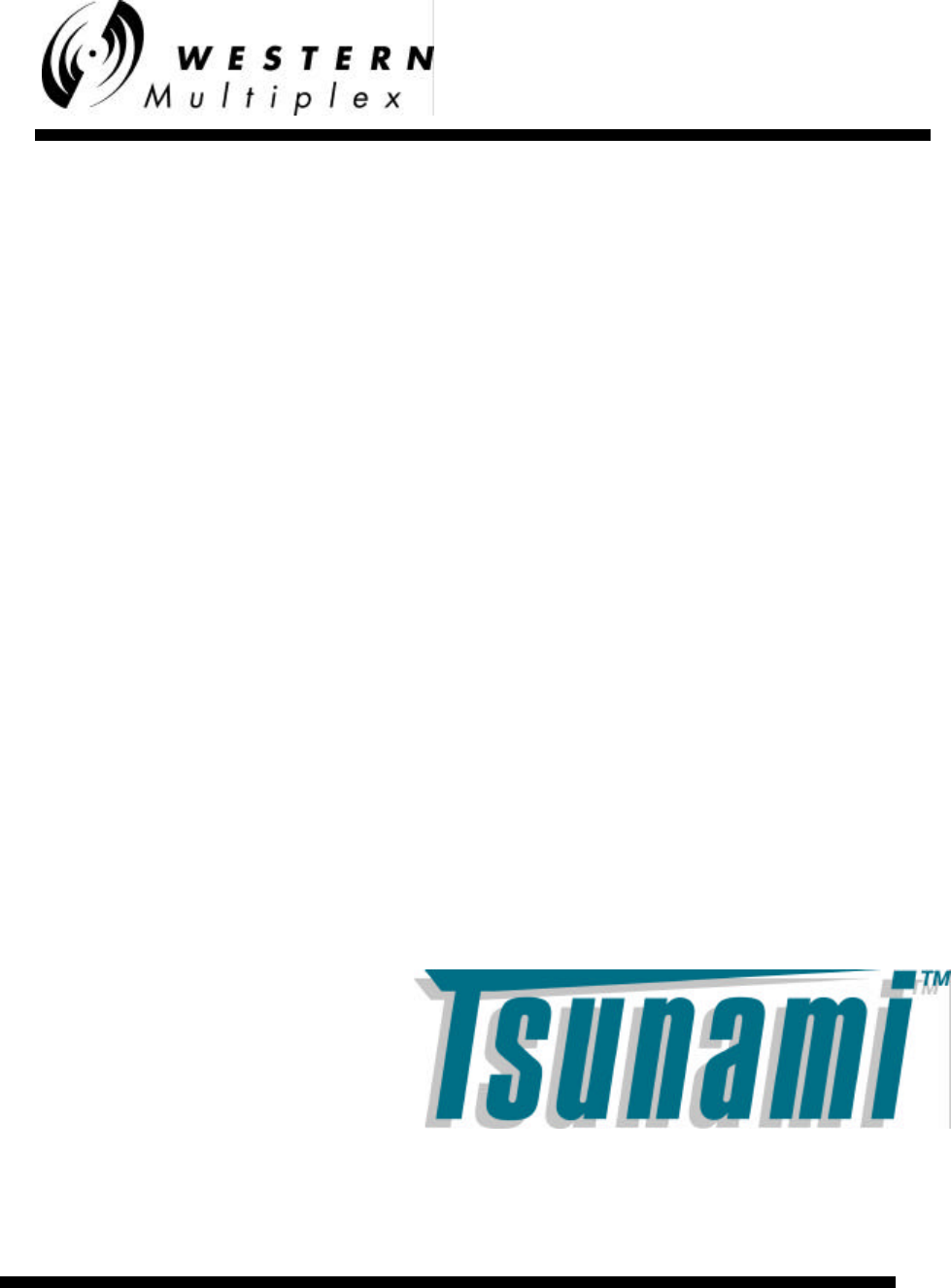
INSTALLATION AND
MAINTENANCE MANUAL
WIRELESS GIGABIT ETHERNET BRIDGE
(5.3/5.8 GHz UNII/LE-LAN1000BaseF)
MAN-27900
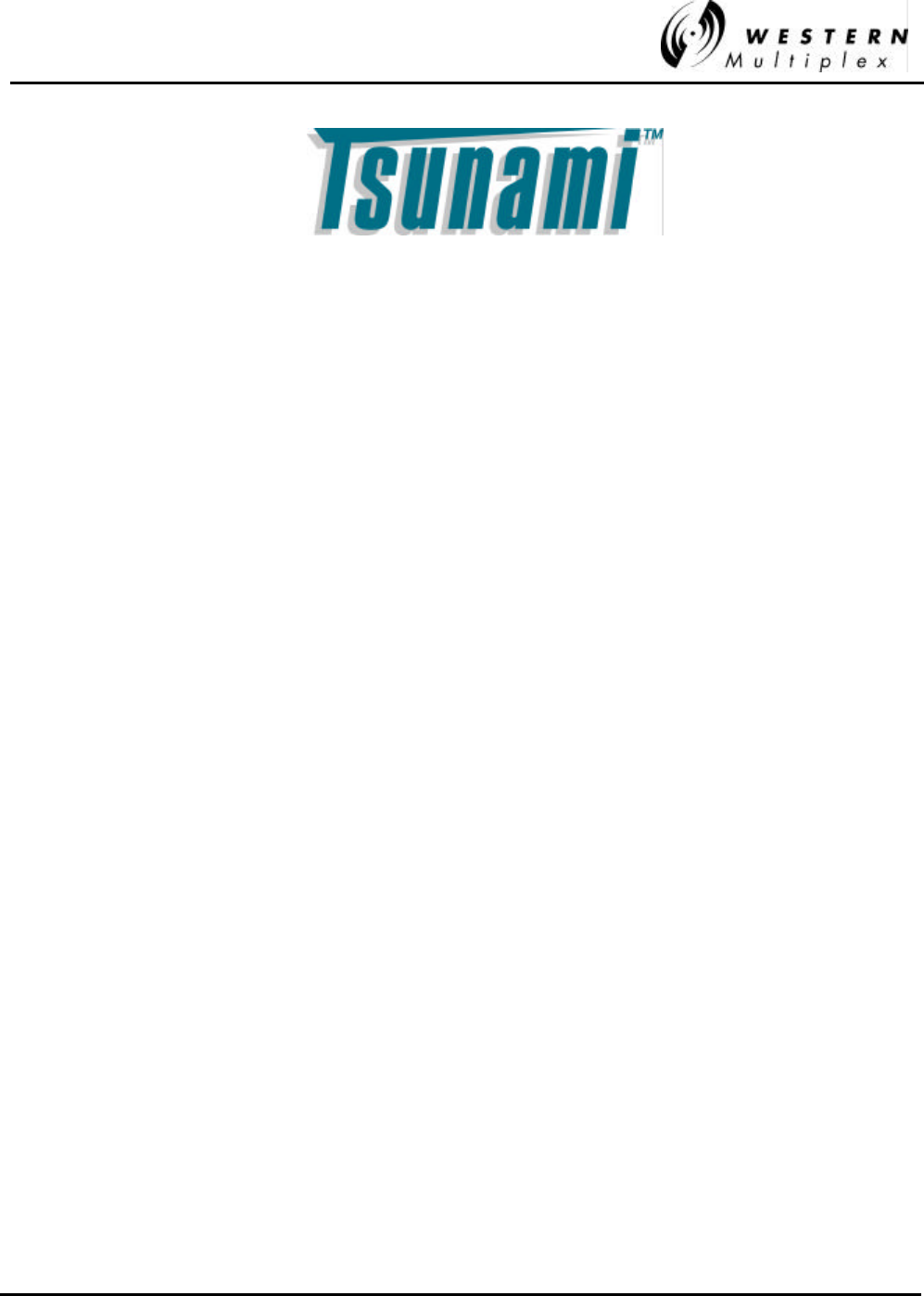
INSTALLATION AND MAINTENANCE MANUAL
Tsunami FAMILY
GIGABIT ETHERNET WIRELESS BRIDGES
JANUARY 2001
i
Installation and Maintenance Manual
Copyright © 2000 by Western Multiplex. All rights reserved. No part of this manual may be
reproduced without prior written permission from Western Multiplex.
The information contained in this manual is subject to change without notice. Western
Multiplex shall not be liable for errors contained herein or for incidental or consequential
damages in connection with the furnishing, performance, or use of this manual or equipment
supplied with this manual. Western Multiplex makes no warranty of any kind with regard to
this manual or any equipment supplied with this manual, including, but not limited to, the
implied warranties of merchantability and fitness for a particular purpose.
Heliax is a registered product of Andrews Corporation.
OpenView is a registered product of Hewlett Packard Corporation.
SmartBits is a registered product of NetCom Systems Inc.
Windows is a registered product of Microsoft Inc.
Chariot and Qcheck are a registered products of Ganymede Software Inc.
Gabriel dual-band/dual polarized flat or parabolic antennas are products of Gabriel Electronics Inc.
RadioWave dual-band/dual polarized, flat or parabolic antennas are products of Radio Wave Corp.
Other names are trademarks of their owners
Printed in the United States of America
Notice: Y2K (Year 2000 Issue)
All software supplied by and for Western Multiplex products adheres to the four-(4) digit
year nomenclature as required for Year 2000 compliance.
Western Multiplex
1196 Borregas Avenue
Sunnyvale, California
USA
Tel: +1 408 542-5200
Fax:: +1 408 542-5300
e-mail: info@wmux.com
Our facility has been Registered to the International Organization for Standardization
ISO 9000 Series Standards for quality.
Issue: January 2001

INSTALLATION AND MAINTENANCE MANUAL
Tsunami FAMILY
GIGABIT ETHERNET WIRELESS BRIDGES
JANUARY 2001
ii
Revision history:
November 2000: First version
Draft version
December 2000: Added updated drawings
Front panel LED detail
Update NMS screen captures
January 2001 Replaced Browser NMS graphics
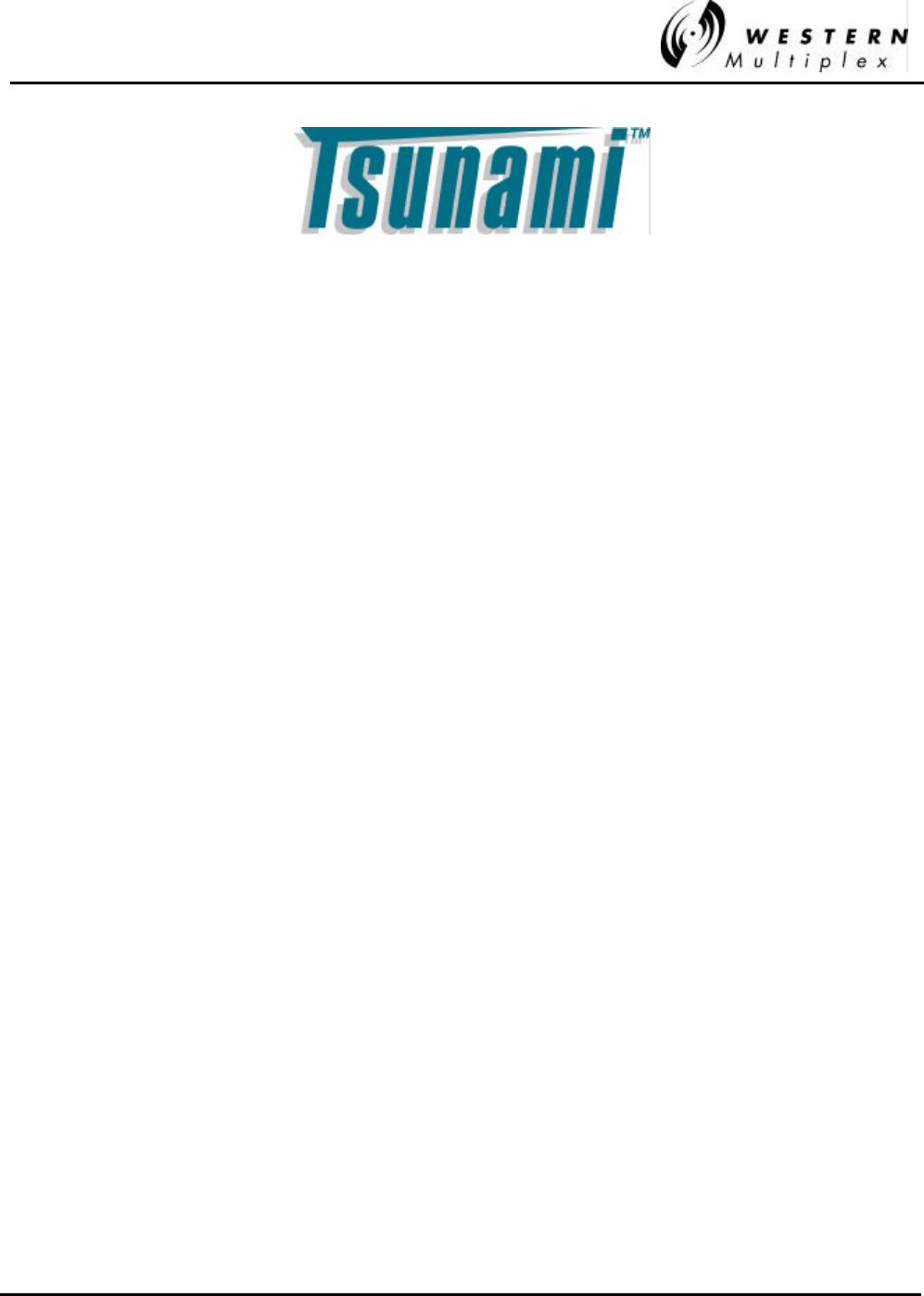
INSTALLATION AND MAINTENANCE MANUAL
Tsunami FAMILY
GIGABIT ETHERNET WIRELESS BRIDGES
JANUARY 2001
iii
Regulatory Notice
This equipment has been tested and found to comply with the limits for a class B digital device,
pursuant to Part 15 of the FCC Rules. This equipment generates, uses and can radiate radio
frequency energy and is to be installed and used in accordance with the instructions.
Shielded cables and I/O cords must be used for this equipment to comply with the relevant FCC
regulations.
Changes or modifications not expressly approved in writing by Western Multiplex may void the user's
authority to operate this equipment.
This device must be professionally installed.

INSTALLATION AND MAINTENANCE MANUAL
Tsunami FAMILY
GIGABIT ETHERNET WIRELESS BRIDGES
JANUARY 2001
iv
This page intentionally left blank

INSTALLATION AND MAINTENANCE MANUAL
Tsunami FAMILY
GIGABIT ETHERNET WIRELESS BRIDGES
JANUARY 2001
vW/CS97-1
GENERAL TERMS
1.1 All Definitions contained in Western Multiplex's Conditions of Sale
(Western Multiplex document number CS96-8), apply to the
Warranty.
1.2 Subject to the provisions of the Warranty, Western Multiplex
warrants that the equipment described in Paragraph 1.3 shall
conform to their specifications described in Paragraph 1.4 in all
material respects and that the equipment shall be free from
material defects in materials and workmanship.
1.3 This Warranty applies to all original purchases of Western
Multiplex manufactured equipment and accessories (collectively
the "Equipment").
1.4 This Warranty applies to the specifications contained in the most
recent version of the manual for the model of the Equipment
purchased (the "Specifications").
1.5 This Warranty does not apply to the following items of Equipment
which are covered by the Original Equipment Manufacturer's
warranty:
(a) antenna systems, including coax cable, waveguide, connectors
flex-sections, mounts, other parts of the antenna system and
installation materials;
(b) non-Western Multiplex manufactured rack mounted equipment
that is assembled wired and tested at Western Multiplex's
factory or supplied as part of a system, including orderwire
items, channel banks, multiplexers, fuse/alarm panels, remote
alarm items; and
(c) equipment which is not listed in Western Multiplex's price book.
1.6 The effective period of this Warranty shall start on the date of
shipment of the Equipment and shall end:
(a) for all spread spectrum unlicensed radio products and for all
licensed digital microwave radio products, two (2) years later;
(b) for all analog microwave radio products, three (3) years later; or
(c) for all baseband products, five (5) years later (in each case the
"Warranty Period").
1.7 The Customer acknowledges that Western Multiplex does not
represent or warrant that the services provided by Western
Multiplex under this Warranty will ensure uninterrupted or error-
free operation of the Equipment.
RETURN OF EQUIPMENT UNDER WARRANTY
2.1 If an item of Equipment malfunctions or fails in normal intended
usage and maintenance within the applicable Warranty Period:
(a) the Customer shall promptly notify Western Multiplex of the
problem and the serial number of the defective item;
(b) Western Multiplex shall, at its sole option, either resolve the
problem over the telephone or provide the Customer with a
Returned Materials Authorization number (RMA #) and the
address of the location to which the Customer may ship the
defective item;
(c) if the problem is not resolved over the telephone, the Customer
shall attach a label to each Returned item describing the fault
and the Customer's Return address. The Customer shall, at its
cost, properly pack the item to be Returned, prepay the
insurance and shipping charges, and ship the item to the
specified location;
(d) if the Western Multiplex product shall prove to be defective in
material or workmanship upon examination by Western
Multiplex, Western Multiplex shall either repair or replace the
Returned item at its sole option. The replacement item may be
new or refurbished; if refurbished, it shall be equivalent in
operation to new Equipment. If a Returned item is replaced by
Western Multiplex, the Customer agrees that the Returned item
shall become the property of Western Multiplex.
(e) Western Multiplex shall at its cost, ship the repaired item or
replacement to any destination within the United States of
America by carrier and method of delivery chosen by Western
Multiplex. If the Customer has requested some other form of
conveyance, such as express shipping, or is located beyond the
USA borders, then the Customer shall pay to the cost of return
shipment.
2.2 Equipment which is repaired or replaced by Western Multiplex
under this Warranty shall be covered under all of the provisions of
this Warranty for the remainder of the applicable Warranty Period
or ninety (90) days from the date of shipment of the repaired item
or replacement, whichever period is longer.
DEFAULT AND TERMINATION
3.1 Western Multiplex may immediately terminate this Warranty and all
of its performance under this Warranty, upon notification to the
Customer, if the Customer:
(a) makes any unauthorized modifications to the Equipment;
(b) assigns or transfers the Customer's rights or obligations under
this Warranty without the written consent of Western Multiplex;
(c) becomes bankrupt or insolvent, or is put into receivership; or
(d) has not paid Western Multiplex all amounts for the Equipment,
services, or other additional charges within thirty (30) days of
receipt of written notice from Western Multiplex.
3.2 If this Warranty is terminated by Western Multiplex, the Customer
shall remain liable for all amounts due to Western Multiplex.
FORCE MAJEURE
4.1 "Force Majeure" has the same meaning as defined in Western
Multiplex's Conditions of Sale (Western Multiplex document
number CS96-8).
4.2 Western Multiplex shall not be responsible for failure to discharge
its obligations under this Warranty due to Force Majeure.
LIMITATIONS AND QUALIFICATIONS OF WARRANTY
5.1 This Warranty does not apply to any damage, defect or failure
caused by:
(a) any part of the Equipment having been modified, adapted,
repaired, or improperly installed, operated, maintained, transported
or relocated by any person other than Western Multiplex personnel
or a Western Multiplex authorized service agent, without Western
Multiplex's prior written consent;
(b) storage or environmental conditions which do not conform to the
applicable sections of the appropriate Western Multiplex
Equipment Manual;
(c) failure to conform with the Equipment Installation, Operating and
Maintenance Instructions of the appropriate Western Multiplex
Equipment Manual;
(d) external causes, including external electrical stress or lightning, or
use in conjunction with incompatible equipment, unless such use
was with Western Multiplex's prior written consent;
(e) cosmetic damage;
(f) accidental damage, negligence, neglect, mishandling, abuse or
misuse, other than by Western Multiplex personnel or a Western
Multiplex authorized service agent; or
(g) Force Majeure.
Please see reverse side for additional limitations on damages.
WARRANTY

INSTALLATION AND MAINTENANCE MANUAL
Tsunami FAMILY
GIGABIT ETHERNET WIRELESS BRIDGES
JANUARY 2001
W/CS97-1 vi
LIMITATIONS ON DAMAGES (North America)
6.1 THE WARRANTY STATED IN THIS DOCUMENT IS
THE CUSTOMER'S EXCLUSIVE WARRANTY FOR THE
EQUIPMENT; WESTERN MULTIPLEX SPECIFICALLY
DISCLAIMS ALL OTHER WARRANTIES OF ANY KIND,
EXPRESS OR IMPLIED, INCLUDING ANY
WARRANTIES OF FITNESS FOR A PARTICULAR
PURPOSE AND OF MERCHANTABILITY.
6.2 WESTERN MULTIPLEX SHALL NOT BE LIABLE IN
TORT, INCLUDING LIABILITY IN NEGLIGENCE OR
STRICT LIABILITY, AND SHALL HAVE NO LIABILITY
AT ALL FOR INJURY TO PERSONS OR PROPERTY.
WESTERN MULTIPLEX'S LIABILITY FOR FAILURE TO
FULFIL ITS OBLIGATIONS UNDER THIS WARRANTY
OR ANY OTHER LIABILITY UNDER OR IN
CONNECTION WITH THE EQUIPMENT SHALL BE
LIMITED TO THE AMOUNT OF THE PURCHASE
PRICE OF THE EQUIPMENT. THE REMEDIES
STATED IN THIS WARRANTY ARE THE CUSTOMER'S
EXCLUSIVE REMEDIES AGAINST WESTERN
MULTIPLEX REGARDING THE EQUIPMENT.
6.3 EVEN IF WESTERN MULTIPLEX HAS BEEN ADVISED
OF THE POSSIBILITY OF THEM, WESTERN
MULTIPLEX SHALL NOT BE LIABLE FOR ANY
INDIRECT, INCIDENTAL, SPECIAL OR
CONSEQUENTIAL DAMAGES, INCLUDING THE COST
OF LABOR BY THE CUSTOMER'S OWN EMPLOYEES,
AGENTS OR CONTRACTORS IN IDENTIFYING,
REMOVING OR REPLACING THE DEFECTIVE ITEM;
LOST PROFITS, AND REVENUES; FAILURE TO
REALIZE EXPECTED SAVINGS; ANY CLAIM AGAINST
A CUSTOMER BY A THIRD PARTY; OR ANY OTHER
COMMERCIAL OR ECONOMIC LOSSES OF ANY
KIND.
6.4 THESE LIMITATIONS AND DISCLAIMERS ARE NOT
MADE BY WESTERN MULTIPLEX WHERE
PROHIBITED BY LAW.
LIMITATIONS ON DAMAGES (International)
6.1 THE WARRANTY STATED IN THIS DOCUMENT IS
THE CUSTOMER'S EXCLUSIVE WARRANTY FOR THE
EQUIPMENT; ALL OTHER WARRANTIES OF ANY
KIND, EXPRESS OR IMPLIED, INCLUDING ANY
WARRANTIES OF FITNESS FOR A PARTICULAR
PURPOSE AND OF MERCHANTABILITY ARE
EXCLUDED TO THE FULLEST EXTENT PERMITTED
BY LAW.
6.2 WESTERN MULTIPLEX'S LIABILITY FOR FAILURE TO
FULFIL ITS OBLIGATIONS UNDER THIS WARRANTY
OR IN TORT OR AS A RESULT OF STRICT LIABILITY
OR ANY OTHER LIABILITY UNDER OR IN
CONNECTION WITH THE EQUIPMENT OR ITS
SUPPLY SHALL BE LIMITED, EXCEPT IN RESPECT
OF DEATH AND PERSONAL INJURY CAUSED BY
WESTERN MULTIPLEX'S NEGLIGENCE, TO THE
AMOUNT OF THE PURCHASE PRICE OF THE
EQUIPMENT. THE REMEDIES STATED IN THIS
WARRANTY ARE THE CUSTOMER'S EXCLUSIVE
REMEDIES AGAINST WESTERN MULTIPLEX
REGARDING THE EQUIPMENT.
6.3 EVEN IF WESTERN MULTIPLEX HAS BEEN ADVISED
OF THE POSSIBILITY OF THEM, WESTERN
MULTIPLEX SHALL NOT BE LIABLE FOR ANY
INDIRECT, INCIDENTAL, SPECIAL OR
CONSEQUENTIAL DAMAGES, INCLUDING THE COST
OF LABOR BY THE CUSTOMER'S OWN EMPLOYEES,
AGENTS OR CONTRACTORS IN IDENTIFYING,
REMOVING OR REPLACING THE DEFECTIVE ITEM;
LOST PROFITS, AND REVENUES; FAILURE TO
REALIZE EXPECTED SAVINGS; ANY CLAIM AGAINST
A CUSTOMER BY A THIRD PARTY; OR ANY OTHER
COMMERCIAL OR ECONOMIC LOSSES OF ANY
KIND.

INSTALLATION AND MAINTENANCE MANUAL
Tsunami FAMILY
GIGABIT ETHERNET WIRELESS BRIDGES
JANUARY 2001
vii W/CS97-1
DEFINITIONS
1.1 In these Conditions, unless there is something in the subject
matter or context necessarily inconsistent:
(a) "Western Multiplex" means Western Multiplex (d.b.a. Western
Multiplex), Sunnyvale, CA;
(b) "Equipment" means the equipment itemized on the
Quotation/Order Acknowledgment;
(c) "International" means any location other than United States of
America and Canada, including their territories and possessions;
(d) "North America" means any location in the United States of
America and Canada, including their territories and possessions;
(e) "Order Acknowledgment" means the sales order acknowledgment
provided by Western Multiplex to the Customer;
(f) "Payment Instructions" means Western Multiplex's payment
instructions, (Western Multiplex document P197-1);
(g) "Quotation" means the quotation signed by an authorized
representative of Western Multiplex and provided to the Customer;
(h) "Shipping Date" means the actual date on which the Equipment
left Western Multiplex's factory at Sunnyvale, CA, U.S.A.;
(i) "Warranty" means Western Multiplex's warranty, document W97-1;
(j) "Invoice" means the bill of goods prepared by Western Multiplex
for the equipment with the shipping and any insurance costs.
1.2 Headings have been inserted in these Conditions for convenience
of reference only and will not effect their construction.
ENTIRE AGREEMENT
2.1 The Quotation, these Conditions of Sale, the Order
Acknowledgment, the Payment Instructions and the Warranty shall
apply to all sales made by Western Multiplex and shall constitute
the entire agreement by Western Multiplex and the Customer (the
"Agreement ").
2.2 Any terms and/or conditions of sale, which may be included on the
Customer's purchase order form or any communication from the
Customer, that are not identical with the terms and conditions
steed in this document shall NOT become a part of the agreement
of sale unless expressly agreed to in writing in the Quotation.
2.3 Western Multiplex's failure to object to any terms and/or conditions
of sale contained in any communication from the Customer shall
not be considered as acceptance of such terms and/or conditions
or as a waiver of the terms and conditions of sale contained
herein.
2.4 Western Multiplex shall sell to the Customer, and the Customer
shall purchase from Western Multiplex, the Equipment in
accordance with the Agreement. Western Multiplex accepts the
Customer's purchase orders for Equipment and agrees to deliver
the Equipment to the Customer only on the terms of the
Agreement.
2.5 No variation of the Agreement shall be binding unless agreed to in
writing by authorized representatives of Western Multiplex and the
Customer.
PRICING
3.1 All prices in the Quotation are exclusive of all shipping charges
and all applicable taxes including but not limited to, federal, state,
local, excise, sales and use taxes.
3.2 All prices in the Quotation unless otherwise stated:
(a) for North American customers are FOB Sunnyvale, CA, USA.
(New York Uniform Commercial Code); or
(b) for international customers are Ex-Works, Sunnyvale, CA, U.S.A.
(Incoterms 1990).
3.3 All prices in the Quotation include standard domestic packing,
unless a separate line item is provided detailing export or special
packing charges.
SHIPPING AND INSURANCE
4.1 Western Multiplex shall arrange shipping and insurance when
requested by the Customer, and shall bill the Customer for the
Equipment with the shipping and any insurance costs as separate
items, on an invoice (the "Invoice").
4.2 Delivery dates quoted by Western Multiplex are to be considered
estimates only. In no event will Western Multiplex be liable for any
loss or damage resulting from its failure to deliver products within a
specified time.
TERMS OF PAYMENT
5.1 The Customer shall pay for all Equipment, including shipping and
insurance in accordance with the terms of the Invoice.
5.2 All Invoices for North American Customers are due and payable in
thirty (30) days from the date of the Invoice.
5.3 International Customers shall make payments in accordance with
Western Multiplex's Payment Instructions by either:
(a) providing a wire transfer (telegraphic transfer) for the full amount of
the Equipment, shipping and insurance charges contained in the
Quotation or the pro-forma Invoice sent to the Customer, prior to
the Shipping Date; or
(b) establishing an acceptable Letter of Credit (LC) for the full amount
of the Equipment, shipping and insurance charges contained in the
Quotation prior to the order being booked and accepted by
Western Multiplex.
5.4 If a Customer fails to pay an Invoice when due, Western Multiplex
may, without prejudice to am other remedy, postpone shipments,
alter payment terms, terminate the Agreement and charge interest
on all overdue amounts the rate of 1.5% per month compounded
monthly (or if less, the maximum allowed by law). Upon demand,
the Customer shall pay all such interest charges and all
reasonable collection fees, including reasonable legal expenses.
SECURITY FOR PAYMENT
6.1 If the Customer is located in North America, the Customer grants
to Western Multiplex a purchase money security interest in the
Equipment to secure the payment of the purchase price of the
Equipment and all other amounts due from the Customer.
6.2 If the Customer is not located in North America:
(a) despite delivery and passing of risk in the Equipment and any
other provision of these Conditions, the title in the Equipment shall
not pass to the Customer until Western Multiplex has received
payment in full of the purchase price of the Equipment and all
other amounts then due from the Customer, and
(b) until the title in the Equipment passes to the Customer:
(i) the Customer shall hold the equipment as Western Multiplex 's
fiduciary agent and bailee, and shall properly store, protect and
insure the Equipment and shall identify the Equipment as Western
Multiplex property;
(ii) if the Customer fails to pay Western Multiplex in accordance with
the agreed payment terms, Western Multiplex may require the
Customer to deliver up the Equipment to Western Multiplex, and, if
the Customer does not, Western Multiplex may enter on the
premises where the Equipment is stored and repossess the
Equipment; and
(iii) the Customer shall not pledge the Equipment by way of security for
any, indebtedness of the Customer, but if the Customer does so all
moneys owed by the Customer to Western Multiplex shall, without
prejudice to any other remedy of Western Multiplex, immediately
become due.
CHANGES TO PRODUCT SPECIFICATIONS
7.1 Western Multiplex may, without notice to the Customer, make
changes to the specifications of Equipment which do not materially
affect the quality or performance of the Equipment.
EQUIPMENT CONFIGURATION AND EXPEDITING CHARGES
8.1 At the Customer's request, Western Multiplex may, for a fee
agreed in advance:
(a) reconfigure the Equipment; or
(b) expedite the Customer's order.
CONDITIONS OF SALE

INSTALLATION AND MAINTENANCE MANUAL
Tsunami FAMILY
GIGABIT ETHERNET WIRELESS BRIDGES
JANUARY 2001
W/CS97-1 viii
SHORTAGES
9.1 The customer shall not make any claim for shortages (which are
items that the Invoice does not show are on back-order) after
twenty-one (21) days after the date of the Invoice.
RETURNS AND EXCHANGES
10.1 The return of defective Equipment is covered by the Warranty .
10.2 The Customer may only return Equipment that is not defective if:
(a) the Equipment does not correspond with the Customer's purchase
order; or
(b) the Equipment has been ordered in error by the Customer and
Western Multiplex has permitted the Customer to remedy the
mistake by ordering the correct equipment and resuming the
Equipment and the Customer obtains a Returned Materials
Authorization number ("RMA #") from Western Multiplex prior to
returning any Equipment.
10.3 Western Multiplex reserves the right to charge a fee for returned
equipment under Subparagraph 10.2(b) with the amount of the fee
being determined prior to an RMA # being given by Western
Multiplex.
10.4 Authorized returns of equipment under Paragraph 10.2 must be in
an undamaged condition, in the original configuration, in the
original packing materials and within a time period agreed to when
the RMA # was issued.
10.5 If the Customer does not comply with the provisions of Paragraphs
10.2, 10.3, and 10.4, the Customer shall pay the full amount of the
Invoice.
10.6 The party liable for all shipping, insurance and any other expenses
incurred by the Customer in returning the Equipment under
Paragraph 10.2 and for all loss or damage to the Equipment until
received by Western Multiplex, shall be: (a) for all items returned
under Subparagraph 10.2(a), Western Multiplex and (b) for all
items resumed under Subparagraph 10.2(b), the Customer.
CANCELLATION
11.1 If the Customer cancels an order before the Shipping Date,
Western Multiplex reserves the right to charge the Customer a
cancellation charge up to 100% of the amount of the order.
11.2 The Customer shall pay all cancellation charges within thirty (30)
days from date of the Invoice.
FORCE MAJEURE
12.1 Western Multiplex shall not be liable if its performance of the
Agreement becomes commercially impractical due to any
contingency beyond Western Multiplex's reasonable control,
including acts of God, fires, floods, wars, sabotage, civil unrest,
accidents, labor disputes or shortages, government laws, rules and
regulations, whether valid or invalid, inability to obtain material,
equipment or transportation, incorrect, delayed or incomplete
specifications, drawings or data supplied by the Customer or
others (collectively "Force Majeure"). In no event of Force Majeure
shall Western Multiplex be required to purchase goods from others
to enable it to deliver the Equipment under the Agreement.
ENGINEERING AND SYSTEM DESIGN
13.1 The Customer is solely responsible for the engineering, design,
integration and normal preventative and remedial maintenance of
the Customer's system for which Western Multiplex supplies
Equipment.
13.2 Western Multiplex is not responsible for the satisfactory operation of
the Equipment in conjunction with other manufacturer's equipment,
nor for any losses which may occur as a result of a failure of the
Equipment to operate in conjunction with other manufacturer's
equipment.
WARRANTY
14.1 All Equipment is covered by the Warranty.
14.2 THE WARRANTY CONTAINS LlMITATIONS ON THE
CUSTOMER'S RIGHTS AND REMEDIES AGAINST WESTERN
MULTIPLEX UNDER THE AGREEMENT.
THE CUSTOMER ACKNOWLEDGES HAVING READ,
UNDERSTOOD AND AGREED TO THOSE LIMITATIONS.
DAMAGES FOR BREACH OF AGREEMENT
15.1 If either party is successful in any litigation between the parties
based on the Agreement, the successful party shall recover from
the other, in addition to direct damages, the successful party's
reasonable attorney's fees and other costs of litigation.
INSOLVENCY OF CUSTOMER, ETC.
16.1 Western Multiplex may cancel the Agreement and suspend any
further deliveries under the Agreement without any liability to the
Customer, and, if Equipment has been delivered but not paid for,
the price shall become immediately due and payable despite any
other agreement to the contrary if:
(a) any proceedings in bankruptcy, insolvency, receivership or
liquidation are taken against the Customer;
(b) the Customer makes an assignment for the benefit of
creditors or commits an act of bankruptcy or insolvency;
(c) the Customer ceases, or threatens to cease, to carry on the
ordinary course of its business, or transfers all or substantially all
of its property;
(d) the Equipment is seized under any legal process or
confiscated; or
(e) Western Multiplex in good faith believes that the ability of the
Customer to pay or perform any provision of the Agreement is
impaired, or that any of the events mentioned above is about to
occur.
NOTICE
17.1 All requests, instructions and notices from one party to the other
must be in writing and may be given via registered post or
facsimile transmission to the address of the parties shown on the
Quotation or Order Acknowledgment.
EXPORT PROVISIONS
18.1 The Customer shall not, whether directly or indirectly (including
facilitating a third party) export or re-export the Equipment outside
the country in which the Customer has stated these items are to be
used without obtaining the licenses required under ail applicable
rules. The Customer shall indemnify Western Multiplex against any
liability incurred by Western Multiplex due to any violation by the
Customer of any of the provisions of this Section, but this
indemnity shall not apply if the Customer reasonably relies on
information supplied to it by Western Multiplex with respect to
export licenses. Upon receipt of a governmental consent to export
the receiving party shall immediately notify the other in writing.
MISCELLANEOUS
19.1 No waiver by Western Multiplex of any breach of this Agreement
shall be considered as a waiver of any subsequent breach of the
same or any other provision.
19.2 Any provision of the Agreement which is, or is deemed to be,
unenforceable in any jurisdiction shall be severable from the
Agreement in that jurisdiction without in any way invalidating the
remaining portions of the Agreement, and that unenforceability
shall not make that provision unenforceable in any other
jurisdiction.
19.3 The rights which accrue to Western Multiplex by virtue of the
Agreement shall inure for the benefit of and be binding upon the
successors and assigns of Western Multiplex.
19.4 The agreement shall be governed by the laws of the State of
California including the California Uniform Commercial Code.
However Western Multiplex may enforce the provisions of the
Agreement in accordance with the laws of the jurisdiction in which
the Equipment is situated. The United Nations Convention on the
Sale of Goods (The Vienna Convention) shall not apply to the
Agreement.
19.5 Les parties ont exigés que cette entente soit rédigée en anglais.

INSTALLATION AND MAINTENANCE MANUAL
Tsunami FAMILY
GIGABIT ETHERNET WIRELESS BRIDGES
JANUARY 2001
TOC & INTRODUCTION i
Table of Contents
1. HOW TO USE THIS MANUAL .................................................................................................................... 1-1
1.1 MANUAL ORGANIZATION............................................................................................................................ 1-1
1.2 ICONS ......................................................................................................................................................... 1-2
2. PRODUCT DESCRIPTION........................................................................................................................... 2-1
2.1 GENERAL DESCRIPTION............................................................................................................................ 2-1
2.2 SPECIFICATIONS.......................................................................................................................................... 2-2
2.2.1 Transmitter ........................................................................................................................................ 2-2
2.2.2 Antenna / Antenna Coupling Unit...................................................................................................... 2-3
2.2.3 Receiver ............................................................................................................................................. 2-3
2.2.4 System (Single Hop Performance)..................................................................................................... 2-4
2.2.5 Line Interfaces ................................................................................................................................... 2-4
2.2.6 Auxiliary Connections........................................................................................................................ 2-5
2.2.7 Temperature and Environment.......................................................................................................... 2-6
2.2.8 Power................................................................................................................................................. 2-6
2.2.9 Regulatory Information ..................................................................................................................... 2-6
2.2.10 Mechanical ........................................................................................................................................ 2-6
2.3 FRONT PANEL DESCRIPTION ....................................................................................................................... 2-6
2.3.1 General.............................................................................................................................................. 2-7
2.3.2 Test Points on ODU........................................................................................................................... 2-8
2.3.3 Alarm and Status Indicators .............................................................................................................. 2-9
2.3.4 Controls ........................................................................................................................................... 2-10
2.3.5 Connections ..................................................................................................................................... 2-11
2.4 REAR PANEL DESCRIPTION ....................................................................................................................... 2-13
2.5 INSTALLATION ACCESSORIES.................................................................................................................... 2-14
3. INSTALLATION & ADJUSTMENTS.......................................................................................................... 3-1
3.1 SHIPPING CONTAINER ................................................................................................................................. 3-1
3.2 PACKING ITEMS IDENTIFICATION ................................................................................................................ 3-2
3.3 BEFORE INSTALLATION TASK LIST ............................................................................................................. 3-3
3.3.1 Site Selection Requirements............................................................................................................... 3-3
3.3.2 Line-of-Sight and Path Clearance Guidelines................................................................................... 3-4
3.3.3 RSL Calculation and Link Budget ..................................................................................................... 3-5
3.3.4 Fade Margin Calculation .................................................................................................................. 3-6
3.3.5 Availability Calculation..................................................................................................................... 3-6
3.3.6 Power Supply Planning ..................................................................................................................... 3-7
3.3.7 Antenna Planning .............................................................................................................................. 3-7
3.4 TOOLS REQUIRED ....................................................................................................................................... 3-8
3.6 MOUNTING THE TSUNAMI RADIO ................................................................................................................ 3-9
3.7 POWER CONNECTION AND WIRING........................................................................................................... 3-11
3.7.1 DC Power Wiring ............................................................................................................................ 3-12
3.7.2 AC Power Connection ..................................................................................................................... 3-14
3.8 ANTENNA INSTALLATION & ALIGNMENT.................................................................................................. 3-15
3.8.1 Mounting plate to pole mounting assembly:.................................................................................... 3-16
3.8.2 Course Antenna Alignment.............................................................................................................. 3-18
3.9 ETHERNET INTERFACE CONNECTION........................................................................................................ 3-20
3.10 SYSTEM TURN-UP TO SERVICE ................................................................................................................. 3-21

INSTALLATION AND MAINTENANCE MANUAL
Tsunami FAMILY
GIGABIT ETHERNET WIRELESS BRIDGES
JANUARY 2001
ii TOC & INTRODUCTION
3.11 ADDITIONAL CONNECTIONS...................................................................................................................... 3-24
3.11.1 Orderwire Connection................................................................................................................... 3-24
3.11.2 Alarm Connections .......................................................................................................................... 3-26
3.11.3 Configuration (Diagnostic) Port Operation .................................................................................... 3-28
3.11.4 AUX DATA (Digital Service Channel) Connection ......................................................................... 3-29
3.11.5 T1 (DSX-1) Interface Connection.................................................................................................... 3-30
3.11.6 CEPT-1 (E1) InterfaceConnection .................................................................................................. 3-30
3.11.7 NMS Interface Connection............................................................................................................... 3-30
4. TROUBLESHOOTING.................................................................................................................................. 4-1
4.1 REGULAR MAINTENANCE ........................................................................................................................... 4-1
4.2 TECHNICAL SUPPORT.................................................................................................................................. 4-2
4.3 REPAIR POLICY........................................................................................................................................... 4-3
4.4 FRONT PANEL STATUS LEDS...................................................................................................................... 4-4
4.4.1 RF LINK Alarm.................................................................................................................................. 4-5
4.4.2 RADIO FAIL Alarm........................................................................................................................... 4-7
4.4.3 FAR END Alarm................................................................................................................................ 4-8
4.5 ERRORS IN THE DATA STREAM ................................................................................................................... 4-9
4.6 BACK-TO-BACK TESTING ......................................................................................................................... 4-10
4.7 LINK TESTING ......................................................................................................................................... 4-12
4.8 NETWORK MANAGEMENT SYSTEM (NMS)............................................................................................... 4-13
4.8.1 SNMP............................................................................................................................................... 4-13
4.8.2 Browser GUI.................................................................................................................................... 4-13
4.8.3 In-band NMS Set-up ........................................................................................................................ 4-13
4.8.4 Software Update Download Procedure........................................................................................... 4-24
4.8.5 Telnet ............................................................................................................................................... 4-25
5. APPENDICES.................................................................................................................................................. 5-1
APPENDIX A - DIGITAL INTERFACE SPECIFICATIONS .............................................................................................. 5-1
1. General Characteristics (Regulatory) ....................................................................................................... 5-1
2. Specifications............................................................................................................................................. 5-1
APPENDIX B – NETWORKING Q&AS...................................................................................................................... 5-2
APPENDIX C – AUXILIARY DATA CONNECTORS ................................................................................................... 5-17
APPENDIX D – INSTALLATION AND TROUBLESHOOTING (FOLDOUT)..................................................................... 5-19

INSTALLATION AND MAINTENANCE MANUAL
Tsunami FAMILY
GIGABIT ETHERNET WIRELESS BRIDGES
JANUARY 2001
TOC & INTRODUCTION iii
Figures
FIGURE 2-1: IDU FRONT PANEL................................................................................................................................ 2-7
FIGURE 2-2: ODU ...................................................................................................................................................... 2-7
FIGURE 3-1: IDU AND ODU OVERVIEW .................................................................................................................... 3-9
FIGURE 3-2: ODU MOUNT WITH ANTENNA DETAIL.................................................................................................. 3-10
FIGURE 3-3: NEGATIVE VOLTAGE DC CONNECTION ................................................................................................ 3-13
FIGURE 3-4: POSITIVE VOLTAGE DC CONNECTION .................................................................................................. 3-13
FIGURE 3-5:.............................................................................................................................................................. 3-14
FIGURE 3-6: ODU MOUNTING.................................................................................................................................. 3-16
FIGURE 3-7: IDU AND ODU DUAL COAXIAL CONNECTIONS.................................................................................... 3-17
FIGURE 3-8: TYPICAL RSL VOLTAGE VERSUS RECEIVED SIGNAL LEVEL (RSL)....................................................... 3-19
FIGURE 3-9: ORDERWIRE & VF PORT CONNECTION ................................................................................................ 3-25
FIGURE 3-10: PIN CONNECTIONS, ALARM INTERFACE ........................................................................................... 3-26
FIGURE 3-11: RS-232 CONFIG PORT CONNECTIONS................................................................................................. 3-28
FIGURE 4-1: BACK-TO-BACK TEST CONFIGURATION................................................................................................ 4-11
FIGURE 4-2: END-TO-END TEST CONFIGURATION .................................................................................................... 4-12
FIGURE D-1: VF PORT CONNECTION........................................................................................................................ 5-17
FIGURE D-2: ALARM PORT CONNECTIONS ............................................................................................................... 5-17
FIGURE D-3: CONFIG(URATION) PORT 9-PIN D-STYLE CONNECTOR ........................................................................ 5-17
FIGURE D-4: AUX DATA PORT 9-PIN D-STYLE CONNECTOR................................................................................. 5-18
Tables
TABLE 3-A: FADE MARGIN & AVAILABILITY CALCULATIONS.................................................................................... 3-6
TABLE 3-B: DC POWER CONNECTION FOR NEGATIVE SUPPLY ................................................................................ 3-11
TABLE 3-C: DC POWER CONNECTION FOR POSITIVE SUPPLY................................................................................... 3-11
TABLE 3-D: ALARM INTERFACE CONNECTIONS ....................................................................................................... 3-27
TABLE A-1: REGULATORY INFORMATION .................................................................................................................. 5-1
TABLE A-2: INTERCONNECTION SPECIFICATION......................................................................................................... 5-1

INSTALLATION AND MAINTENANCE MANUAL
Tsunami FAMILY
GIGABIT ETHERNET WIRELESS BRIDGES
JANUARY 2001
SECTION 1: HOW TO USE THIS MANUAL PAGE 1-1
1. How to Use This Manual
1.1 Manual Organization
The Installation and Maintenance Manual provides information required to install and maintain
Tsunami and to use its many features to the fullest advantage. This manual is divided into the
following sections:
Section 1 Provides instructions on how to most effectively utilize the information in
this manual.
Section 2 Provides a brief description and specifications of the Tsunami.
Section 3 Explains the Tsunami installation and adjustments in detail.
Section 4 Provides maintenance, repair and troubleshooting information for the
Tsunami Fast Ethernet radios.
Appendices Charts and diagrams are provided for radio connections and DIP switch
settings along with other general information.
This device must be professionally installed.
This device is to be used exclusively for fixed point-to-point
operation that employs highly directional (<10°) antennas.

INSTALLATION AND MAINTENANCE MANUAL
Tsunami FAMILY
GIGABIT ETHERNET WIRELESS BRIDGES
JANUARY 2001
PAGE 1-2 SECTION 1: HOW TO USE THIS MANUAL
1.2 Icons
Throughout this manual, the following icons are used to highlight areas of special interest and
importance.
Note Practical Tip Caution
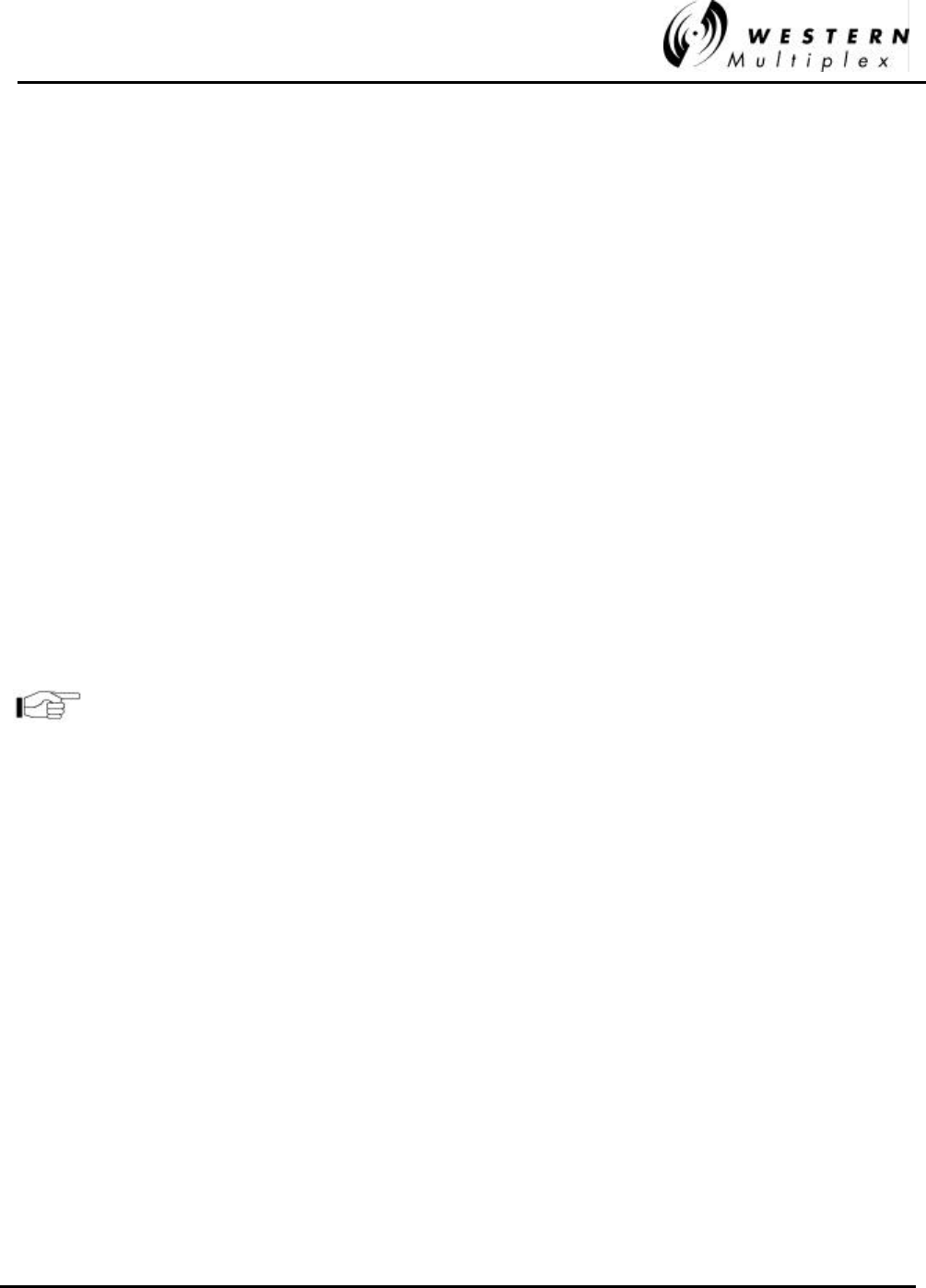
INSTALLATION AND MAINTENANCE MANUAL
Tsunami FAMILY
GIGABIT ETHERNET WIRELESS BRIDGES
JANUARY 2001
SECTION 2: PRODUCT DESCRIPTION PAGE 2-1
2. Product Description
2.1 General Description
The Tsunami licensed radios provide high capacity transmission and operational convenience in a digital
communications network.
These Tsunami radios provide 1000BaseF intelligent bridging between two fixed coordinated locations.
Because each owner controls the operation of the link, there is no reliance on any outside services.
Tsunami radio operators are able to operate whenever needed, and to be in control of their own
network.
The Tsunami offers two primary benefits:
v CONVENIENCE Easy to install and operate with a user license
coordinated in the USA. (Other countries may also require
a user license and/or frequency coordination).
v CAPABILITY Full transparent Fast Ethernet connections with no
throughput reduction over any line-of-sight distance (within
legal limits of government regulation)
Tsunami radios are ISO Layer 2 Data Link Layer (use MAC address for filtering) devices where
they provide their full stated throughput. At level 2 (bridges) or 3/4 (routers) where hardware plays
the major part, the most common tester is the SmartBits 200 product from NetCom Systems. At
Application Layer 7, you will see less than 40% throughput from the maximum capacity measured with
SmartBits due to the increased protocol/software overhead at that level. Layer 7 can be tested with
software such as Ganymede's Chariot or Qcheck product (www.qcheck.net/index.html). Use Qcheck (or
equivalent), do NOT use PING for throughput testing (www.qcheck.net/whyqcheck.html)!
As an example: testing copper CAT5e cable with SmartBits will test 100% throughput (let's say you can
send/receive a full 100Mbps). At Layer 7 you will be transferring bits at the 100Mbps rate, but
approximately only 45Mbps of user data will transfer (Ethernet has a high overhead of bytes added to
each data packet frame each time you go up a layer). The advantage is the more complex overhead
makes the data virtually resilient to corruption and minor errors (i.e. collisions), it’s easy to reroute and
the network can use inexpensive plug/play devices like hubs/switches instead of multiplexers as used in
the telco industry (i.e. LYNX T1/E1/DS3 radios)
Western Multiplex tests for stated throughput at Layer 2/3 where bridges are defined. At layer 7
(application layer), you may see less than 50% or more depending on the other traffic that may be on
the LAN as this layer is more dependent on the type of data being sent (it does not matter if it's wire,
fiber or any Ethernet bridge -wired or wireless). Another way to look at it: the model 31145 12Mbps
(10Mbps 10BaseT+T1/E1 wayside) bridge will test the same as a piece of CAT5e Ethernet cable.
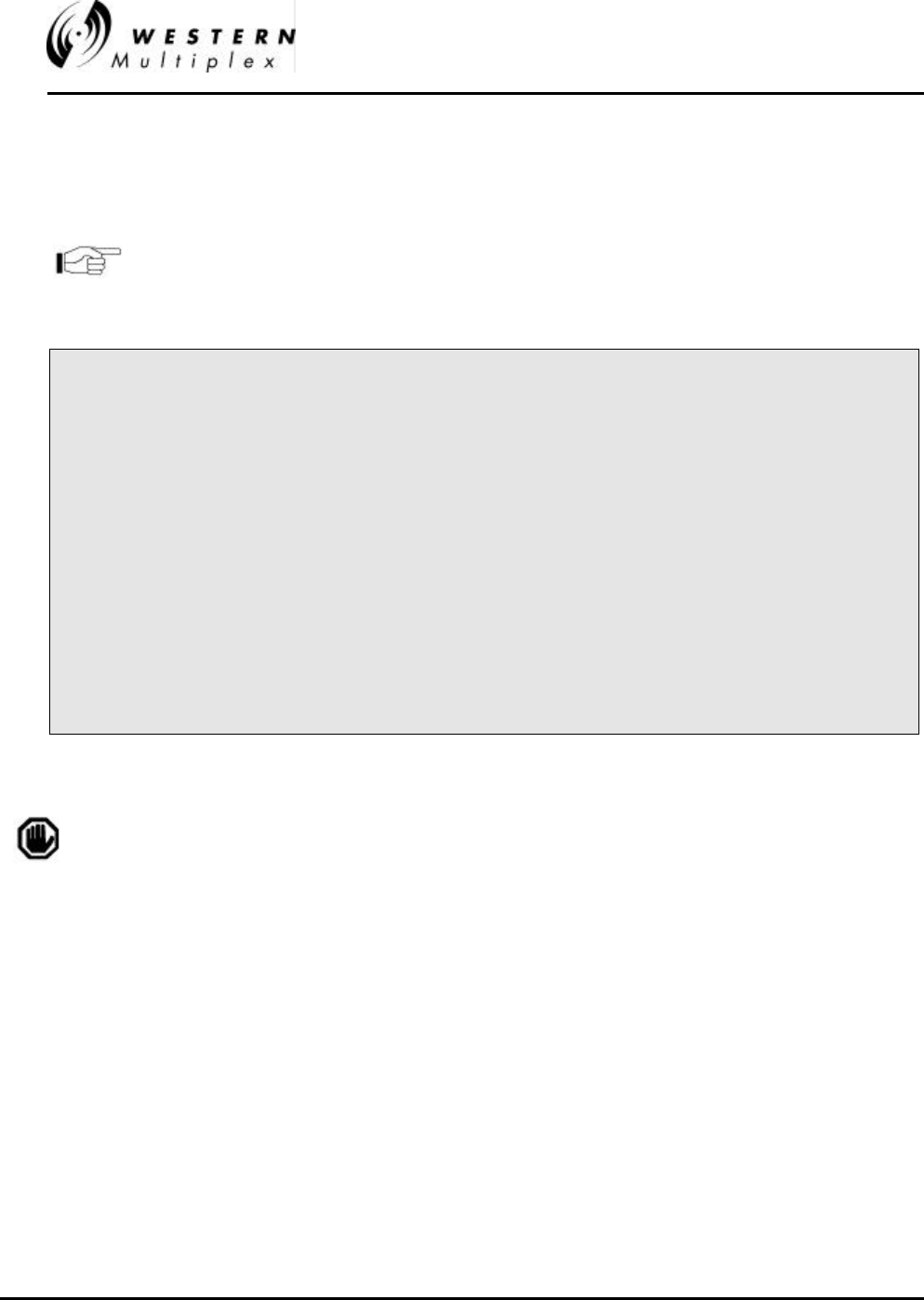
INSTALLATION AND MAINTENANCE MANUAL
Tsunami FAMILY
GIGABIT ETHERNET WIRELESS BRIDGES
JANUARY 2001
PAGE 2-2 SECTION 2: PRODUCT DESCRIPTION
2.2 Specifications
All specifications are subject to change without notice.
2.2.1 Transmitter
Frequency Selection A1 channel model 272XX-G1A1 (center frequency Tx=5775)
A2 channel model 272XX-G1A2 (center frequency Tx=5300)
Frequency Range 5250 – 5350 MHz (100MHz BW)
5725 – 5825 MHz (100MHz BW)
Output Power +10 dBm (5.3 GHz band)
+17 dBm (5.8 GHz band)
(Note: output power is specified as guaranteed minimum before attenuation)
Control Range 16 dB min (at ODU)
DO NOT exceed the maximum transmit power setting as set at the factory!
Exceeding the factory-set power level will degrade the specifications of the
radio and may also violate regulatory compliance. Output power may be
attenuated from factory setting to comply with regulatory EIRP limits.

INSTALLATION AND MAINTENANCE MANUAL
Tsunami FAMILY
GIGABIT ETHERNET WIRELESS BRIDGES
JANUARY 2001
SECTION 2: PRODUCT DESCRIPTION PAGE 2-3
2.2.2 Antenna / Antenna Coupling Unit
Mechanics OutDoor Unit (ODU) attached to antenna
w/two short coax cables
InDoor Unit (IDU)attached to ODU via two (2) coax cables
Antenna Connection Dual ‘N’ female connectors (H and V polar connections)
Impedance 50 ohms
Recommended 2 to 8 foot or 1.5 to 2 foot flat panel
Gain & Beamwidth (3 dB)
1.5 ft Flat 25.5 dB / 8°
2 ft Flat 28 dB / 4.6°
2 ft Parabolic 28.5 dB / 6°
4 ft Parabolic 35 dB / 3°
6 ft Parabolic 38 dB / 2.9°
2.2.3 Receiver
All Models
Nominal Receive Level -30 to -68 dBm
Maximum Receive Level -10 dBm error free, 0 dBm no damage
Frequency Selection None-use A1 or A2 models
Threshold Rx Level (typ.) -70 dBm
(BER = 10-6)
Frequency Range 5250 – 5350 MHz (100MHz BW)
5725 – 5825 MHz (100MHz BW)
Bandwidths ~97MHz per channel per polarization
RSL Voltage 0.00 to 1.00 VDC (approximate RSL calculated by
multiplying voltage times 100 and changing sign to
negative value (example: 0.56vdc = –56dBm)
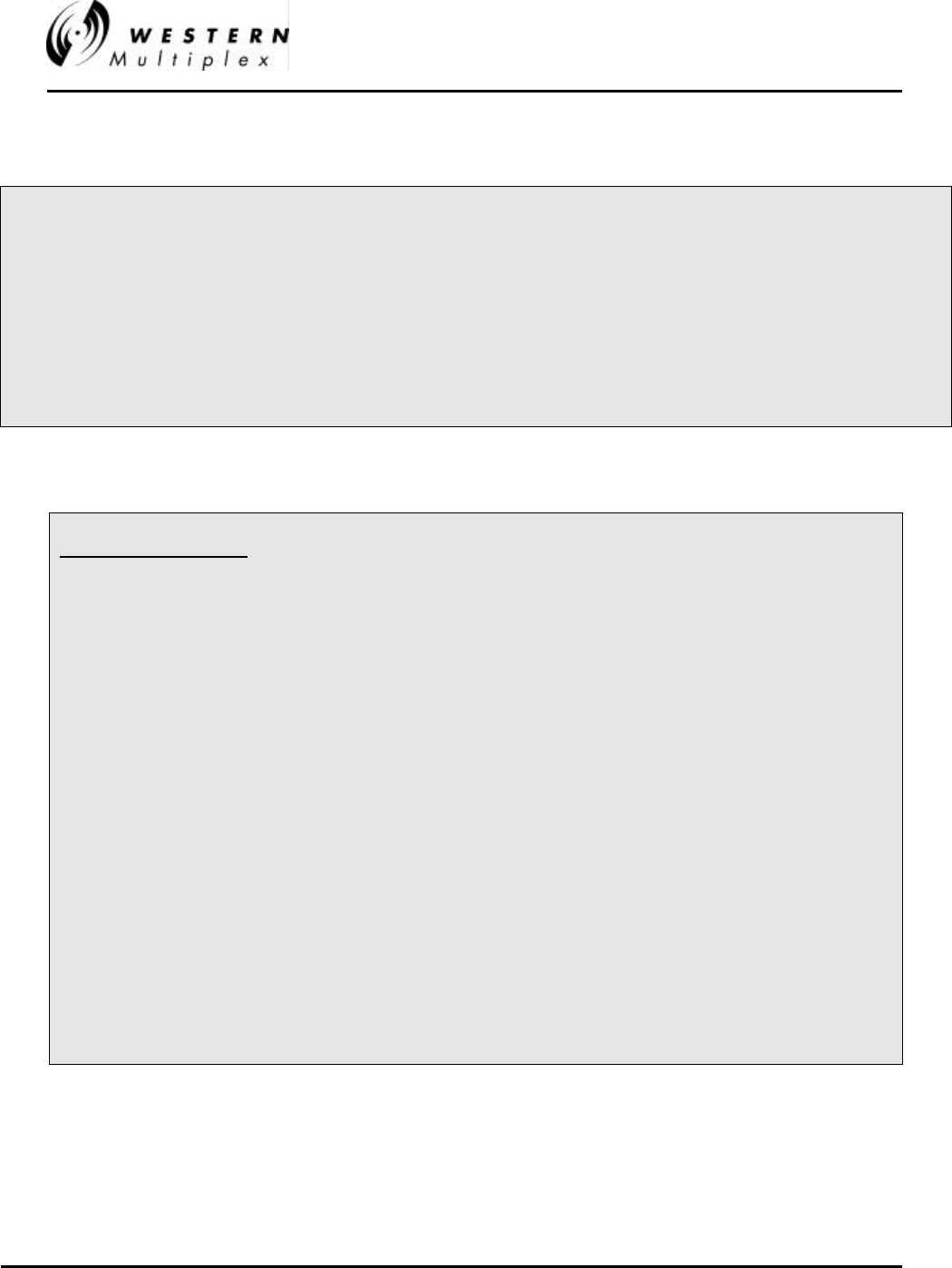
INSTALLATION AND MAINTENANCE MANUAL
Tsunami FAMILY
GIGABIT ETHERNET WIRELESS BRIDGES
JANUARY 2001
PAGE 2-4 SECTION 2: PRODUCT DESCRIPTION
2.2.4 System (Single Hop Performance)
Error Floor 10-11
Transmission delay
(radio only) 250 µsec, maximum
(10 mile path) 300 µsec, maximum
2.2.5 Line Interfaces
Gigabit Ethernet Port:
Data Interface 1000BaseF (fully compatible with IEEE 802.3u)
VPN (IEEE 802.1q) Ethernet port forces the sending device to break up jumbo frames into legal
Ethernet frames that do not exceed the 1538 byte limit.
In both cases, 802.1q frames are passed through the bridge (IEEE 802.1d)
Connectors SC (fiber) 1300nm multimode to 2000m
Configuration Full duplex on the WAN interface
Filtering 15,000 packets per second theoretical, before forwarding
Buffer 400 packets
LAN Table 1,024 MAC addresses
Self-learning Automatic learning and aging
Digital Capacity 480 Mbps Model: ~486 Mbps full duplex (>960 Mbps total)
(ISO Layer 2) 720 Mbps Model: ~726 Mbps full duplex (>1440 Mbps total)

INSTALLATION AND MAINTENANCE MANUAL
Tsunami FAMILY
GIGABIT ETHERNET WIRELESS BRIDGES
JANUARY 2001
SECTION 2: PRODUCT DESCRIPTION PAGE 2-5
DS-1 (T1) Port:
Data Rate 1.544 Mbps (each of four ports)
Digital Interface * 4 x DSX-1
Connector 8-pin modular jack female (RJ-48C) Pins:1=TT, 2=TR, 4=RT & 5=RR
Line Code AMI / B8ZS (NMS selectable)
Line Build Out 0-660 feet (NMS selectable)
Blue Code ** Alarm Indication Signal (AIS)
Loopback Near or far end (NMS selectable)
* Meets AT&T Pub 62411, Bellcore TR-TSY-000499.
** Signal is selectable (on/off) and is generated only on data loss or link failure when enabled.
2.2.6 Auxiliary Connections
Orderwire Interface 2-wire, 4-pin modular jack, female (RJ-11)
REN (Ringer Equivalency Number) 1.0 B
DTMF tones within ±1.5% of nominal freq. (+0-6 dB)
Ringing Voltage 48 VDC, typical
(use telephones with solid state ringers, NOT adequate for older style mechanical ringers)
VF Orderwire Bridge 600 ohm balanced, 4-wire, 0 dBm, DB-9, male
Diag-nostic Port RS-232, DB-9, male
Aux Data (clear service channel) RS-232, ≤9600 baud, DB-9, female
Alarm 2 x Form C, DB-9, female
Test Points Output Power
Near-end and far-end received signal level (RSL)
100BaseT or F NMS Ethernet Port:
Data Interface 100BaseT or 100BaseF
Connectors RJ-45/48c (wire) Pins:1=Tx+, 2=Tx-, 3=Rx+ & 6=Rx-

INSTALLATION AND MAINTENANCE MANUAL
Tsunami FAMILY
GIGABIT ETHERNET WIRELESS BRIDGES
JANUARY 2001
PAGE 2-6 SECTION 2: PRODUCT DESCRIPTION
2.2.7 Temperature and Environment
Operating Temperature Range (IDU) -10 to +50°C
Operating Temperature Range (ODU) -30 to +60°C
Humidity 95% non-condensing
Altitude 4,500 meters, maximum
2.2.8 Power
DC Input Voltage ±37 to ±63 VDC
Power Consumption ~150 Watts
Connector Barrier strip, plug-in type
2.2.9 Regulatory Information
FCC Identifier HZB-U5358-480 HZB-U5358-720 HZB-U5358-1000
FCC Rule Parts 15.407 (UNII) 15.407 (UNII) 15.407 (UNII)
Industry Canada ID TBD TBD TBD
IC Rule Parts RS-210 (LE-LAN) RS-210 (LE-LAN) RS-210 (LE-LAN)
2.2.10 Mechanical
Width (for 19-inch EIA 437 mm (17.2") rack mounting brackets supplied
rack mounting)
Height (IDU) 44.5 mm (1.75") (1RU)
Depth 304 mm (12")
Weight (IDU) 3 kg. (6.7 lbs.) ODU w/o Antenna 5.2 kg. (11.4 lbs.)
2.3 Front Panel Description
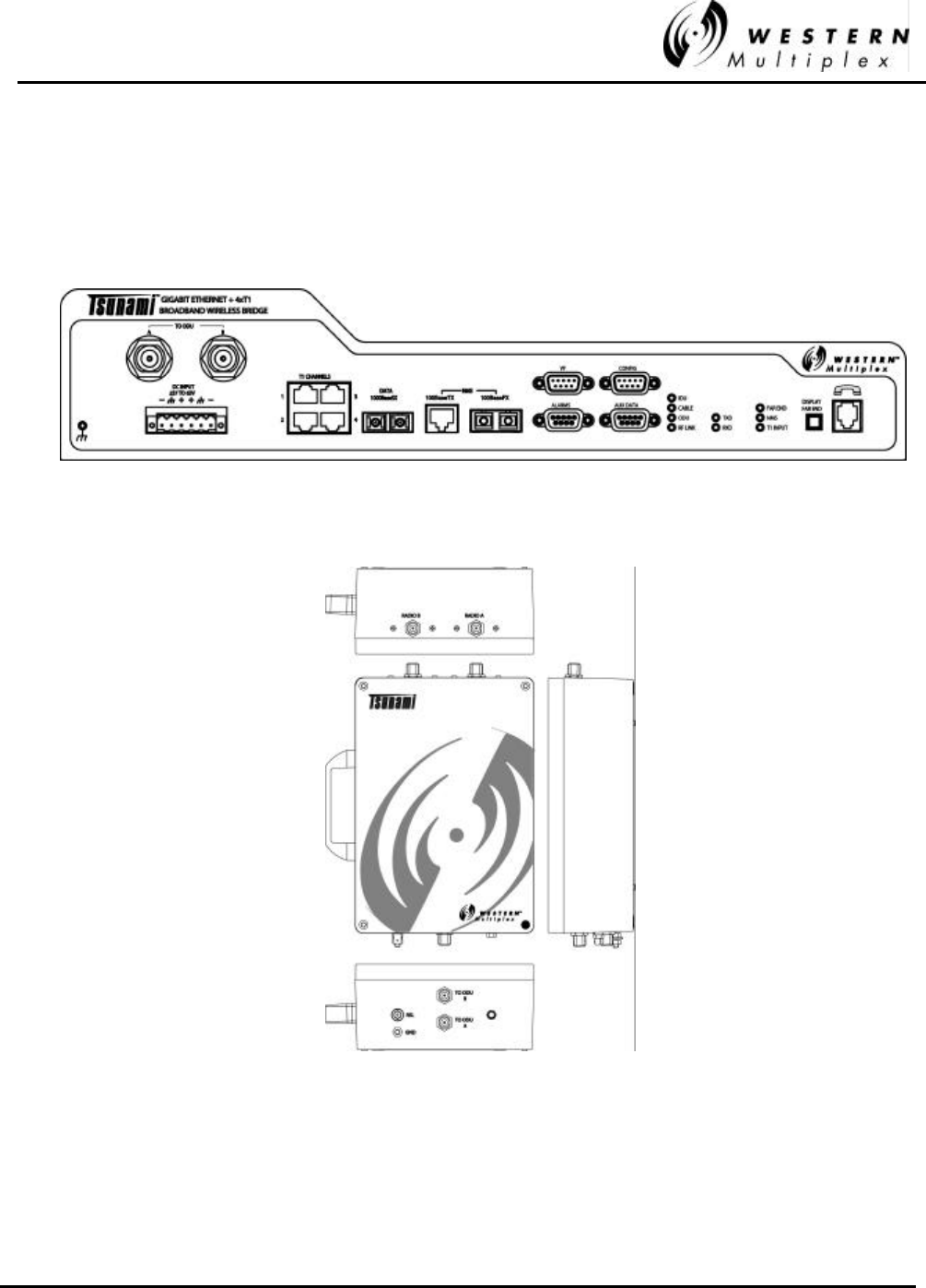
INSTALLATION AND MAINTENANCE MANUAL
Tsunami FAMILY
GIGABIT ETHERNET WIRELESS BRIDGES
JANUARY 2001
SECTION 2: PRODUCT DESCRIPTION PAGE 2-7
2.3.1 General
The Tsunami radio front panel (no user access on rear panel), as shown in Figure 2-1, has LED
indicators, test points, controls and connections that are used for installation, maintenance, operation
and troubleshooting. Prior to installation, it is best to be familiarize yourself with the front panel of your
particular model. Sections 2.3.2 through 2.3.5 briefly describe the front panel access and indicators.
Figure 2-1: IDU Front Panel
Figure 2-2: ODU
(Shown without antenna attached)
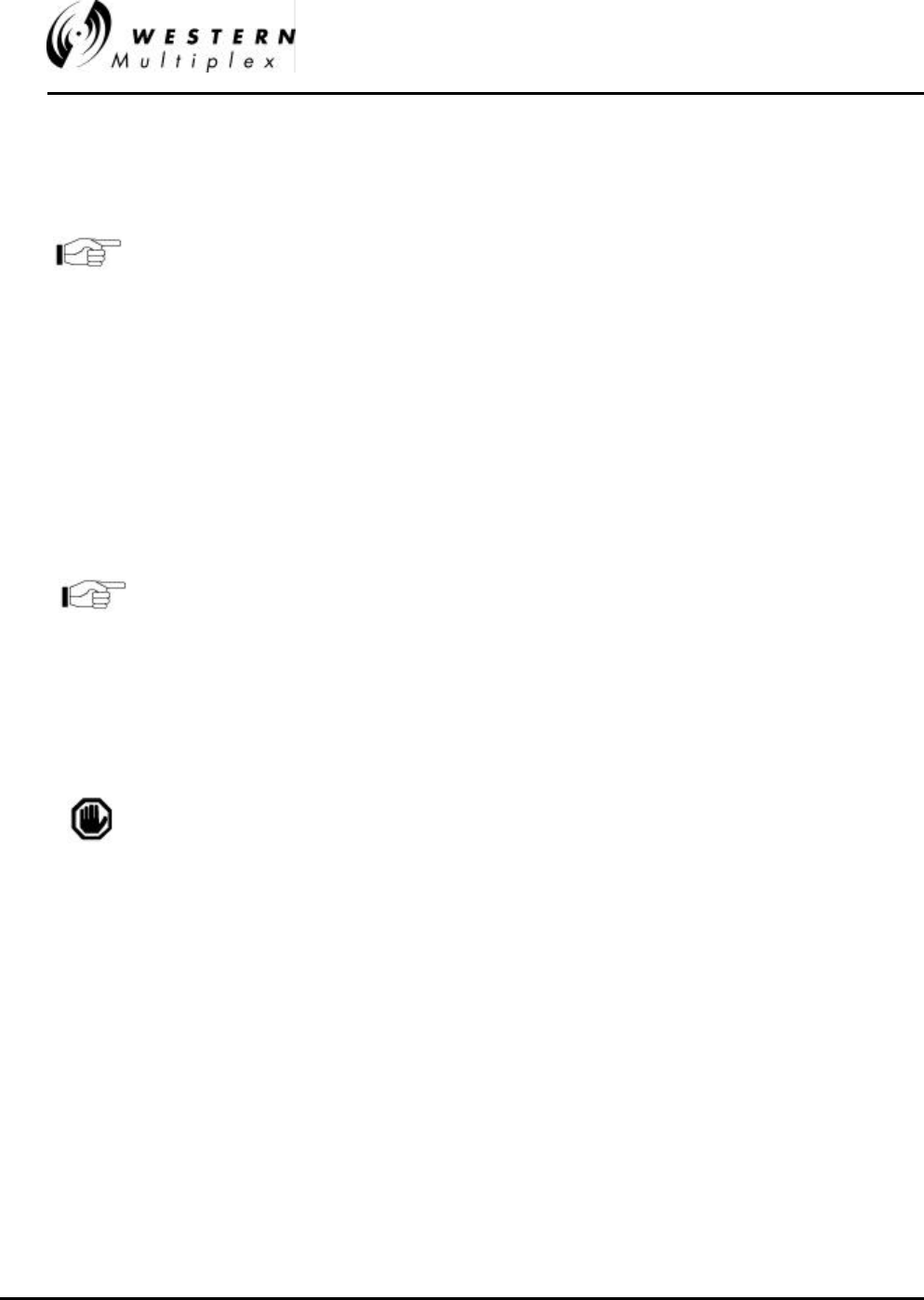
INSTALLATION AND MAINTENANCE MANUAL
Tsunami FAMILY
GIGABIT ETHERNET WIRELESS BRIDGES
JANUARY 2001
PAGE 2-8 SECTION 2: PRODUCT DESCRIPTION
2.3.2 Test Points on ODU
The Tsunami radio products do not have an on/off switch.
GND This is a grounding post to connect to earth ground.
RSL This is a test point (BNC connector) that relates to the Received Signal Level (RSL).
The voltage is measured with a voltmeter (using the GND test point for reference)
which corresponds to the actual power level of the incoming received signal.
This is a test point which corresponds to the output transmit power of the radio. The
voltage is measured with a voltmeter (using the GND test point for reference) which
corresponds to the actual power level of the outgoing signal. This measurement is
used during installation, maintenance and troubleshooting
.This voltage only applies to the near-end and does not allow measurement
of the far-end output transmit power, even when the DISPLAY FAR END
button is pressed.
There is a receptacle on the front panel to the right of the LOCAL TX PWR test point
which is an installation adjustment allowing the output transmit power to be
increased or decreased within the radio's specified limits. Using a small screwdriver,
this adjustment is used to set the output power of the transmitter, in accordance to
the path planning.
The Tsunami system requires professional installation. Transmitted output
power limits may apply when using this radio. Consult FCC, IC, Western
Multiplex or other regulatory authorities for limits which may apply. See
Section 3.13.1 for details on setting output power. Do not adjust output
power above factory settings.

INSTALLATION AND MAINTENANCE MANUAL
Tsunami FAMILY
GIGABIT ETHERNET WIRELESS BRIDGES
JANUARY 2001
SECTION 2: PRODUCT DESCRIPTION PAGE 2-9
2.3.3 Alarm and Status Indicators
IDU Green = Indoor Unit OK
Red = Indoor Unit detected hardware failure
Cable Green = ODU Cable OK
Red = ODU Cable shorted
ODU Green = Outdoor Unit OK
Red = Outdoor Unit detected hardware failure
Radio Fail Green = Radio hardware OK
Red = Hardware failure detected
RF Link Green = Error-free operation
Yellow = Bit errors occurring
Red = Excessive bit errors or radio link failure
Flashing = Link security ID mismatch
TXD Green = 100BaseT data transmit present
Yellow = 100BaseT port connected (no data present)
Off = No 100BaseT connection detected
RXD Green = 100BaseT data receive present
Yellow = 100BaseT port connected (no data present)
Off = No 100BaseT connection detected
COLL Yellow = Collisions occurring on 100BaseT (half-duplex mode)
FAR END Red = Alarm(s) present on the far-end radio**
NMS (100Base) Green = Tx or Rx data present on the NMS interface
Yellow = NMS interface connected (no data present)
Off = No NMS interface connection detected
T1 INPUT Green = Alarm enabled and T1 connection detected
Red = Alarm enabled and no T1 connection detected
Yellow = Alarm disabled and T1 connection detected
Off = Alarm disabled and no T1 connection detected
** Radio Fail, RF Link (yellow or red), T1 Input (yellow or red)

INSTALLATION AND MAINTENANCE MANUAL
Tsunami FAMILY
GIGABIT ETHERNET WIRELESS BRIDGES
JANUARY 2001
PAGE 2-10 SECTION 2: PRODUCT DESCRIPTION
2.3.4 Controls
DISPLAY
FAR END This push-button provides the capability to determine alarms and status of the far-
end radio. When pressed and held, the alarm and status LEDs correspond to the
far-end radio’s status. This can be used for installation, maintenance and
troubleshooting. When the LED on this switch is flashing, no far-end information is
available. This typically indicates that there is no link between near-end and far-end
radios.
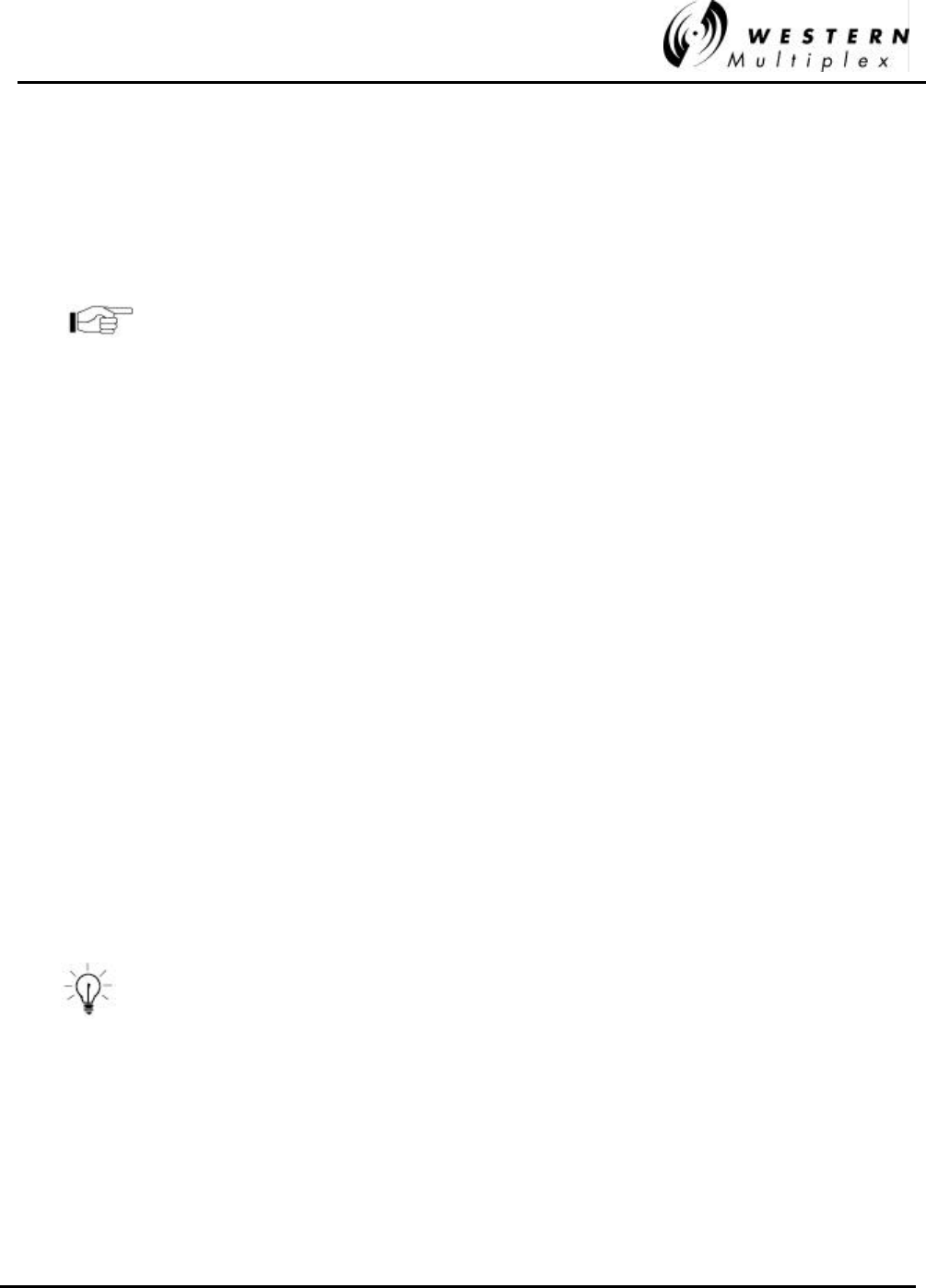
INSTALLATION AND MAINTENANCE MANUAL
Tsunami FAMILY
GIGABIT ETHERNET WIRELESS BRIDGES
JANUARY 2001
SECTION 2: PRODUCT DESCRIPTION PAGE 2-11
2.3.5 Connections
RF CONNECTION
The RF port of this Tsunami radio is an N-type female connector that is used to connect to the ODU
using coaxial transmission line.
Use LDF4-50, LMR-400 or equivalent up to 100 meters (300 ft.)
Use LDF4.5-50, LMR-600 or equivalent up to 300 meters (1000 ft.)
.
DATA CONNECTION
The connection for the Gigabit Ethernet interface that carries the signals in and out of the radio is an SC
type 1000BaseF fiber connection.
DC POWER CONNECTION
The input accepts positive or negative DC power at any voltage between 37 and 63 Volts.
OPTIONAL CONNECTIONS
There are several connections that are not required for operation, but provide additional facilities to the
user.
EOW
VF
This connection is used to access the electronic orderwire function. This is a facility
for "telephone" style service from one radio to another. A standard electronic
telephone [one with a handset and DTMF (push-button tone) dialing] plugs into this
connector. The user can dial the orderwire address of the far-end radio (or any radio
in the Tsunami network) to establish telephone communication between sites. This
communication does not interrupt or interfere with the other radio communications.
The radio link must be operational to use this facility. The orderwire feature can be
very useful for installation, maintenance and troubleshooting.
This connector is used to link two Tsunami radios at a repeater site for Orderwire
operation. This would allow orderwire "telephone" calls to and from any point in the
Tsunami network.
The Tsunami orderwire circuit can also be connected to other existing
orderwire networks. See Section 3.14.1 for details.
ALARM This connector is used for monitoring alarms electrically. The Form C relays can be
connected to other transmission equipment for monitoring alarm status locally or
remotely.
DIAG This is a serial interface port (RS-232) to the Tsunami radio. This port provides
configuration and maintenance information about the Tsunami radio(s) to a

INSTALLATION AND MAINTENANCE MANUAL
Tsunami FAMILY
GIGABIT ETHERNET WIRELESS BRIDGES
JANUARY 2001
PAGE 2-12 SECTION 2: PRODUCT DESCRIPTION
connected computer or terminal. See section on TELNET session in this manual.
AUX
DATA This is a serial interface port (RS-232, ≤9600 baud) which allows the user to connect
auxiliary serial data from one point in the radio network to another. It can be used for
separate data connection for serial devices.
100Base
NMS This is an Ethernet connection for access to the Tsunami NMS (SNMP or HTML).
See section 4.11 for more detail for operation.
T1 This is a wayside data channel for T1 (DS-1) interface of auxiliary
traffic (27400-51 Models).

INSTALLATION AND MAINTENANCE MANUAL
Tsunami FAMILY
GIGABIT ETHERNET WIRELESS BRIDGES
JANUARY 2001
SECTION 2: PRODUCT DESCRIPTION PAGE 2-13
2.4 Rear Panel Description
The Tsunami radio rear panel, is blank. All connections and indications are on the front panel for “single
panel” access

INSTALLATION AND MAINTENANCE MANUAL
Tsunami FAMILY
GIGABIT ETHERNET WIRELESS BRIDGES
JANUARY 2001
PAGE 2-14 SECTION 2: PRODUCT DESCRIPTION
2.5 Installation Accessories
The Tsunami radio is shipped with several accessories commonly required for the radio as described
below:
Rack Mount
Brackets Two brackets (along with required mounting screws) are provided which allow 19-
inch rack mounting of the Tsunami radio.
Terminal
Connector This is a 6-pin mating connector used for DC power supply.
D
Connector
9-pin
Four of these mating connectors are provided. One is used for the VF port, one for
the CONFIG port, one for the ALARMS port and one for the AUX DATA port.
Other accessories are available, such as orderwire handsets, connector adapters and special cables.
These can be ordered separately upon request.
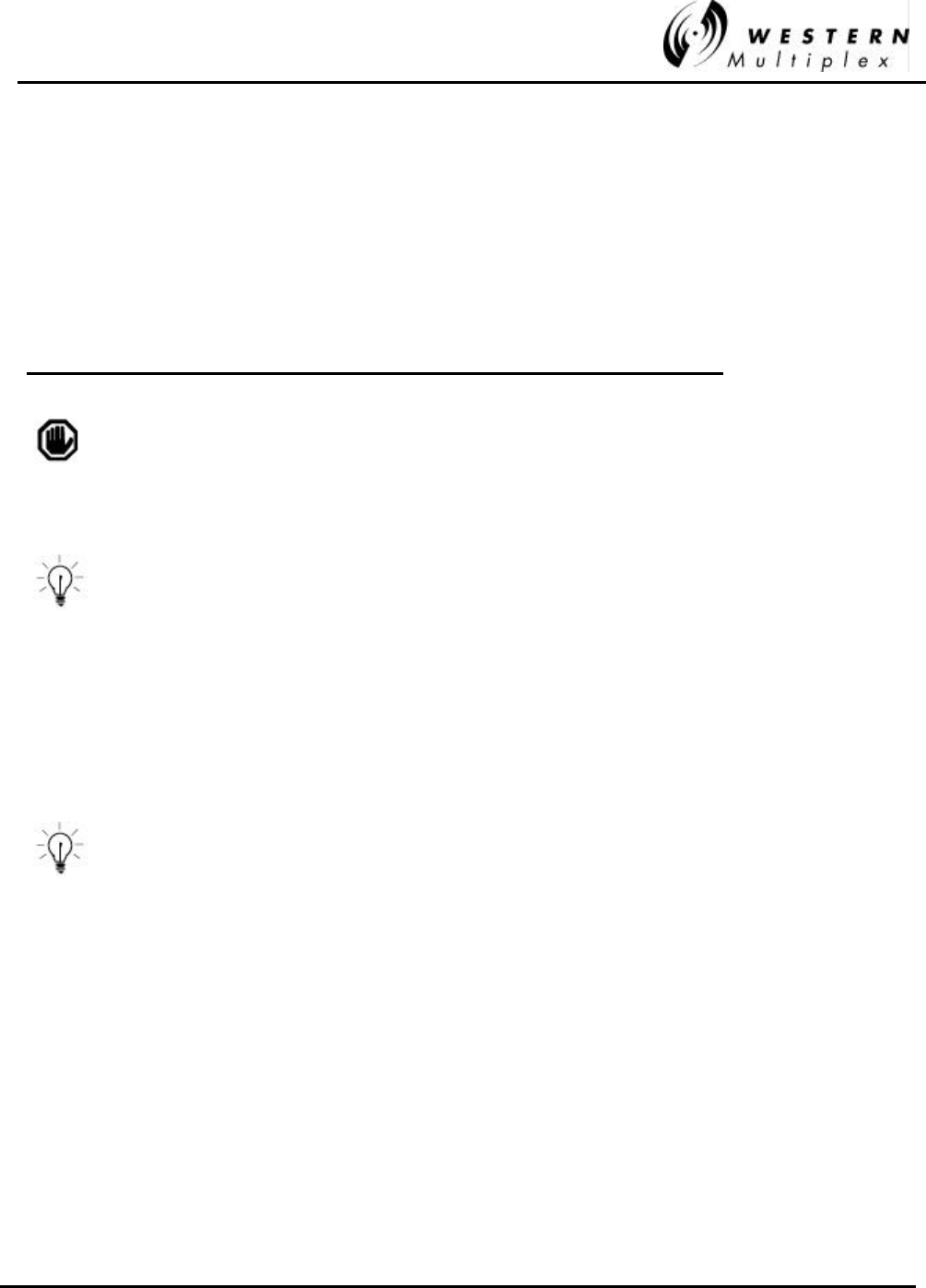
INSTALLATION AND MAINTENANCE MANUAL
Tsunami FAMILY
GIGABIT ETHERNET WIRELESS BRIDGES
JANUARY 2001
SECTION 3: INSTALLATION & ADJUSTMENTS PAGE 3-1
3. Installation & Adjustments
3.1 Shipping Container
The equipment is shipped in boxes unless ordered as an integrated system and configured at the
factory, in which case the equipment may be racked and shipped in a crate. The equipment is
packaged so as to prevent damage in transit.
The boxes should be left intact and sheltered until arrival at the installation site.
If the shipping container shows signs of damage, the transportation
company should be notified immediately. Extra care and inspection
of the contents is advised immediately upon receipt.
It is recommended that all the packaging materials be retained.
In the unlikely event that the equipment must be returned to the
factory, use the original packing materials for return shipment. The
original packaging materials are also recommended for
transporting the equipment from location to location.
Inside the primary shipping containers, internal boxes may contain other items. These boxes should
also be saved for future use.
Also, save the Tsunami radio test data sheet that is provided. The
test data sheet can be placed where the Tsunami terminal will be
installed for future quick reference. All Tsunami units are individually
tested and the actual measured performance recorded on the
Factory Test Data Sheet. You will find this information to be of use
during installation, troubleshooting and maintenance.
A set of “quick installation instructions” is also provided which can be useful for easy reference during
installation.

INSTALLATION AND MAINTENANCE MANUAL
Tsunami FAMILY
GIGABIT ETHERNET WIRELESS BRIDGES
JANUARY 2001
PAGE 3-2 SECTION 3: INSTALLATION & ADJUSTMENTS
3.2 Packing Items Identification
The primary shipping container houses the radio along with other items including:
vThis manual
vInstallation accessory kit (see Section 2.5)
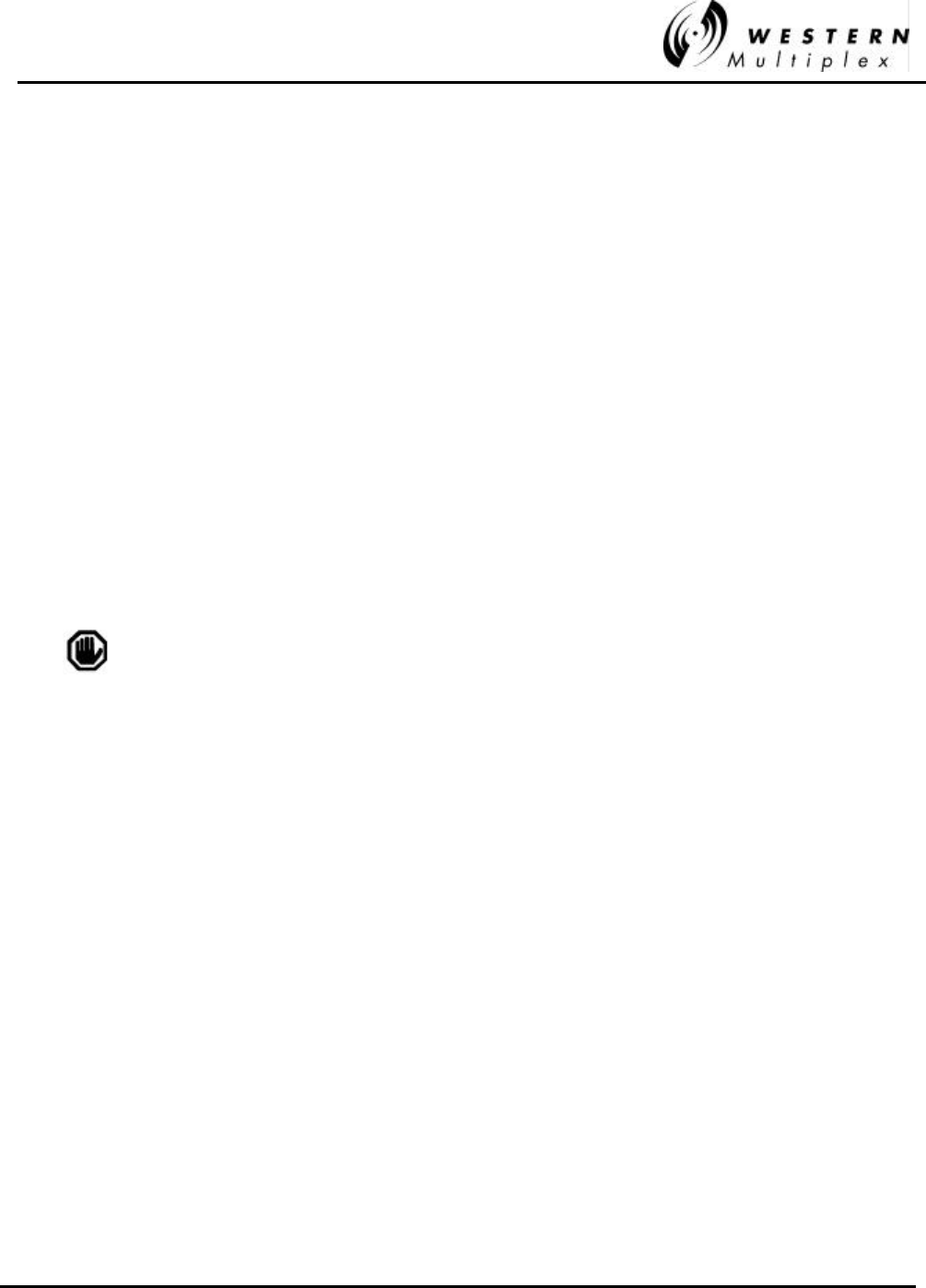
INSTALLATION AND MAINTENANCE MANUAL
Tsunami FAMILY
GIGABIT ETHERNET WIRELESS BRIDGES
JANUARY 2001
SECTION 3: INSTALLATION & ADJUSTMENTS PAGE 3-3
3.3 Before Installation Task List
There are several tasks that should be accomplished prior to installing the Tsunami radio system. This
section briefly describes the following:
- Site selection
- Line-of-Sight and Path Clearance determination
- Anticipated RSL calculation
- Fade margin calculation
- Availability calculation
- Frequency plan determination
- Power supply planning
- Antenna (and accessories) purchase
Only directional antennas should be used with Tsunami radios.
These are typically flat panel or solid parabolic antennas. Western
Multiplex recommends a maximum beamwidth of 10 degrees for
directional systems.
3.3.1 Site Selection Requirements
The radio site must have:
- access to the appropriate power
- close proximity to the telephone or computer system you wish to interconnect
- line-of-sight to the other radio location with adequate clearance
- location for mounting the antenna

INSTALLATION AND MAINTENANCE MANUAL
Tsunami FAMILY
GIGABIT ETHERNET WIRELESS BRIDGES
JANUARY 2001
PAGE 3-4 SECTION 3: INSTALLATION & ADJUSTMENTS
3.3.2 Line-of-Sight and Path Clearance Guidelines
The Tsunami radios will not operate properly unless they have line-of-sight between their
corresponding antennas. The Tsunami radio transmission will not pass through trees or other
obstacles. Factors to consider include:
- Earth curvature
- Future growth of trees
- Height of buildings
In addition to the line-of-sight requirement, a well-engineered path will also have additional path
clearance to allow for signal loss due to partial obstructions, atmospheric ducting and ground
reflections. To maximize radio reception, 0.6 times the first Fresnel zone should be calculated and this
distance added to the path clearance (in addition to trees or buildings).

INSTALLATION AND MAINTENANCE MANUAL
Tsunami FAMILY
GIGABIT ETHERNET WIRELESS BRIDGES
JANUARY 2001
SECTION 3: INSTALLATION & ADJUSTMENTS PAGE 3-5
3.3.3 RSL Calculation and Link Budget
The received signal level (RSL) can be estimated using the following formula:
RSL (dBm) = Pout - FL1+ G1 + G2 - FL2 - Lp
where: Pout is the transmitter output power (in dBm)
FL1 is the feeder loss of the transmit side (in dB)
G1 is the gain of the transmit antenna (in dB)
G2 is the gain of the receive antenna (in dB)
FL2 is the feeder loss of the receive side (in dB)
Lp is the Path loss, defined by:
Lp (dB) = 96.6 + 20 log10F + 20 log10D
where: F = Frequency in GHz (2.4 or 5.8)
D = Distance of path in miles
This link budget is very important for determining any potential problems during installation. If you
have calculated the expected RSL, you can see if it has been achieved during installation, and
troubleshoot if necessary.

INSTALLATION AND MAINTENANCE MANUAL
Tsunami FAMILY
GIGABIT ETHERNET WIRELESS BRIDGES
JANUARY 2001
PAGE 3-6 SECTION 3: INSTALLATION & ADJUSTMENTS
3.3.4 Fade Margin Calculation
The fade margin is the difference between the actual received signal and the radio’s threshold. Using
the formula provided in Section 3.3.3, the anticipated RSL can be calculated. Compare this RSL to the
specified threshold of the Tsunami radio (shown in Section 2.2) and calculate the fade margin as the
difference between the two signal levels.
3.3.5 Availability Calculation
Availability of the microwave path is a measure of the percent of the time that the link will operate
without producing an excessive BER due to multipath fading. In the absence of direct interference,
availability is affected by the following:
- Path length
- Fade margin
- Frequency (5.8 GHz in the case of these Tsunami radios)
- Terrain (smooth, average, mountainous)
- Climate (dry, temperate, hot/humid)
Depending on the type of traffic carried over the link, the system designer may wish to design for a
specific availability. For example, if the data or voice traffic that is carried by the radio is critical then it
may be designed for a very high availability (e.g. 99.999% or 5.3 minutes of outage per year). To
improve availability, for example, the fade margin can be increased by making the path shorter, or by
using higher gain antennas.
1 mile 2 miles 3 miles 4 miles 5 miles 10 miles
1.5'
fade margin 46 40 36.5 34 N/R N/R
reliability 100 99.999 99.999 99.999
2.0'
fade margin 50.6 44.5 41 38.5 36.5 N/R
reliability 100 100 99.999 99.999 99.999
2.5'
fade margin 54.8 48.7 45.2 42.7 40.8 34.8
reliability 100 100 99.999 99.999 99.999 99.999
4.0'
fade margin 62.6 56.5 53 50.5 48.6 42.6
reliability 100 100 100 99.999 99.999 99.999
6.0'
fade margin 69.4 63.3 59.8 57.3 55.4 49.4
reliability
100
100
100
100
99.999
99.999
Table 3-A: Fade Margin & Availability Calculations
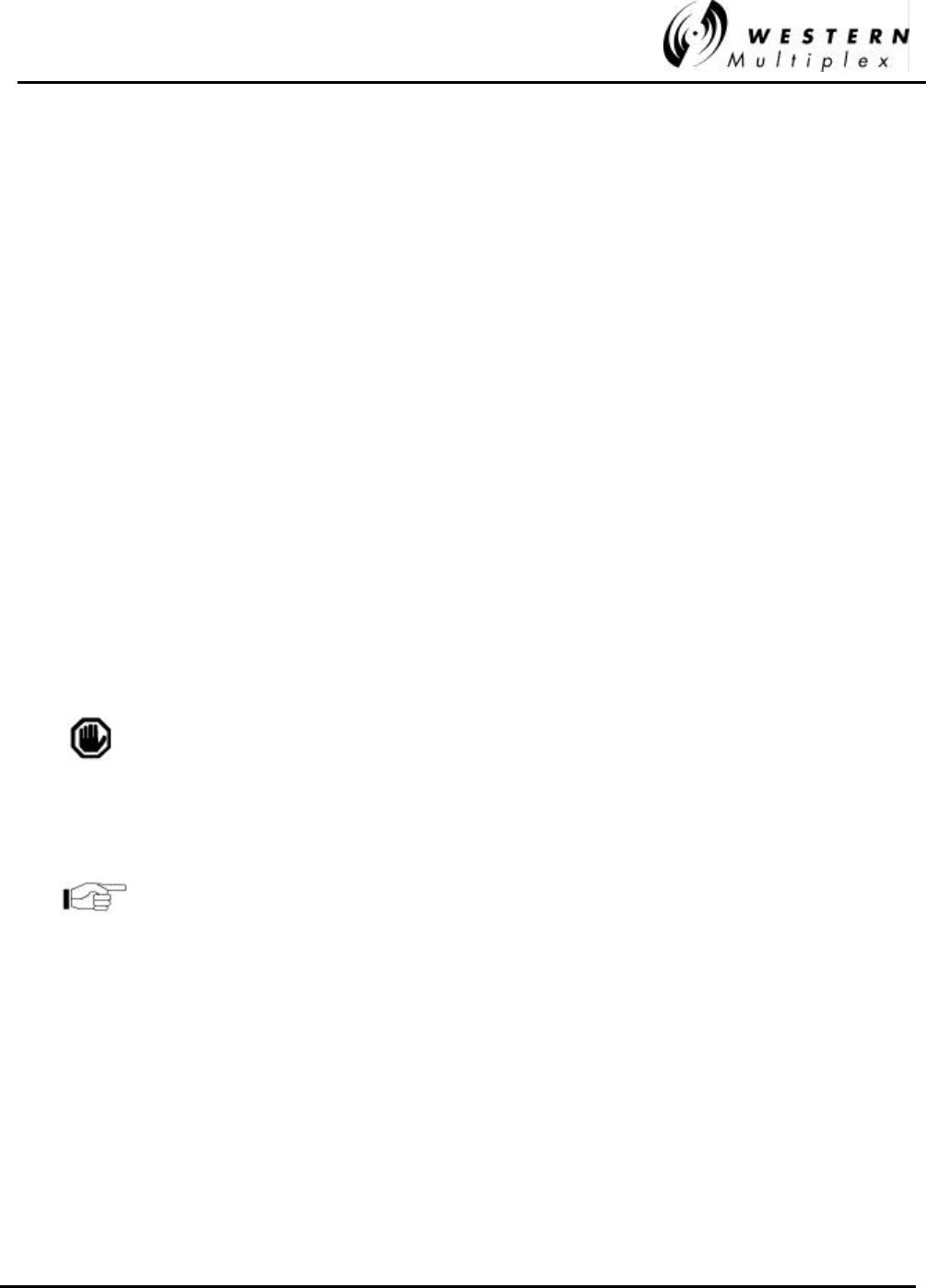
INSTALLATION AND MAINTENANCE MANUAL
Tsunami FAMILY
GIGABIT ETHERNET WIRELESS BRIDGES
JANUARY 2001
SECTION 3: INSTALLATION & ADJUSTMENTS PAGE 3-7
3.3.6 Power Supply Planning
The Tsunami radio must have access to a supply of appropriate DC power. The Tsunami can be
powered from a DC battery system, or from a solar or generator power plant, usually with battery
reserves. Typically either a positive or negative 48 volt supply is used. For DC, be sure the cable is of
sufficient gauge to carry the necessary current and it is less than three (3) meters (9.75 feet) in length.
Before installing the radio, plan for the continuous power consumption needs in accordance with the
specifications given in Section 2.2 of this manual. It is also wise to plan for backup power for critical
communication circuits (including the Tsunami radio). Backup power allows the radios and associated
equipment to continue operation when primary power is interrupted.
3.3.7 Antenna Planning
Using path planning mathematics, proper antenna size can be determined which will yield the desired
path performance. In general, the larger the antenna that is used with the Tsunami radio, the better
the link will perform. Larger antennas have narrower beamwidth and higher gain, which will yield better
link performance (higher fade margin, better availability) and improve immunity to interference (due to
the smaller beamwidths). However, larger antennas are more costly to purchase and install than
smaller antennas, in some cases requiring special equipment for installation. All of these factors
should be taken into consideration when selecting antennas.
In areas where transmitted output power restrictions apply, the use
of larger antennas will maintain the benefit of narrow beamwidths
and receive gain. However, output power may need to be reduced to
meet regulations. (See Section 3.13.1)
Prior to installation, the specific antenna location and mounting should be determined. This advanced
planning also yields the transmission line requirements.
Only dual-band/dual-polarized directional antennas can be used
with these Tsunami radios.

INSTALLATION AND MAINTENANCE MANUAL
Tsunami FAMILY
GIGABIT ETHERNET WIRELESS BRIDGES
JANUARY 2001
PAGE 3-8 SECTION 3: INSTALLATION & ADJUSTMENTS
3.4 Tools Required
The following tools may be required for the installation of the Tsunami radios:
- Phillips (cross tip) screwdrivers (for 19-inch rack mounting and attachment of brackets)
- Small blade standard screwdriver (for power supply connector and RF output power
adjust)
- Soldering iron (if using any D-type connectors)
- Wire strippers (for removing insulation from power supply and other wiring)
-Wire crimpers (if using any RJ-style connectors that are not pre-made)
- Digital Voltmeter (to measure RSL, Tx output power, Alarms)
The following tools are recommended for the installation of the Tsunami radios:
- RF power meter (to measure transmitter output power)
- Cellular phone or two-way radio (for talking with far-end crew and tower crew)
- Bit Error Rate test set (to test link after installation)
- Computer (for NMS access with 10BaseT interface and cable)
- Touch-tone Telephone* (to test orderwire circuits and for communication with far-end)
Additional tools will likely be needed for antenna and transmission line installation and antenna
alignment. Consult Sections 3.8 through 3.10 of this manual for more details.
*Telephone connection specifications:
REN (Ringer Equivalency Number) 1.0 B
DTMF tones within ±1.5% of nominal freq.
Ringing Voltage 48 VDC, typical
(Ringing voltage is adequate for modern solid state ringers,
NOT for the older mechanical type ringers)
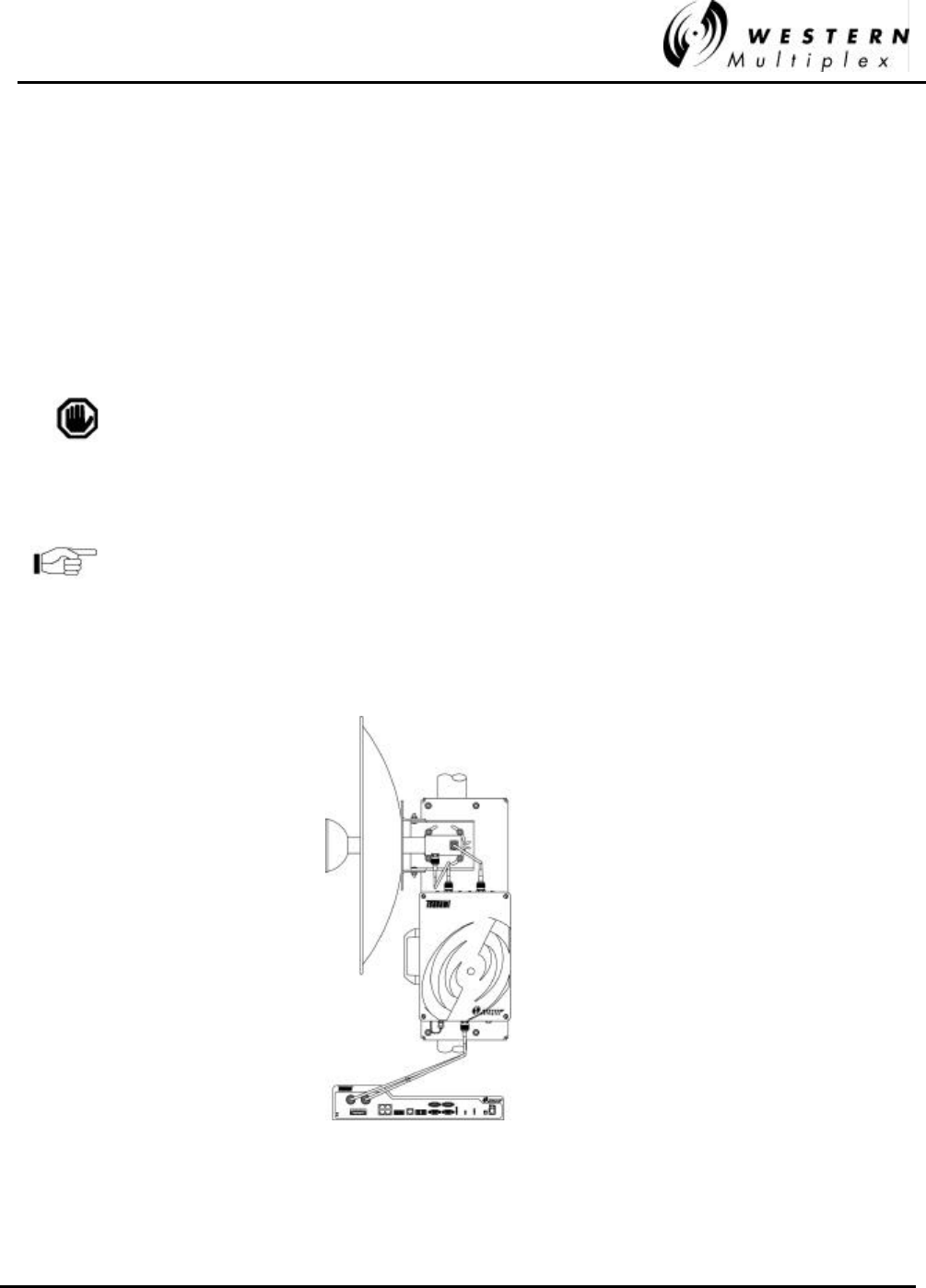
INSTALLATION AND MAINTENANCE MANUAL
Tsunami FAMILY
GIGABIT ETHERNET WIRELESS BRIDGES
JANUARY 2001
SECTION 3: INSTALLATION & ADJUSTMENTS PAGE 3-9
3.6 Mounting the Tsunami Radio
The Tsunami radio can be mounted at any height in a standard 19-inch rack. Blank rack-mounting
spaces above and below the Tsunami are recommended, especially if the surrounding equipment
dissipates a considerable amount of heat.
The Tsunami radio may be set up for mounting with the front edge projecting from the front face of a
standard 19-inch rack using the rack mounting brackets enclosed with the screws in the Accessory Kit
(4 per bracket). The rack mounting brackets may be reversed, in order to install for flush or cabinet
mounting if preferred. Depending on rack configuration, it may be necessary to remove the four
adhesive backed rubber feet on the bottom of the unit.
The Tsunami radio has internal fans which intake and exhaust on
the left and right sides of the chassis. When rack mounting, it is
important to leave a small gap between the outer edges of the
radio and the inside edge of the rack.
The Tsunami radio may alternatively be placed on a table or shelf
attached to a wall. Because of the low weight of the Tsunami, any
mounting option other than rack mounting will be less secure.
The ODU is mounted on a substantial mounting pole (minimum 2.5 inches) to accommodate the
supplied mounting bracket.
Figure 3-1: IDU and ODU Overview
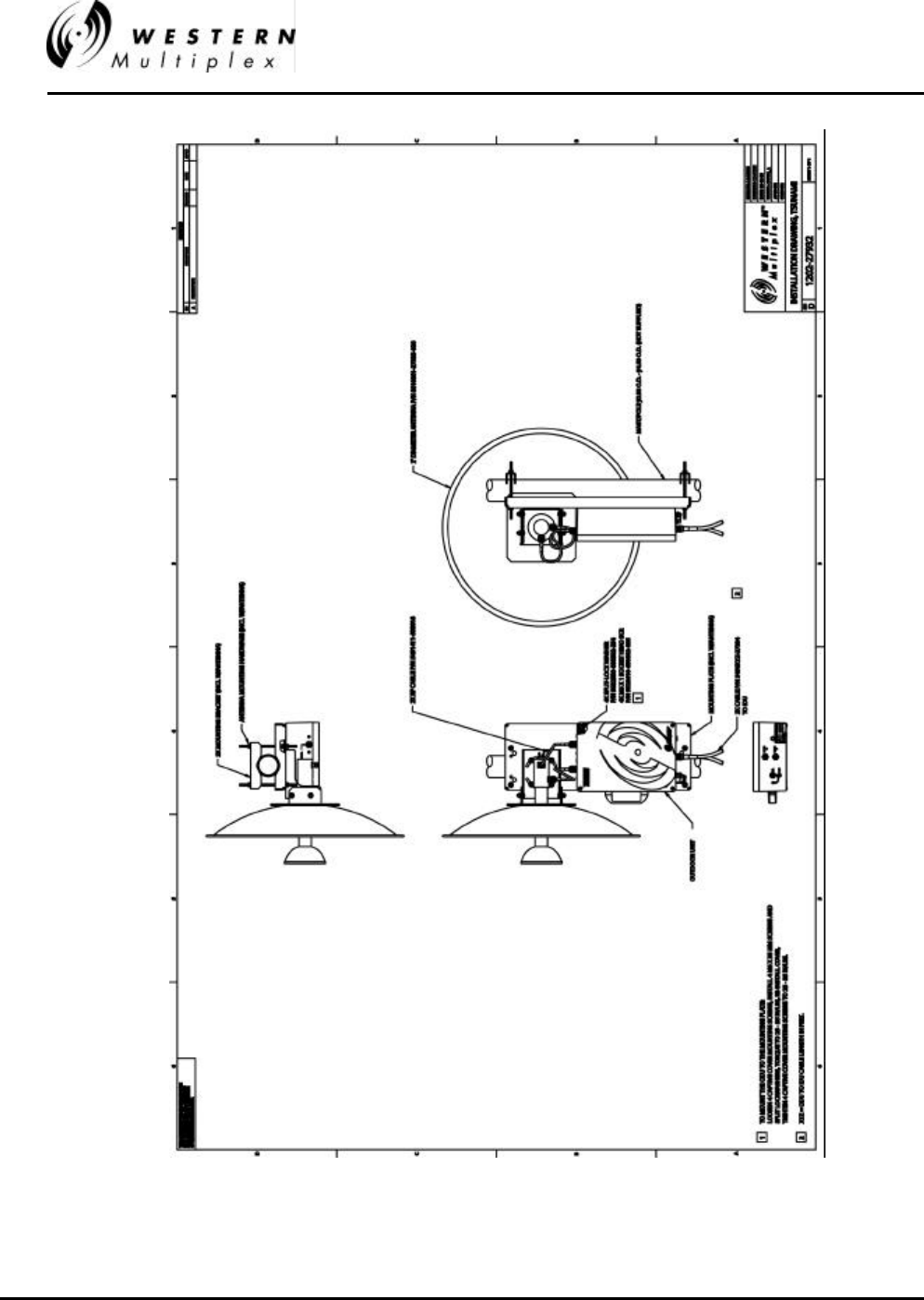
INSTALLATION AND MAINTENANCE MANUAL
Tsunami FAMILY
GIGABIT ETHERNET WIRELESS BRIDGES
JANUARY 2001
PAGE 3-10 SECTION 3: INSTALLATION & ADJUSTMENTS
Figure 3-2: ODU mount with Antenna Detail
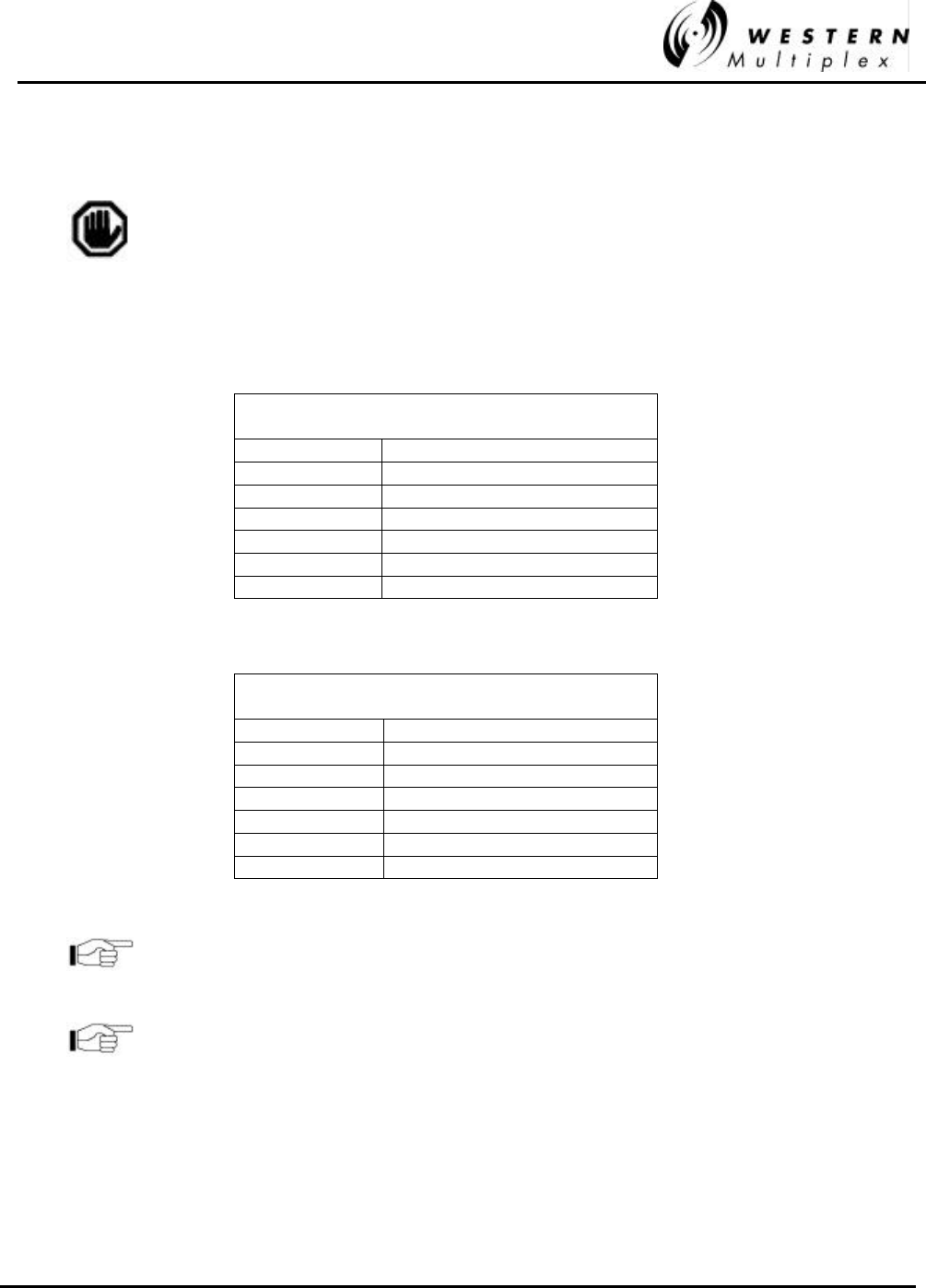
INSTALLATION AND MAINTENANCE MANUAL
Tsunami FAMILY
GIGABIT ETHERNET WIRELESS BRIDGES
JANUARY 2001
SECTION 3: INSTALLATION & ADJUSTMENTS PAGE 3-11
3.7 Power Connection and Wiring
There is no ON/OFF switch on the Tsunami. As soon as
power is applied, the equipment will be operational. This
means that there can be up to 1W of RF power present at the
antenna port. The antenna port should be terminated before
power is applied.
Power is connected using the DC power plug contained in the Accessory Kit. Use Table 3-B or 3-C
along with the associated diagram of Figure 3-3 or 3-4 to connect the DC power cables. For example,
for a negative DC power input, use Table 3-B and Figure 3-4.
NEGATIVE DC POWER INPUT
(–20 TO –63 VDC)
PIN FUNCTION
1Power (–DC)
2Ground (see figure 3-1)
3Return (+DC)
4Return (+DC)
5Ground (see figure 3-1)
6Power (–DC)
Table 3-B: DC Power Connection for Negative Supply
POSITIVE DC POWER INPUT
(+20 TO +63 VDC)
PIN FUNCTION
1Return (–DC)
2Ground (see figure 3-2)
3Power (+DC)
4Power (+DC)
5Ground (see figure 3-2)
6Return (–DC)
Table 3-C: DC Power Connection for Positive Supply
Pins 1 and 6 are connected together on the motherboard. Either pin
may be used to apply (-DC) DC power input. Similarly, pins 3 and 4
are connected together on the motherboard and may be used to
apply (+DC) DC power input.
For DC power return connection, connect to the opposite voltage
(either the -DC or the +DC Pin) and connect the return to ground at
the DC power plug on pins 2 and/or 5.
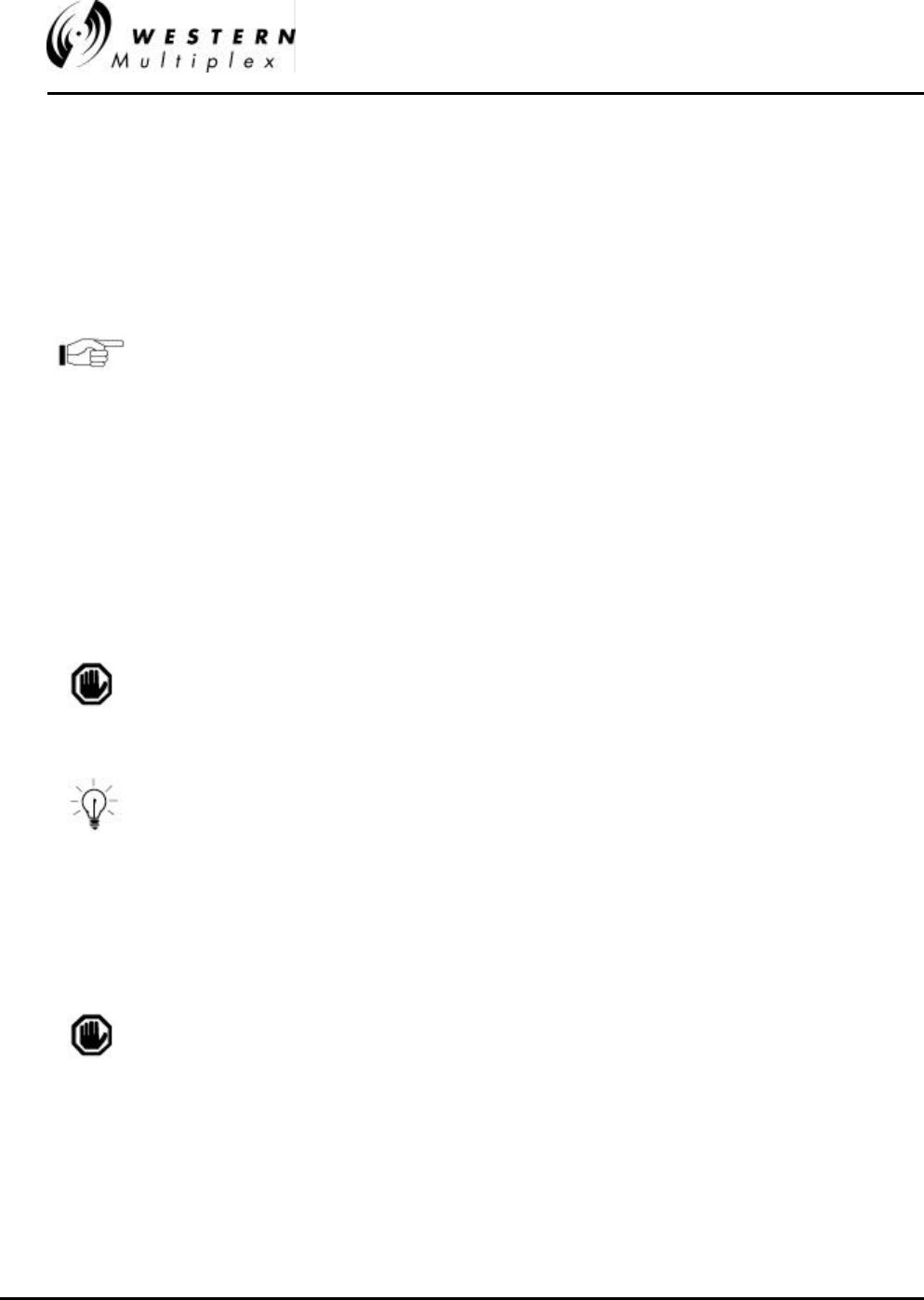
INSTALLATION AND MAINTENANCE MANUAL
Tsunami FAMILY
GIGABIT ETHERNET WIRELESS BRIDGES
JANUARY 2001
PAGE 3-12 SECTION 3: INSTALLATION & ADJUSTMENTS
3.7.1 DC Power Wiring
Connect the power cable with adequate current rating (minimum of 20 AWG) to the terminals shown
on the removed (not plugged into the radio) DC power plug using the screw connections. The
recommended minimum current rating of external fuses and cables is 5 Amps. The Tsunami radios
consume less than 4 Amps at ±48V. Be sure the DC power cable is less than 3 meters (9.75 feet) in
length.
Each Tsunami terminal should be externally fused separately with
a 8 Amp maximum fuse. The DC power cable must be less than
three (3) meters in length.
If using negative power, connect the negative voltage to pins 1 or 6. Connect the ground return
connection to pins 3 or 4. See Figure 3-3.
If using positive power, connect the positive voltage to pins 3 or 4. Connect the ground return
connection to pins 1 or 6. See Figure 3-4.
The ground connection is available at pins 2 and 5. Either pin may be used to ground the return side
of the power supply. Do not ground both sides of the power supply.
Proper grounding, either through the chassis and/or the power
supply, can be very important for protection from lightning. A
grounding screw hole is provided on the rear panel.
The ground connection may be left floating if the power supply is
referenced to ground externally and to avoid ground loops in some
configurations. However, this may not provide adequate grounding
for lightning protection.
Use a DVM (digital voltmeter) to verify voltage and polarity on the DC power plug.
Do not connect the DC power plug to the rear of the Tsunami
terminal until a load is connected to the antenna port (either an RF
pad, or an RF cable and antenna).
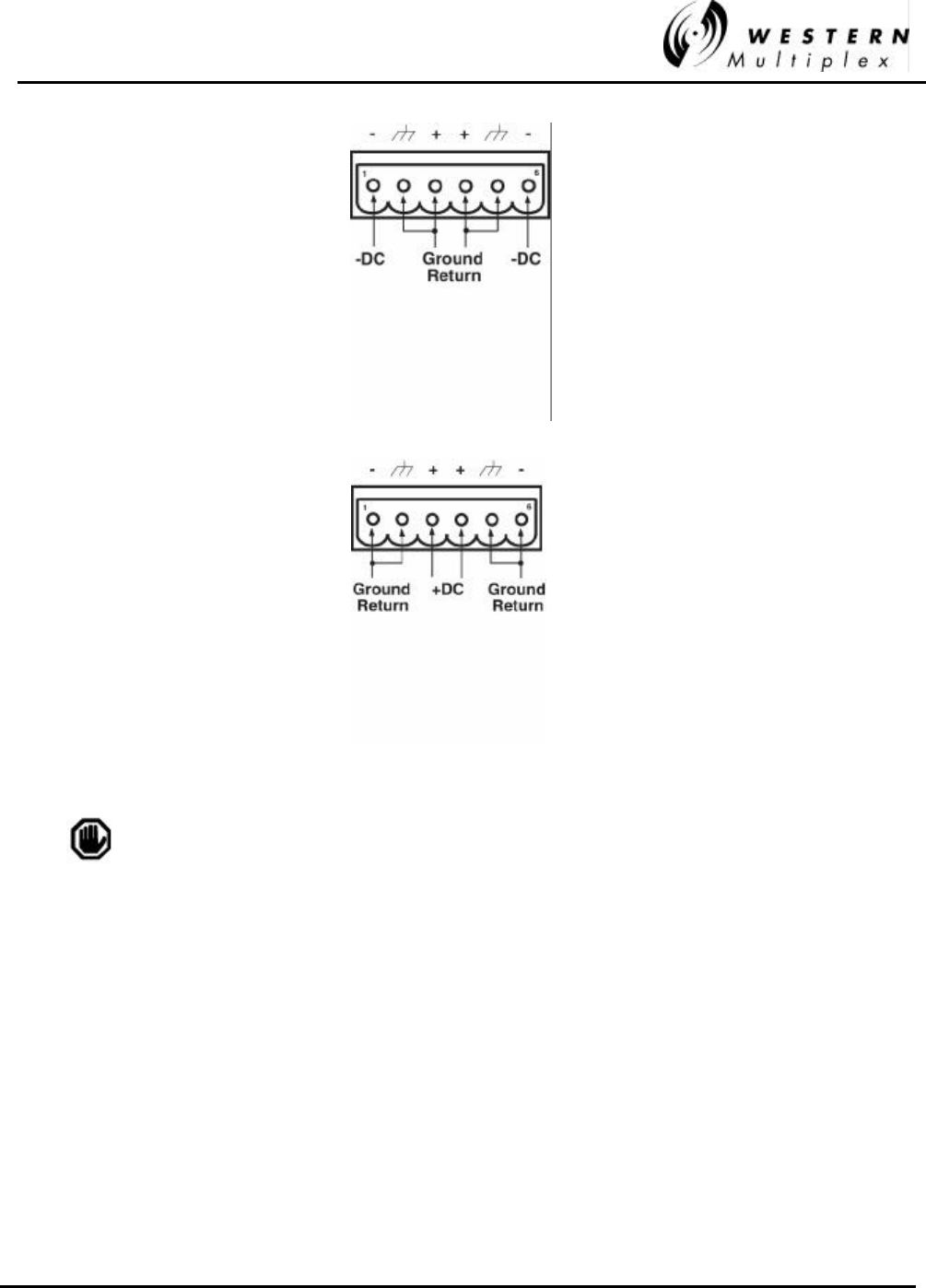
INSTALLATION AND MAINTENANCE MANUAL
Tsunami FAMILY
GIGABIT ETHERNET WIRELESS BRIDGES
JANUARY 2001
SECTION 3: INSTALLATION & ADJUSTMENTS PAGE 3-13
Figure 3-3: Negative Voltage DC Connection
Figure 3-4: Positive Voltage DC Connection
Make sure that when connecting the mating plug that it is properly
oriented (terminal screws pointing up) and securely fastened.

INSTALLATION AND MAINTENANCE MANUAL
Tsunami FAMILY
GIGABIT ETHERNET WIRELESS BRIDGES
JANUARY 2001
PAGE 3-14 SECTION 3: INSTALLATION & ADJUSTMENTS
3.7.2 AC Power Connection
Not available with this product
Figure 3-5:
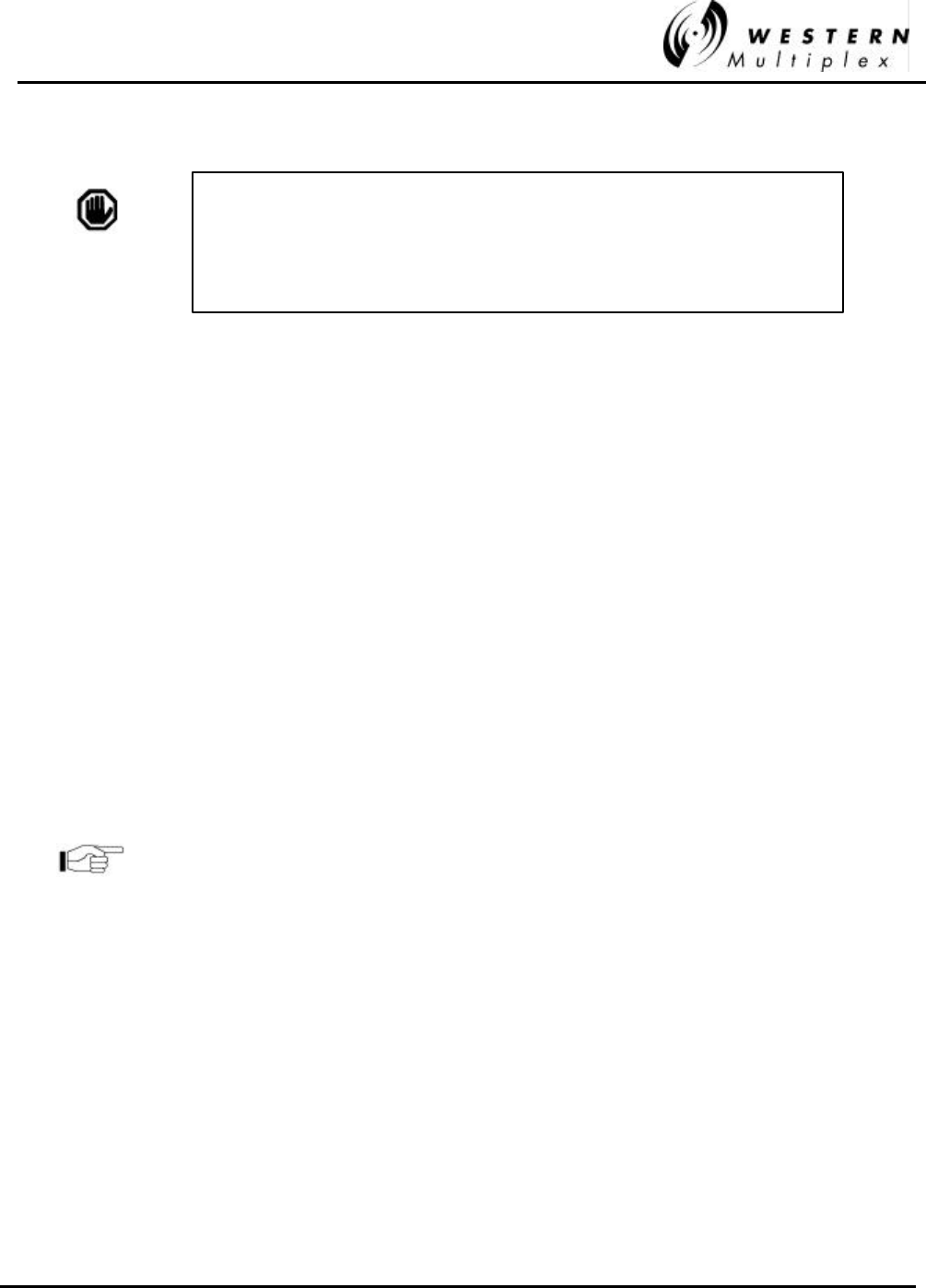
INSTALLATION AND MAINTENANCE MANUAL
Tsunami FAMILY
GIGABIT ETHERNET WIRELESS BRIDGES
JANUARY 2001
SECTION 3: INSTALLATION & ADJUSTMENTS PAGE 3-15
3.8 Antenna Installation & Alignment
The antenna installation consists of permanently mounting the antenna and then attaching the ODU
mounting plate and then the ODU itself to the mount. The antenna and ODU assembly must be
mounted outdoors on a tower, building roof, or other location that provides line-of-sight path clearance
to the far-end location. In general, antennas smaller than 1.5 feet diameter are not recommended for
urban.
Antennas should be ordered with the suitable mounting kit specific to the site requirements. The
antenna must be very rigidly mounted, with adequate room for azimuth and elevation adjustment from
the rear. The antenna polarization must be the same at both ends of the link, either vertical or
horizontal. The mounting kit includes the details on how to mount and adjust azimuth and tilt. Here,
the details on how to mount the adapter plate and ODU are described.
In general, antenna mountings require a support pipe to which upper and lower support brackets are
attached with “U” bolts. The antenna and optional elevation and azimuth adjustment rods are then
mounted onto the support brackets. The whole structure must be adequately grounded for lightning
protection. The antenna system must always be installed according to the manufacturer’s instructions.
Unless special test equipment is available, two operating Tsunami radios are required to align the
antennas. The antenna is coarse aligned using visual sighting and then fine aligned using the receive
signal level (RSL) voltage of the Tsunami. See figure 3-8.
The RSL voltage reading can still be used to peak antennas even if
the radios have not synchronized, however far-end RSL cannot be
measured from the near-end terminal until radios are synchronized.
INSTALLER CAUTION: Antennas used for this device must be fix-mounted
on permanent outdoor structures to provide 5 meter or more separation from
all persons during device operation to comply with FCC and other regulatory
RF Exposure requirements. Installers should contact the manufacturer for
applicable antenna gain and type restrictions to ensure compliance.
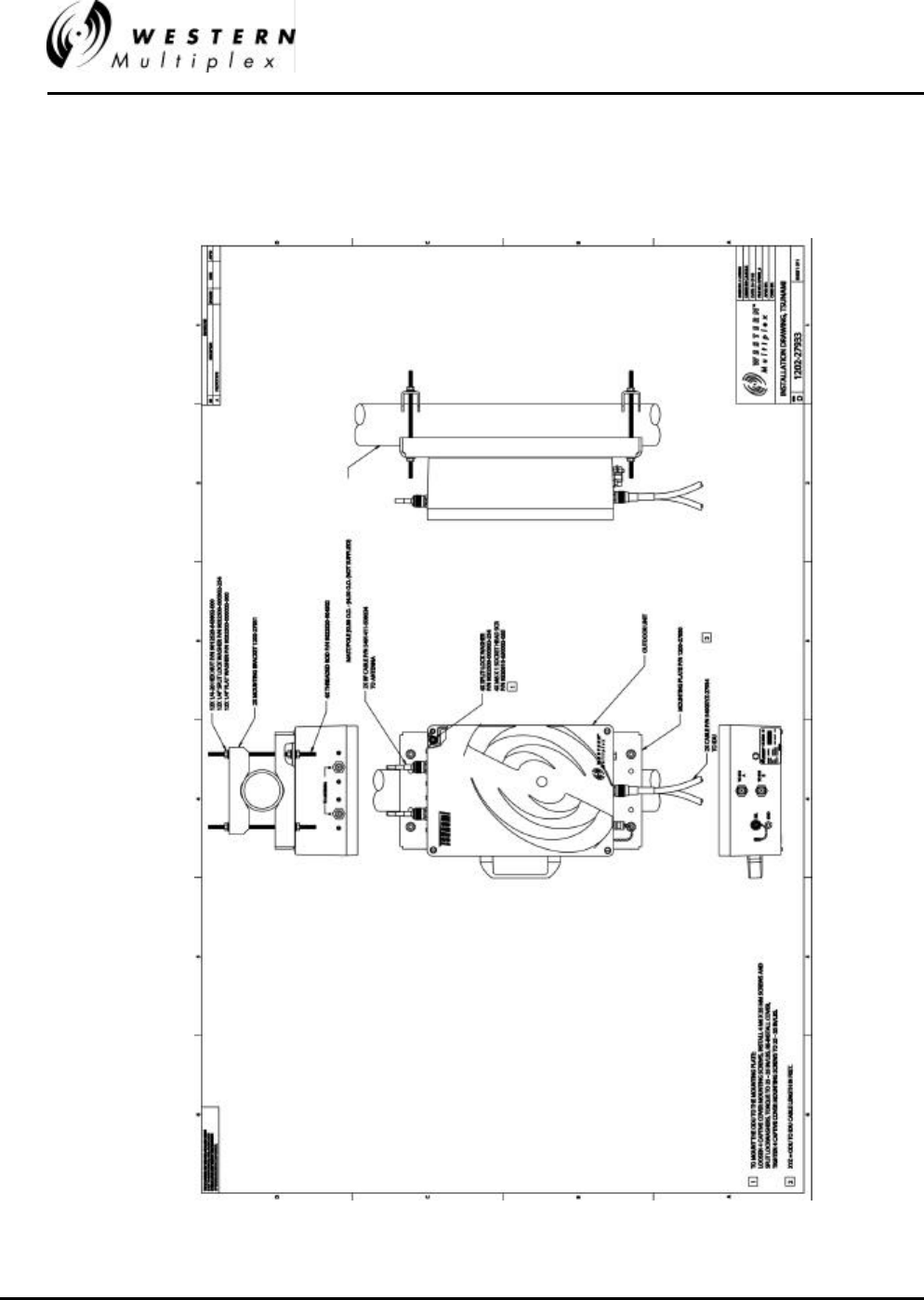
INSTALLATION AND MAINTENANCE MANUAL
Tsunami FAMILY
GIGABIT ETHERNET WIRELESS BRIDGES
JANUARY 2001
PAGE 3-16 SECTION 3: INSTALLATION & ADJUSTMENTS
3.8.1 Mounting plate to pole mounting assembly:
Refer to the diagram below-
Figure 3-6: ODU Mounting
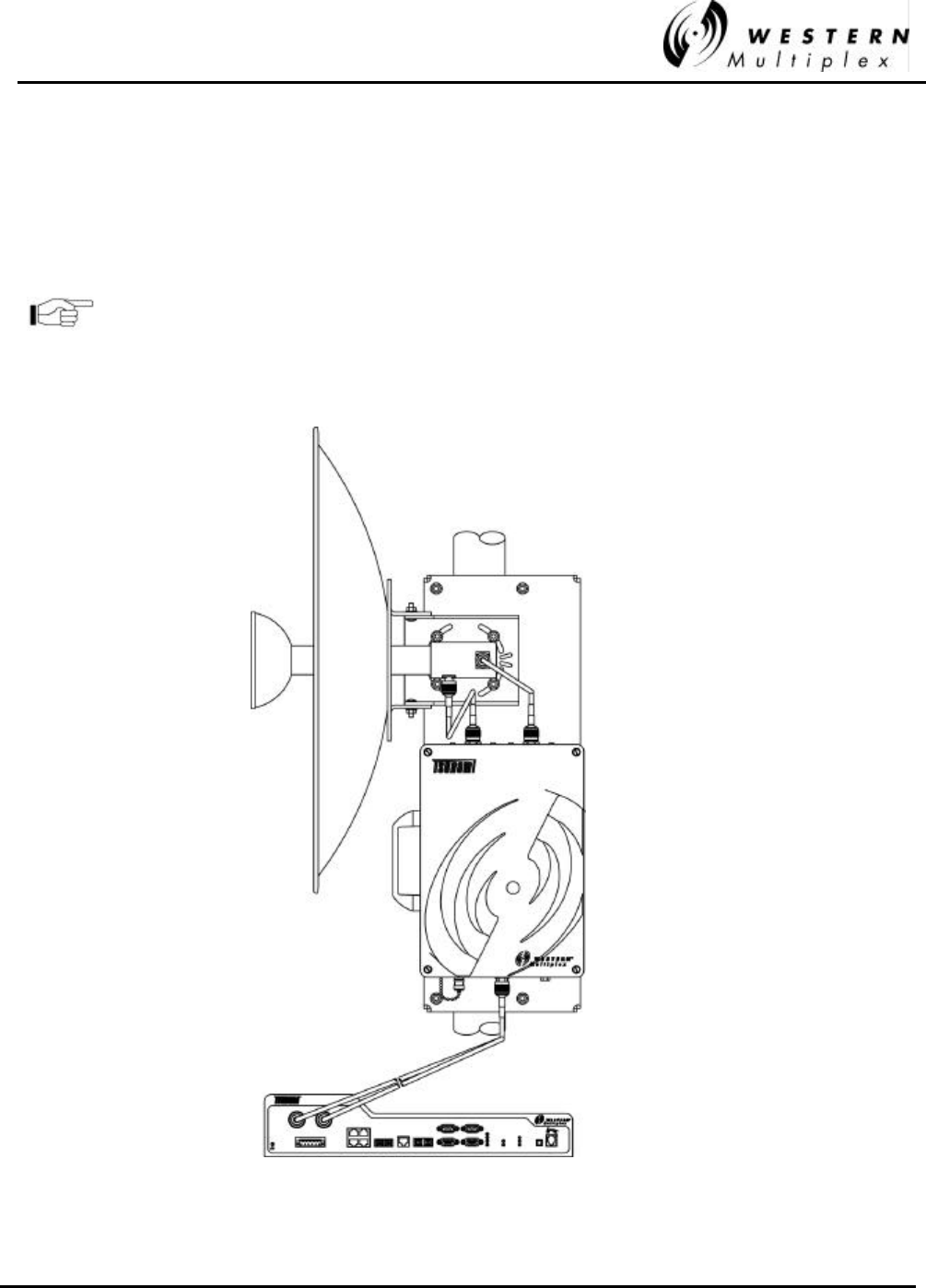
INSTALLATION AND MAINTENANCE MANUAL
Tsunami FAMILY
GIGABIT ETHERNET WIRELESS BRIDGES
JANUARY 2001
SECTION 3: INSTALLATION & ADJUSTMENTS PAGE 3-17
After attaching the antenna assembly per their enclosed instructions, attach the mounting plate as
shown in Figures 3-2, 3-6 and/or 3-7 below.
After attaching the mounting plate, use the antenna in either the horizontal or vertical polarization
position (remember, both ends of the link MUST use the same polarization).
Note: the A and B feed coax cables must be used for horizontal or
vertical polarization with the ODU.
After mounting the antenna, attach the dual coax cables that connects the ODU with the IDU.
Figure 3-7: IDU and ODU Dual Coaxial Connections
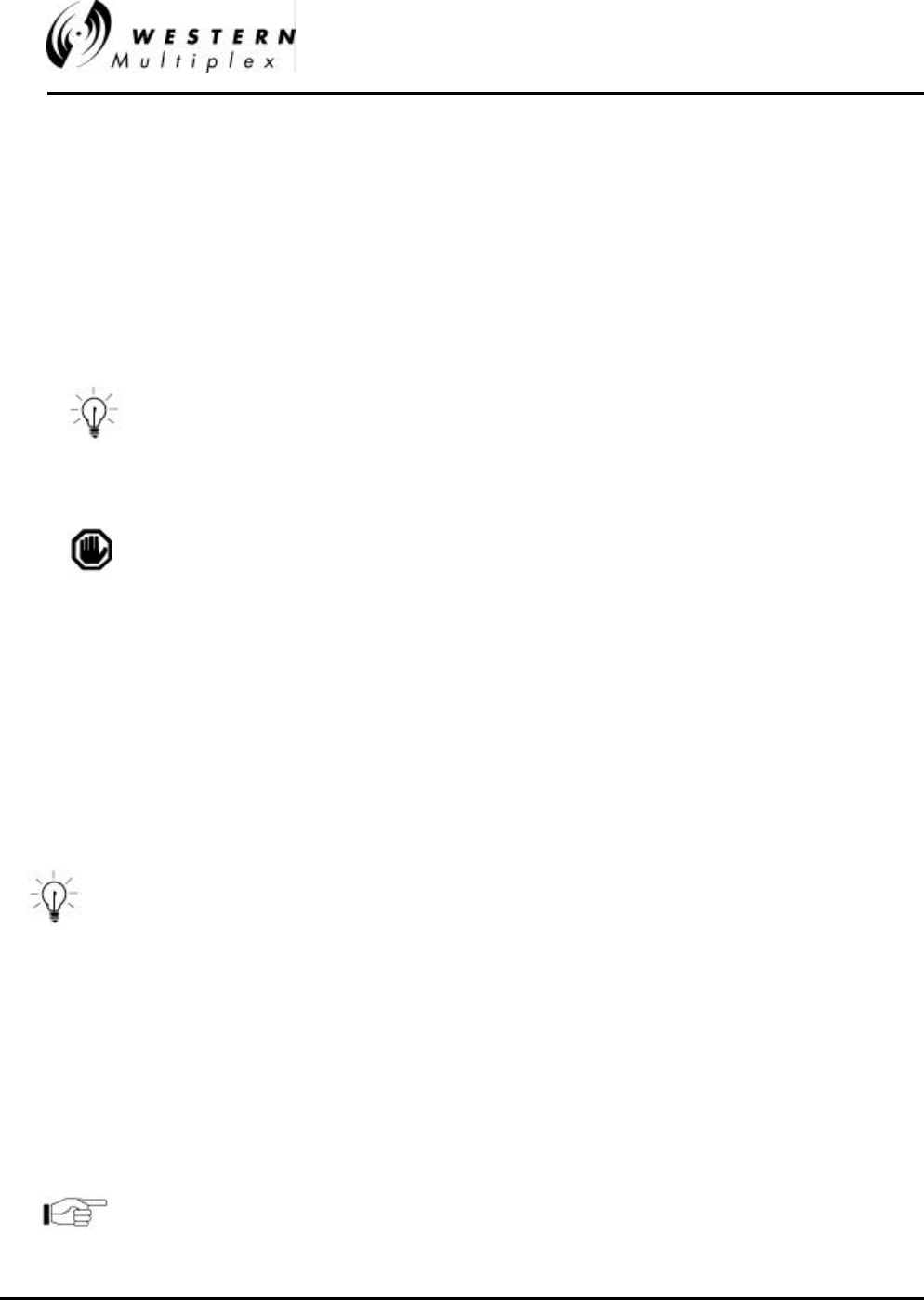
INSTALLATION AND MAINTENANCE MANUAL
Tsunami FAMILY
GIGABIT ETHERNET WIRELESS BRIDGES
JANUARY 2001
PAGE 3-18 SECTION 3: INSTALLATION & ADJUSTMENTS
3.8.2 Course Antenna Alignment
To coarse-align the antenna, first set it for flat elevation (no up or down tilt) using a spirit level. Then
point it at a heading marker obtained using a compass/GPS (magnetic corrected) back-bearing from
an adjacent location, (ideally, 100 feet or more away from the antenna).
If a heading marker cannot be set sufficiently far away (for example when on a city building roof or
looking through a window) then a rough azimuth setting can be obtained by sighting along the antenna
feed.
It should be verified that both antennas are on the same polarization
by using the manufacturer’s instructions. Otherwise the RSL will be
approximately 25 to 30 dB below the calculated level.
Most antennas will also need fine alignment obtained using an operating link because it is very
important to maximize the receive RF signal level at each end of the radio link.
Read Section 3.7 before applying DC power to the Tsunami radio.
Once the coarse alignment has been set-up at both ends, then the link can be powered and some
level of reliable communication established. The voltage at the Tsunami ODU RSL test point (BNC
connector) should be measured with a DVM to determine the relative receive RF signal level.
For the fine alignment, adjusting first the azimuth and then the elevation of the local antenna will
maximize the RSL voltage. Then, the far antenna is aligned in the same way, using the RSL voltage of
its local Tsunami radio ODU.
When aligning antennas it may be convenient to allow direct visiblity to the technicians aligning the
antenna.
An orderwire telephone will provide end-to-end voice communications
once radios are synchronized. Synchronization usually can be
accomplished by coarse alignment only. After synchronization, the
orderwire phones can be used to communicate between radio sites for
antenna fine alignment. The phone interconnect cable can be extended
to the antenna when desired.
The larger the antenna size, the more critical alignment becomes: for example, with a 2 foot dish, the
antenna can be moved ±3 degrees off the correct heading before the receive signal level drops by 3
dB. This compares with a 6-foot dish which may only be moved ±1 degree for the same degradation.
The graph shown in Figure 3-8 shows the typical variation of RSL voltage as the receive signal level is
increased from threshold to a higher level. There is some variation between Tsunami receivers, but an
approximate estimate of the potential RSL value may be made using this figure.
Use the Factory Test Data Sheet shipped with your Tsunami terminal to
obtain the best estimate of your RSL.
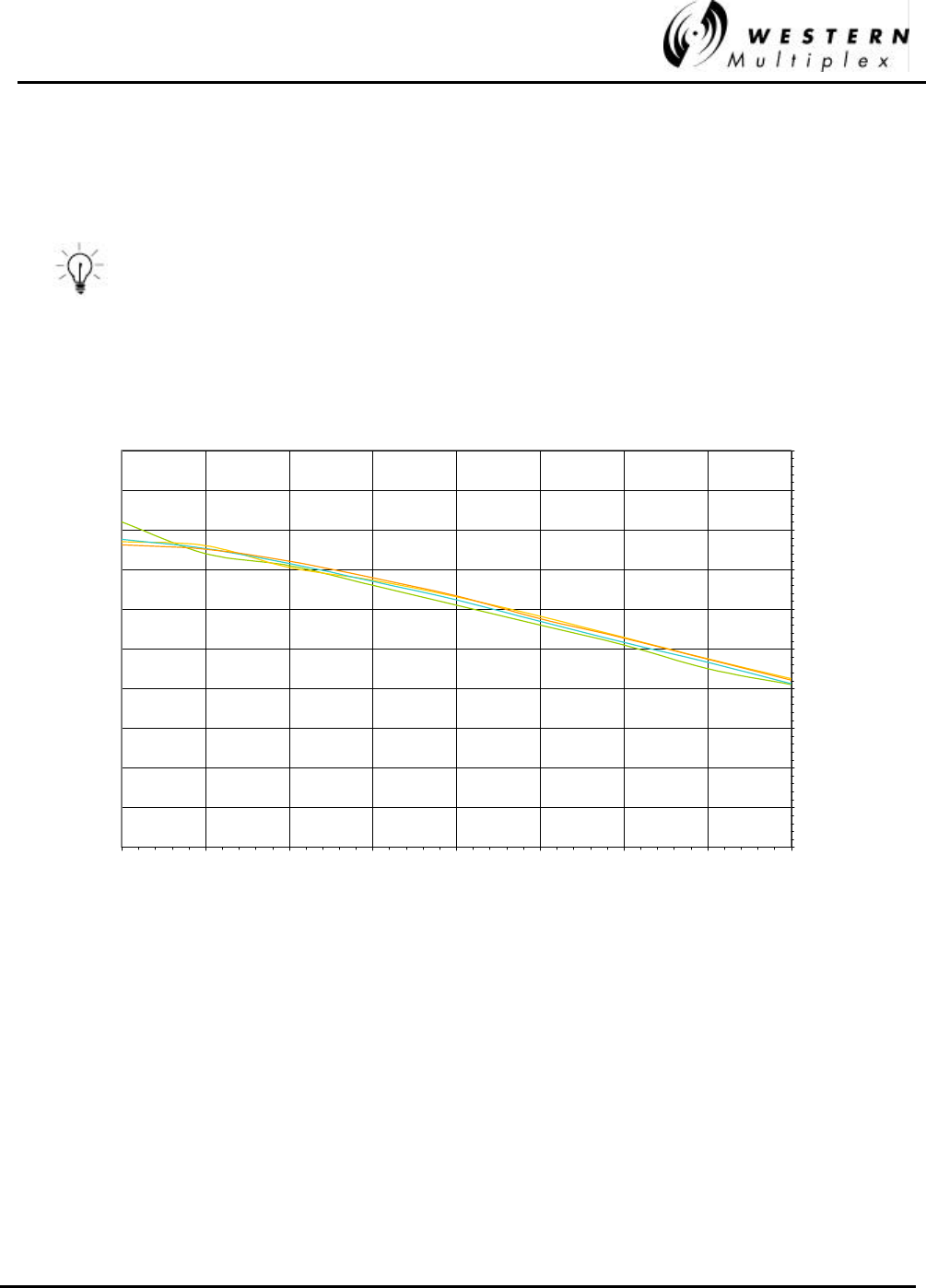
INSTALLATION AND MAINTENANCE MANUAL
Tsunami FAMILY
GIGABIT ETHERNET WIRELESS BRIDGES
JANUARY 2001
SECTION 3: INSTALLATION & ADJUSTMENTS PAGE 3-19
Above 0 dBm RSL, the receiver may produce errors: however this level is rarely likely to be exceeded.
A link budget calculation should be made to calculate the anticipated RSL as described in Section
3.3.3. During anomalous propagation conditions, the RSL may fade but will not increase up more than
10 dB (except in unusual very long paths which may fade up by 15 dB).
Antenna alignment should enable the RSL to be peaked to the level
calculated in the link budget. If the RSL is peaked but is
approximately 20 dB below the calculated level, then it is likely that
the antennas are aligned on a sidelobe of the antenna's radiated
signal. In this case, the antennas should be rotated in a wide arc until
the main lobe is located. (Other possible causes of low RSL are path
obstructions, loss in connectors, adapters and pigtail jumper cables
or different antenna polarization at each end of the link.)
Tsunami Gigabit Models
0.00
0.10
0.20
0.30
0.40
0.50
0.60
0.70
0.80
0.90
1.00
-80 -75 -70 -65 -60 -55 -50 -45 -40
RSL (dB)
Volts
Figure 3-8: Typical RSL Voltage versus Received Signal Level (RSL)

INSTALLATION AND MAINTENANCE MANUAL
Tsunami FAMILY
GIGABIT ETHERNET WIRELESS BRIDGES
JANUARY 2001
PAGE 3-20 SECTION 3: INSTALLATION & ADJUSTMENTS
3.9 Ethernet Interface Connection
The radio link’s 1000BaseF interface connection to the Tsunami radio is on the front panel.
Additional external lightning protection devices are recommended for
the connections if the radio is installed in an area prone to lightning.
Use only PolyPhaser or equivalent protectors that are rated for at
least 2000MHz and pass DC current (non DC blocking type).
The 1000BaseF connection to the Tsunami is at the data interface on the front of the shelf.
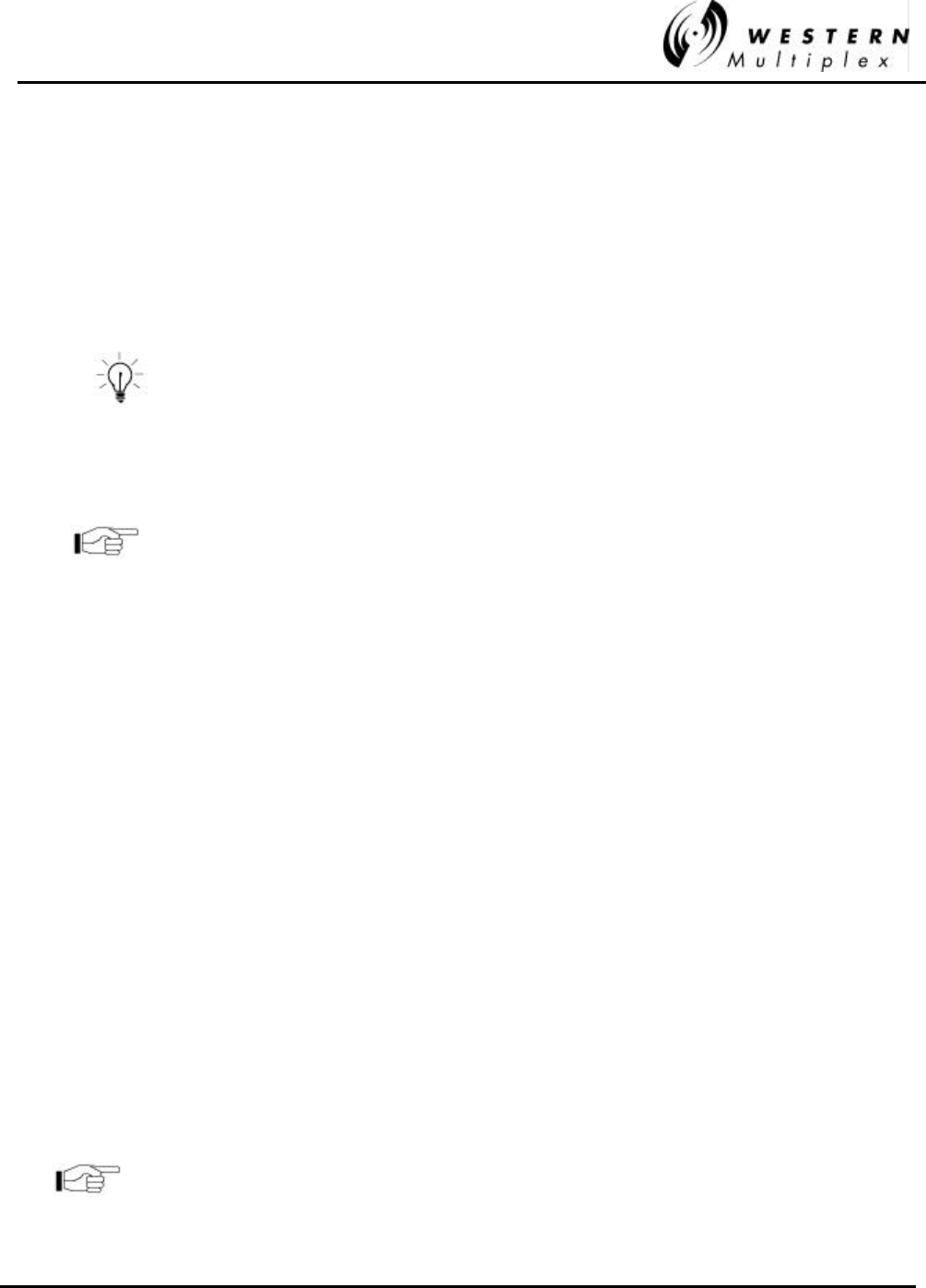
INSTALLATION AND MAINTENANCE MANUAL
Tsunami FAMILY
GIGABIT ETHERNET WIRELESS BRIDGES
JANUARY 2001
SECTION 3: INSTALLATION & ADJUSTMENTS PAGE 3-21
3.10 System Turn-up to Service
1. Prior to installing the system, it may be desirable to perform a back-to-back test of the Tsunami
radio pair. Consult Section 4.9 for further details. Back-to-back testing is a simple way to verify
that the Tsunami radios are fully operational before they are installed. Installation adds several
variables (such as antenna alignment) which can lead to system turn-up delays. Also, during
back-to-back testing, the DIP switch settings and some connections can be tested. This step
can eliminate a majority of troubleshooting once the radios are installed.
A cellular phone or two-way radio system (walkie talkie, CB,
mobile radio) can be very useful during installation. These can
be used for temporary near-end and far-end communications
between the installation personnel at one site and installation
personnel at the other site while installing the system. These can
also be helpful for communication between a person at the top of
a very tall tower and ground personnel.
The Tsunami radio incorporates an internal Orderwire feature
that provides end-to-end “telephone” style communications.
However, the link must be partially operational to use this feature.
In lieu of, or in addition to the use of cellular phones or two-way
radio, this Orderwire feature can also be very useful for
installation, but typically cannot be put into service until step 8 or
9 of this procedure is completed. See Section 3.14.1 for more
details.
2. Perform a general alignment of the antennas on both ends of the path using binoculars,
compass or other related tools. It is important to have the antennas aligned as accurately as
possible before putting radio traffic over the link. This will help in getting the system running
more rapidly. See Section 3.10 for more details.
3. Connect the transmission line to the antenna, and feed it to the Tsunami radio location (see
Section 3.9). Connect the opposite end of the transmission line to the N-type female
connector located on the filter assembly which occupies the top half of the Tsunami rear
panel. The connection must be terminated into an antenna or a load before DC power is
applied to the radio.
4. Verify that the same channel plan (e.g. A, B) as the near-end radio, and the opposite Tx and
Rx frequencies (e.g. A1 and A2 make up a matched pair of radios).
5. With the DC power source active, but not plugged into the Tsunami radio, using a voltmeter,
confirm that the DC mating connector has the proper power connections in accordance with
Section 3.7. Verify the polarity and the absolute voltage on all pins. Verify ground connection
for power.
6. Connect power to the Tsunami radio. Verify that the Front Panel “ON” LED indication is
illuminated. This confirms that power has been properly applied.
Ensure that the RF Antenna port connection is properly terminated
before applying power to the Tsunami terminal, as in step 3.
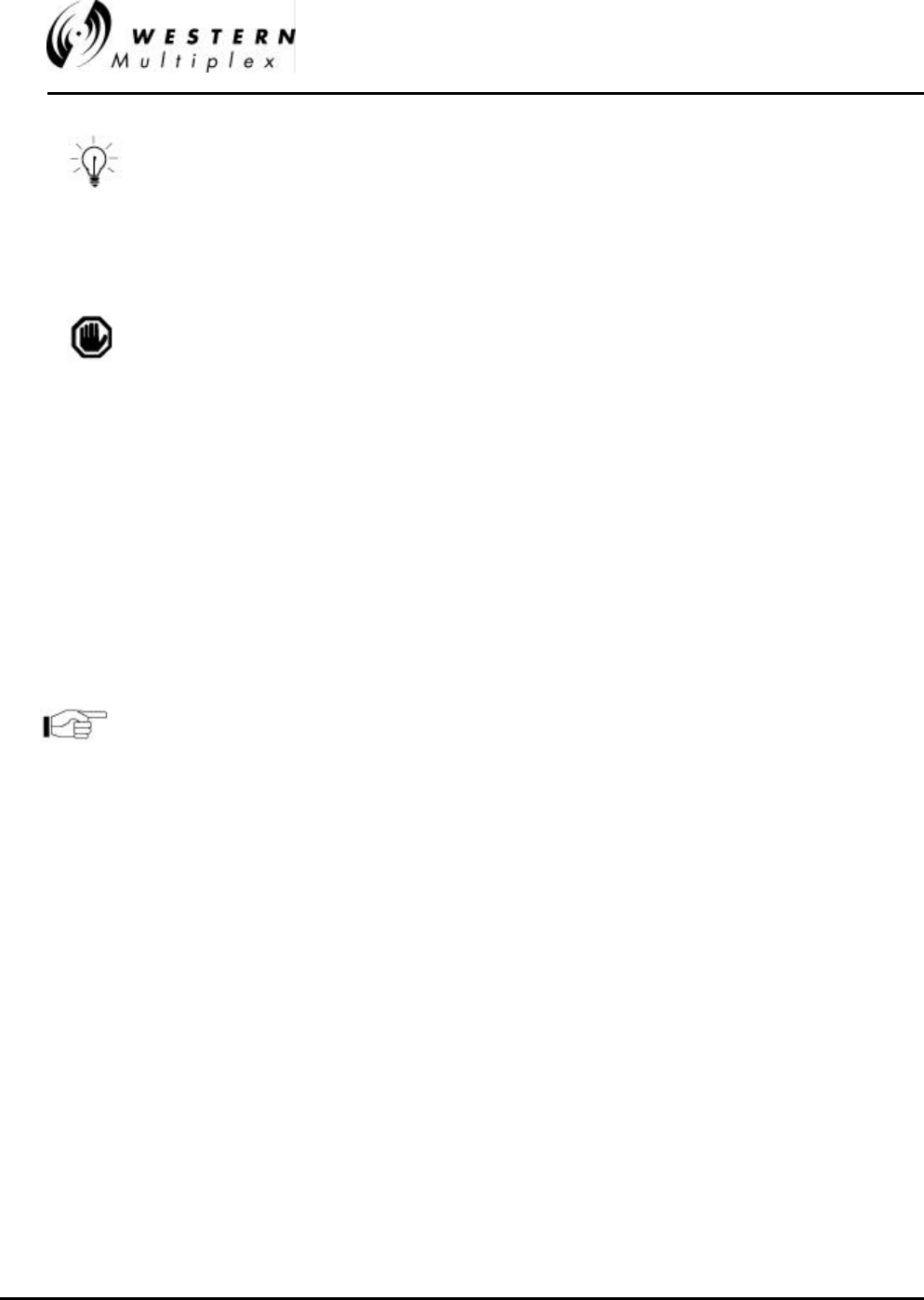
INSTALLATION AND MAINTENANCE MANUAL
Tsunami FAMILY
GIGABIT ETHERNET WIRELESS BRIDGES
JANUARY 2001
PAGE 3-22 SECTION 3: INSTALLATION & ADJUSTMENTS
When the Tsunami radio is initially powered-on, some alarm
conditions may be present. This is normal and alarms can be
ignored at this time.
The Tsunami radio requires professional installation. With some
Tsunami models, in certain countries, there may be Effective
Isotropic Radiated Power (EIRP) limits which dictate the maximum
output power that the Tsunami radio can transmit given the
transmission line loss and the gain of the antenna. Consult with
appropriate government agencies or Western Multiplex if there is
any question regarding maximum output power allowed. Do not
adjust output power above factory settings.
7. Connect a voltmeter to the ODU’s test points (BNC connection). This voltage reading
corresponds to the Received Signal Level (RSL) of the near-end radio. In other words, RSL is
the “amount” of signal the near-end radio is receiving from the far-end radio. Since the
antennas have not been finely aligned, it is not expected at this time that the RSL will read
very high. However, at this point it can be verified that some communication is taking place
between the two Tsunami terminals. Use the RSL voltage reading to align the antennas. Align
one antenna at a time in accordance with Section 3.10. Complete alignment of both ends of
the radio link before going further.
The RSL voltage output on the radio's front panel will output a
voltage over the usable range of the radio. Refer to Figure 3-8 in
Section 3.8.2.
RSL of both ends should be verified to be within approximately 2 dB of predicted value (see
Section 3.3.3). There are several factors that can contribute to low RSL:
-Incorrect antenna alignment (aligned on a lobe and not on the main signal)
-Improper polarization alignment of antennas (horizontal vs. vertical)
-Transmission line problems (loose connections, bent or damaged cables, lossy
adapters)
-Path obstructions (trees, buildings, hills, etc.)
-Path clearance (line-of-sight, earth curvature, Fresnel zone, diffraction and partial
obstruction)
-Weather (inversion layers, ducting and multipath)
- Antenna feed (coaxial/connector) problem
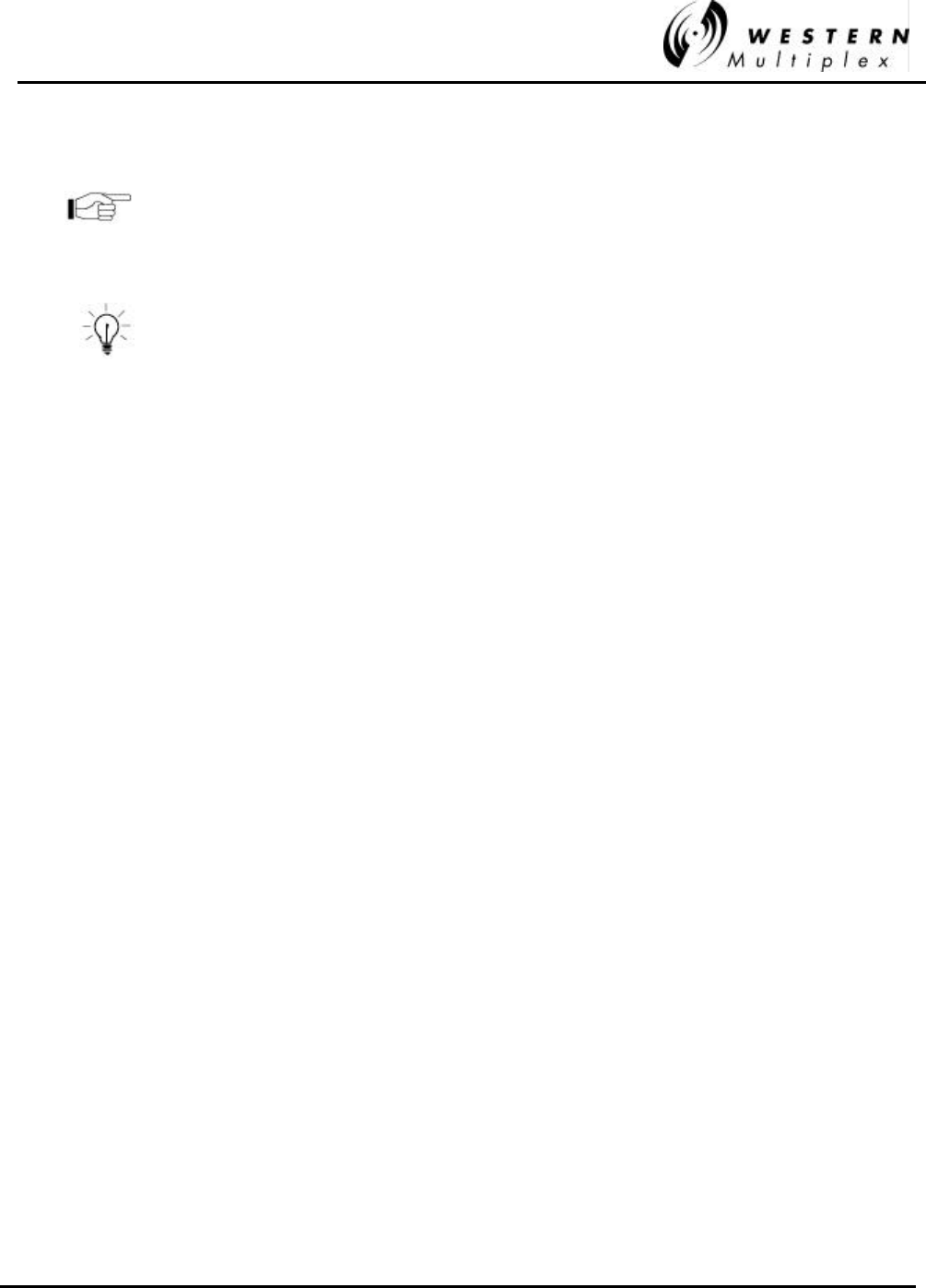
INSTALLATION AND MAINTENANCE MANUAL
Tsunami FAMILY
GIGABIT ETHERNET WIRELESS BRIDGES
JANUARY 2001
SECTION 3: INSTALLATION & ADJUSTMENTS PAGE 3-23
The Tsunami radio requires professional installation. Don’t forget
that the transmitter output power adjustment on the Tsunami radio
effects the RSL. Depending on EIRP limits (if any), path distance,
and antenna gain, you may need to adjust the output transmit
power to the proper level before putting the radios in service.
If radio synchronization has been established, the radio link may
be able to provide some limited communications over the link. It
can be helpful to establish voice communications from one end of
the radio link to the other using the Orderwire feature of the
Tsunami radio. See Section 3.14.1 for details.
If RSL is lower than anticipated, recheck the path clearance and transmission line as these are the
typical causes of low RSL. Radio operations can be verified by connecting radios back-to-back with
attenuators (40-60 dB), (see Section 4.9). If the problem remains, consult Section 4 of this manual for
troubleshooting techniques which will help determine the source of the problem.
8. Once radio performance is verified and acceptable, the Tsunami radios can now be put into
service with the intended Gigabit Ethernet traffic. Connect to the LAN or computer using the
SC (fiber) 1000BaseF connector. With Ethernet traffic applied in both directions, all front
panel LEDs, except for POWER and the data TXD/RXD lights should be off. If any other
LEDs are on, consult the trouble shooting sections of this manual.
9. Now that the link is operational, other services can be connected including T1 (DSX-1),
Orderwire, Diagnostics, Alarms and Aux Data (Service Channel). Consult Section 3.14 for
details on these connections.
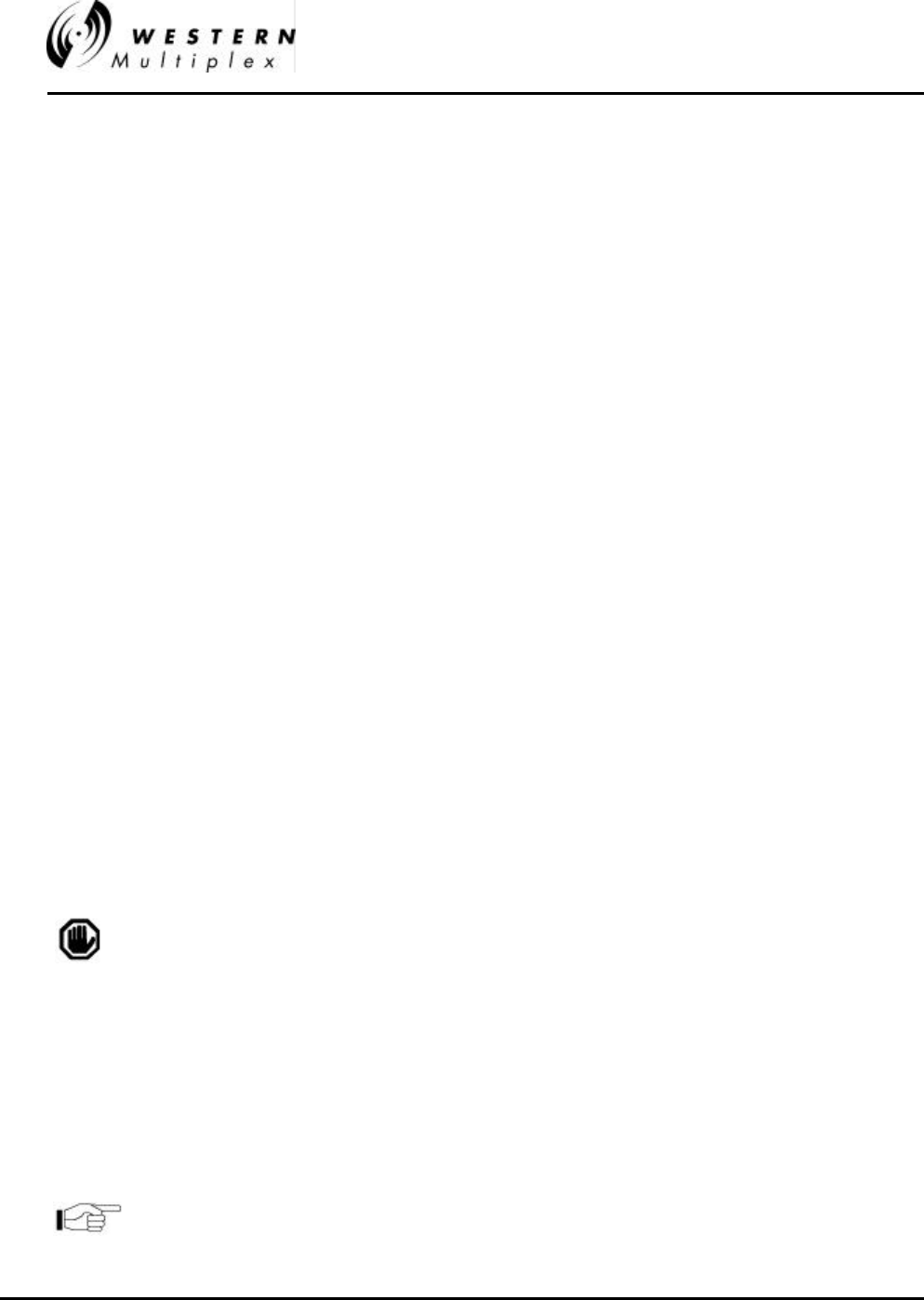
INSTALLATION AND MAINTENANCE MANUAL
Tsunami FAMILY
GIGABIT ETHERNET WIRELESS BRIDGES
JANUARY 2001
PAGE 3-24 SECTION 3: INSTALLATION & ADJUSTMENTS
3.11 Additional Connections
There are additional customer connections which are optional and are not required to make the
Tsunami operational but may prove useful.
3.11.1 Orderwire Connection
Orderwire is a “telephone” type wayside service which allows users of the Tsunami radio to establish
voice communications from one radio to another, either directly to the companion far-end, or through
a repeater configuration, or several repeater configurations.
Telephone connection specifications:
REN (Ringer Equivalency Number) 1.0 B
DTMF tones within ±1.5% of nominal freq.
Ringing Voltage 48 VDC, typical
(Ringing voltage is adequate for modern solid state ringers,
NOT for the older mechanical type ringers)
This Orderwire service does not affect the normal radio transmission of traffic. Refer to Section 2.3.5
for the telephone specifications. For simple near-end to far-end communications, follow the steps
below:
1. Using a standard RJ-11 telephone cable, connect a standard electronic telephone (a touch
tone phone, complete with dialer; a handset by itself will not work) to the Orderwire connector
on the Tsunami front panel. This connector is wired identically to a standard two-wire
telephone jack, see Figure 3-9 for details.
2. With a telephone connected to each Tsunami terminal on opposite ends of the link, either
telephone can be used to “dial-up” the far-end location. The far-end terminal’s internal ringer
and the connected telephone will ring, and if answered, two-way full-duplex voice
communication is established.
If using the Orderwire or Network management functions, all
Tsunami radios connected must have unique address settings
(telephone numbers).
4. If the Tsunami radios are connected in a repeater configuration, Orderwire services can be
established to all Tsunami terminals in the network by implementing a connection of their rear-
panel connectors between repeater terminals. At the repeater site, a cable can be connected to
the two Tsunami terminals between their rear panel VF 9-pin connectors as shown in Figure 3-6.
With this cable in place, the Orderwire function will operate at terminals at each end of the
repeater and at the repeater site. This function can be continued through several repeater sites if
desired. For hub connections of 3 or more Tsunami radios at the same site, an external 4-wire
bridge is required to connect all radios to the orderwire.
The orderwire system can be integrated with orderwire equipment
supported by many other vendors. If your existing orderwire
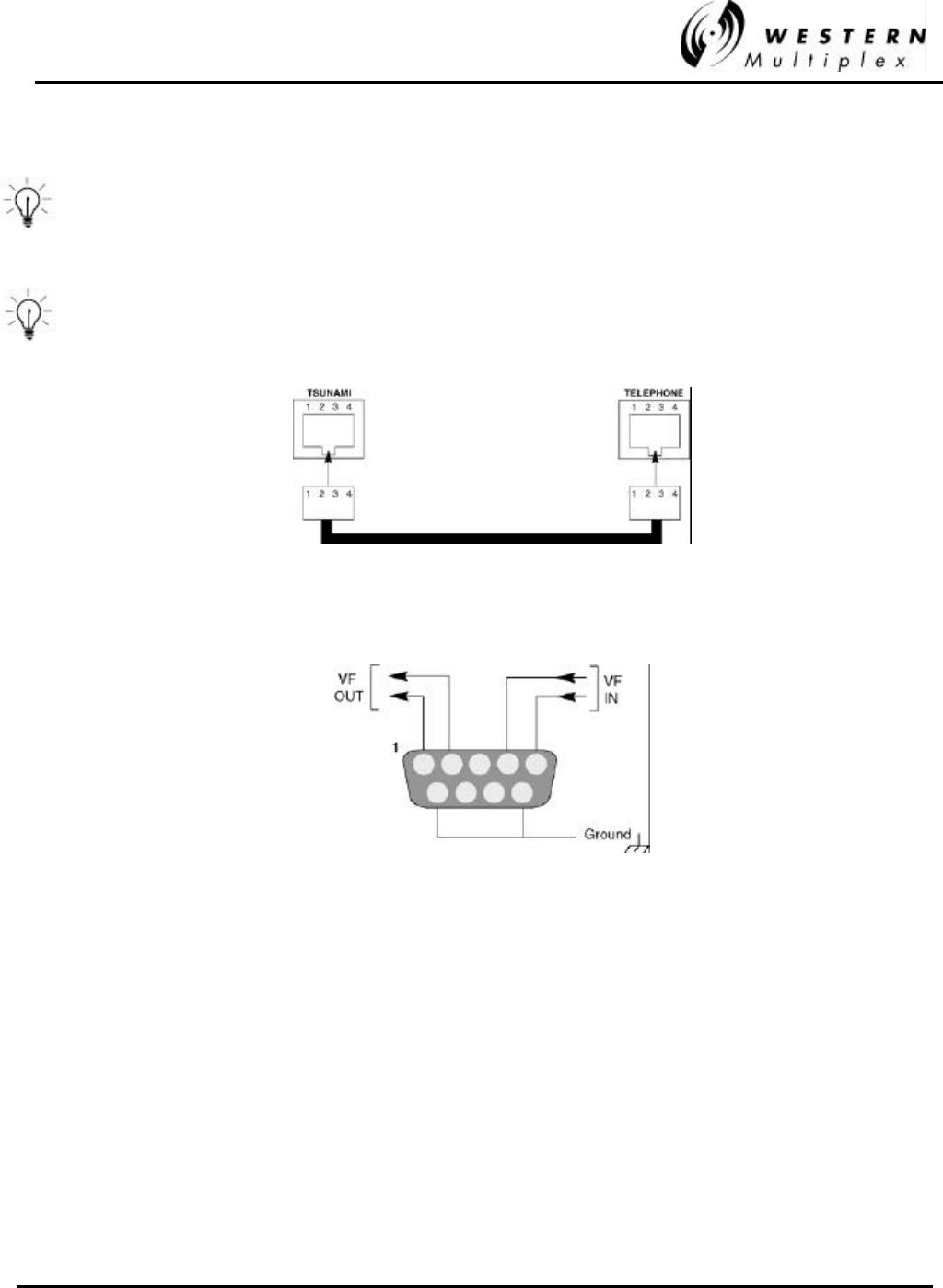
INSTALLATION AND MAINTENANCE MANUAL
Tsunami FAMILY
GIGABIT ETHERNET WIRELESS BRIDGES
JANUARY 2001
SECTION 3: INSTALLATION & ADJUSTMENTS PAGE 3-25
network uses 2 digit addressing, and 0 dBm VF interface, it can be connected
to a Tsunami as shown in Figure 3-9.
Dialing a V (star key) on the orderwire telephone implements an “all call”
feature which rings all connected radios. Also, if a phone anywhere in the
connected network has accidentally been left off-hook, the # (pound key) key
can be used to mute all off-hook handsets until they are placed on and off
hook again.
The orderwire operates like a “party line”. All telephones provide
communication to all other telephones in the connected network. Even if a
particular telephone does not ring, it can still be used to talk and listen to any
ongoing orderwire activity if the orderwire is in use at other terminal locations.
Orderwire Connection
VF Port Connection
Figure 3-9: Orderwire & VF Port Connection
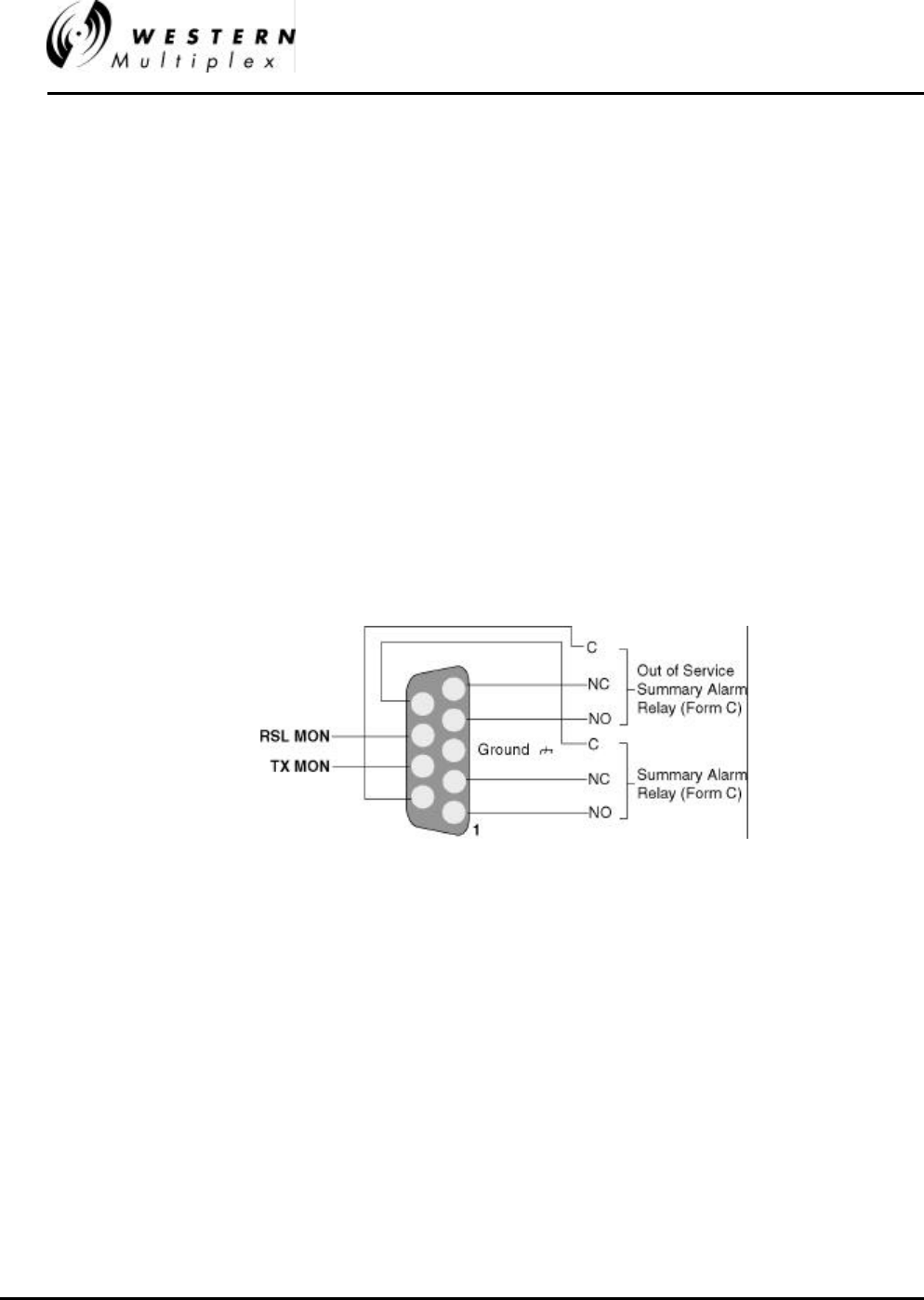
INSTALLATION AND MAINTENANCE MANUAL
Tsunami FAMILY
GIGABIT ETHERNET WIRELESS BRIDGES
JANUARY 2001
PAGE 3-26 SECTION 3: INSTALLATION & ADJUSTMENTS
3.11.2 Alarm Connections
External alarm outputs are provided at the 9-pin, D-type subminiature ALARM connector. There are
two Form C summary alarm relays capable of switching 30 VDC at 1 A. See Table 3-D and Figure 3-
10 for Alarm Connections.
The “summary” alarm (Form C relay) is activated by any near-end front panel LED alarm condition,
including if the internal test mode is enabled.
The “out-of-service summary” alarm (Form C relay) is activated by any of the following alarm
conditions:
vRF LINK
vRadio Fail
vInternal Test
Figure 3-10: Pin Connections, ALARM Interface
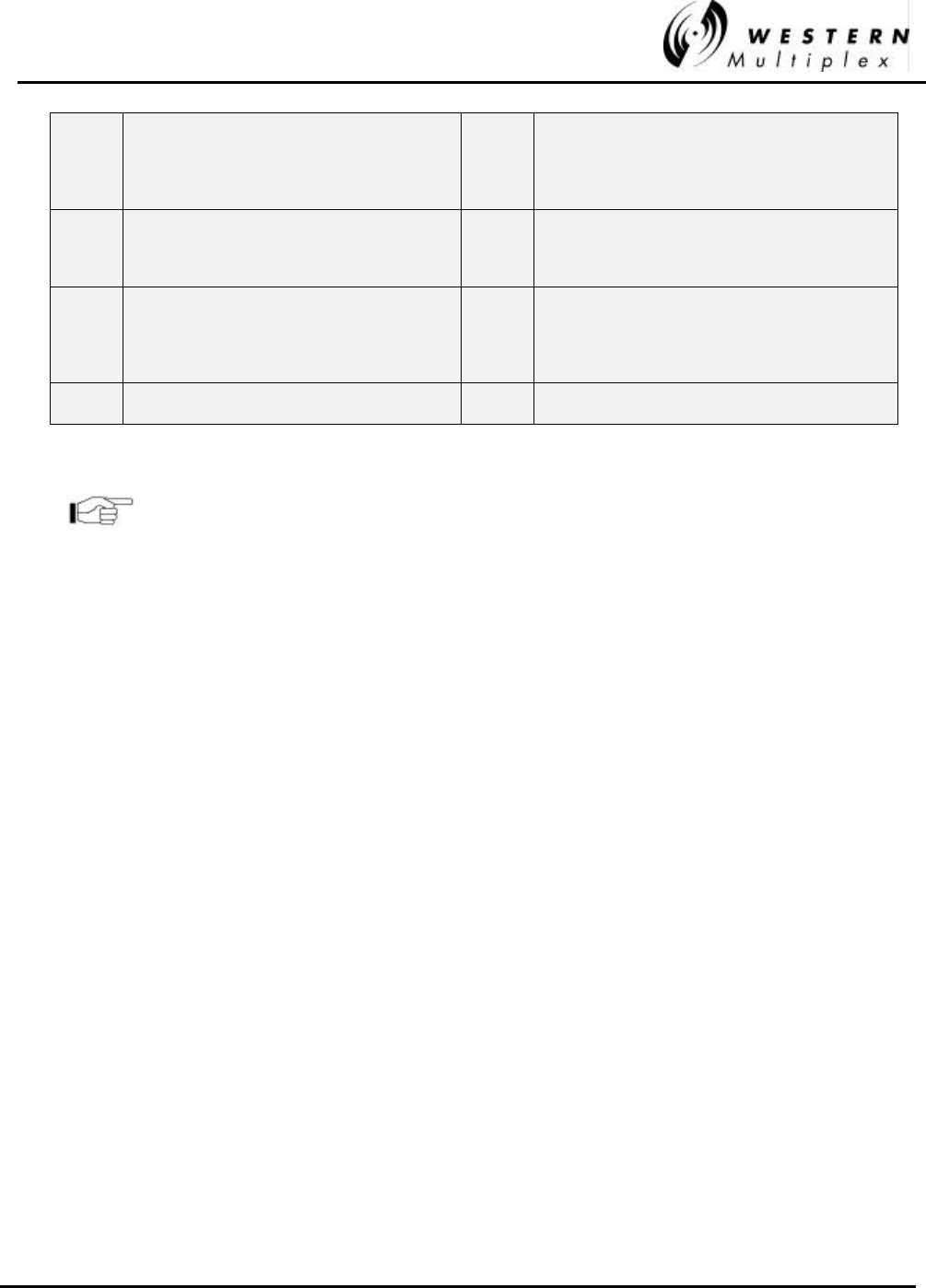
INSTALLATION AND MAINTENANCE MANUAL
Tsunami FAMILY
GIGABIT ETHERNET WIRELESS BRIDGES
JANUARY 2001
SECTION 3: INSTALLATION & ADJUSTMENTS PAGE 3-27
PIN 1 NO, SUMMARY ALARM, FORM C - normally
open connection on summary alarm relay.
Closed when in alarm.
PIN 4 NO, OUT OF SERVICE SUMMARY ALARM,
FORM C - normally open connection on out-of-
service summary alarm relay. Closed when in
alarm.
PIN 6 C, SUMMARY ALARM, FORM C - common
connection on the summary alarm relay. PIN 9 C, OUT OF SERVICE SUMMARY ALARM,
FORM C - common connection for the out-of-
service summary alarm relay.
PIN 2 NC, SUMMARY ALARM, FORM C - normally
closed connection on summary alarm relay. PIN 5 NC, OUT OF SERVICE SUMMARY ALARM,
FORM C - normally closed connection on out-of-
service summary alarm relay. Open when in
alarm.
PIN 7 RSL output DC voltage referenced to pin 3 PIN 8 Tx Power output DC voltage referenced to pin 3
Table 3-D: Alarm Interface Connections
All alarms are active for a minimum of one second, or as long as
the alarm condition persists, which ever is longer.
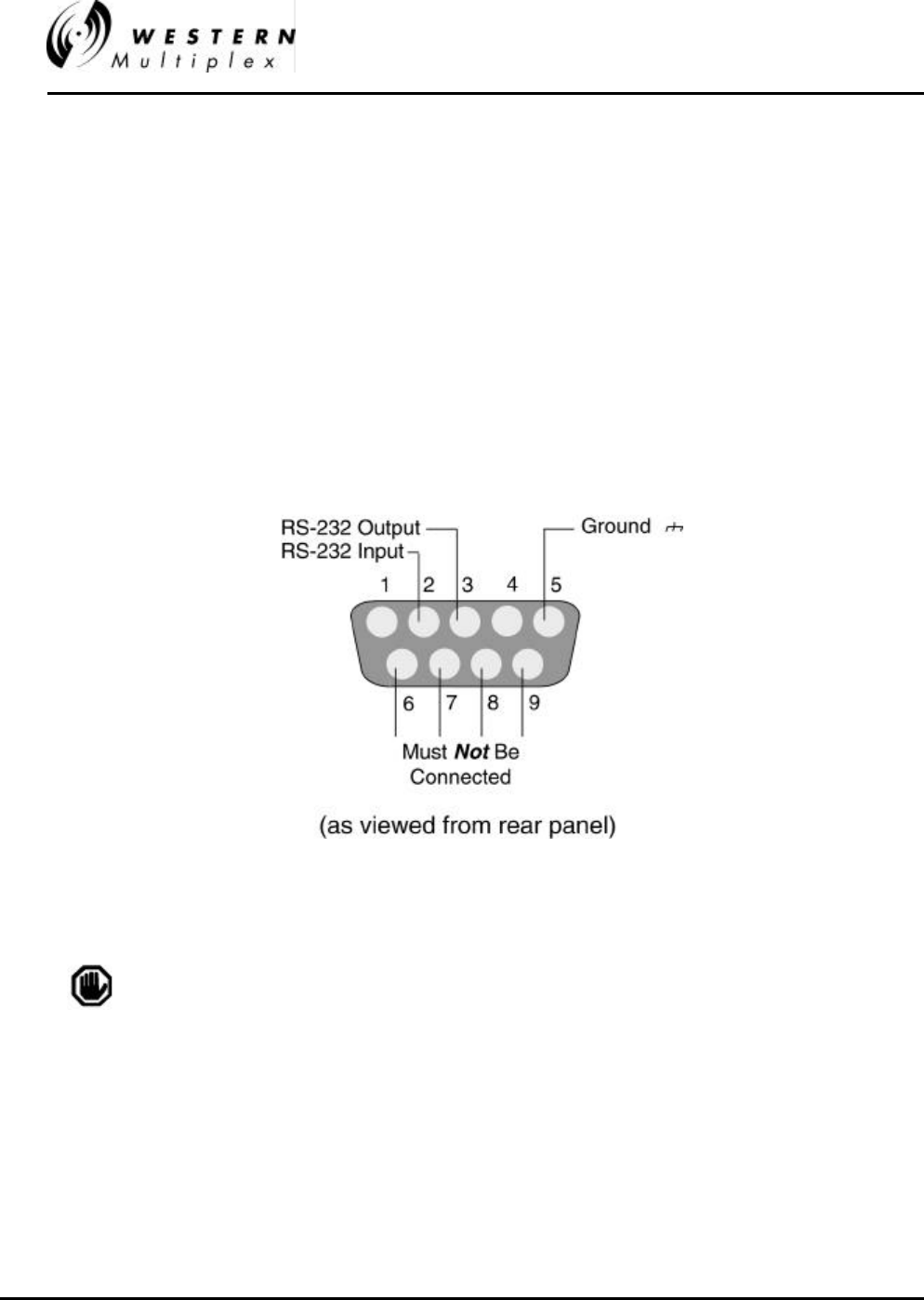
INSTALLATION AND MAINTENANCE MANUAL
Tsunami FAMILY
GIGABIT ETHERNET WIRELESS BRIDGES
JANUARY 2001
PAGE 3-28 SECTION 3: INSTALLATION & ADJUSTMENTS
3.11.3 Configuration (Diagnostic) Port Operation
The “Config” Port is used to retrieve diagnostic information and to configure additional features within
the Tsunami radios by means of a computer connection via SERIAL interface. Also can be used as an
RS-232 port to download the latest revision radio operation software.
The config port allows connection of RS-232 devices to receive status of the Tsunami radio and
provide configuration.
For RS-232 diagnostics connection (Section 4.11) to the Tsunami radio, connect the serial device
(modem, computer, terminal) to the male 9-pin subminiature connector in accordance with Figure 3-
11.
Figure 3-11: RS-232 Config Port Connections
Pins 6 through 9 must not be connected for RS-232 communications
to operate properly.

INSTALLATION AND MAINTENANCE MANUAL
Tsunami FAMILY
GIGABIT ETHERNET WIRELESS BRIDGES
JANUARY 2001
SECTION 3: INSTALLATION & ADJUSTMENTS PAGE 3-29
3.11.4 AUX DATA (Digital Service Channel) Connection
The AUX DATA port is a separate wayside serial port which can be configured to allow the connection
of any user serial data (to 9600 baud) through the radio network. Connection to the AUX DATA port is
an RS-232 serial interface, identical to the config port (see Section 3.14.3). This port does not affect
the Ethernet traffic on the Tsunami radio.
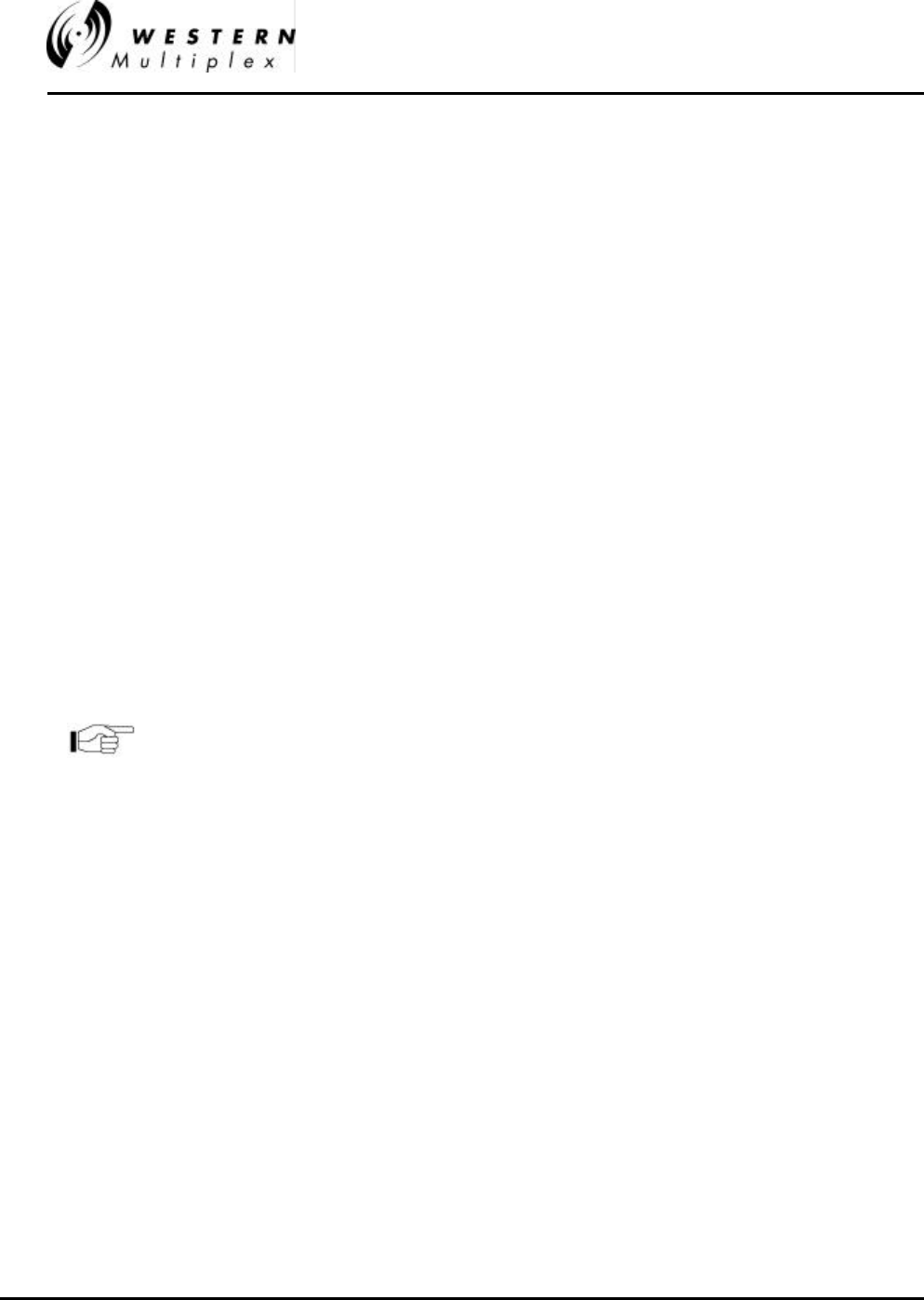
INSTALLATION AND MAINTENANCE MANUAL
Tsunami FAMILY
GIGABIT ETHERNET WIRELESS BRIDGES
JANUARY 2001
PAGE 3-30 SECTION 3: INSTALLATION & ADJUSTMENTS
3.11.5 T1 (DSX-1) Interface Connection
The Tsunami radio also provides four wayside T1 connections. These connections allows for standard
DSX-1 connect of voice circuits without affecting the Ethernet traffic. A standard RJ-48c connector is
provided for this connection.
3.11.6 CEPT-1 (E1) InterfaceConnection
Not provided with this model at this time
3.11.7 NMS Interface Connection
The NMS connection provides connection for the network management system. This allows an HTML
interface to the Tsunami radio for purposes of monitoring, configuration and security settings. This
connection is an RJ-45 style connection and complies to standard 100BaseT or F interface. Typically,
the installer or manager will connect to the NMS with a stand-alone computer to initially configure the
radio prior to installation. If IP addresses and security are set properly, the connection can also be
used as an out-of-band connection for radio management. Alternatively, if the 100BaseT/F is
connected to a network, or combined with the 100BaseT traffic on the link, via an external 10/100
switch, hub or router, full wireless NMS can be achieved for all radios in the network.
The factory default IP address is set to 10.0.0.1. To reset the radio back to the factory default, Hold
down the far-end test button while powering up the radio. Release the switch after 6 seconds.
More details on the NMS connection can be found in Section 4 of
this manual. In the future, this connection will also allow NMS via
SNMP (Simple Network Management Protocol) in addition to the
HTML interface that is presently supplied. Consult factory for
details or assistance with NMS connections, if required.
Ethernet Cable:Straight version to hub/switch, crossed version direct to PC.
Pins:1=Tx+, 2=Tx-, 3=Rx+ & 6=Rx

INSTALLATION AND MAINTENANCE MANUAL
Tsunami FAMILY
GIGABIT ETHERNET WIRELESS BRIDGES
JANUARY 2001
SECTION 3: INSTALLATION & ADJUSTMENTS PAGE 3-31
Your Notes on the Tsunami Radio

INSTALLATION AND MAINTENANCE MANUAL
Tsunami FAMILY
GIGABIT ETHERNET WIRELESS BRIDGES
JANUARY 2001
SECTION 4: TROUBLESHOOTING PAGE 4-1
4. Troubleshooting
4.1 Regular Maintenance
The Tsunami radios do not require any regular maintenance, however, it is prudent to monitor the
radio link at regular intervals to assure that the link conditions are not changing. When visiting a
radio site for maintenance, the following items may be checked and their results recorded:
vRSL Voltage
vPWR Voltage
vFar-end RSL Voltage
vAlarm conditions
vVerify radio has adequate ventilation
vVerify security ID is set the same at each radio through NMS
If any alarm conditions exist, they should be recorded, and troubleshooting procedures from this
Section of the manual should be followed.

INSTALLATION AND MAINTENANCE MANUAL
Tsunami FAMILY
GIGABIT ETHERNET WIRELESS BRIDGES
JANUARY 2001
PAGE 4-2 SECTION 4: TROUBLESHOOTING
4.2 Technical Support
Western Multiplex provides 24-hour telephone technical support for installed Tsunami radios.
Customers are encouraged to troubleshoot the radio and link in accordance with the latter part of
this section in this manual before contacting Western Multiplex. Western Multiplex also has a
limited supply of Tsunami radios that can be loaned to out-of-service customers for installation
while units are being repaired. Loaner supply is limited, and is only used for critical applications on
a first-come, first-served basis.
Customer service #: +1 408 542-5390
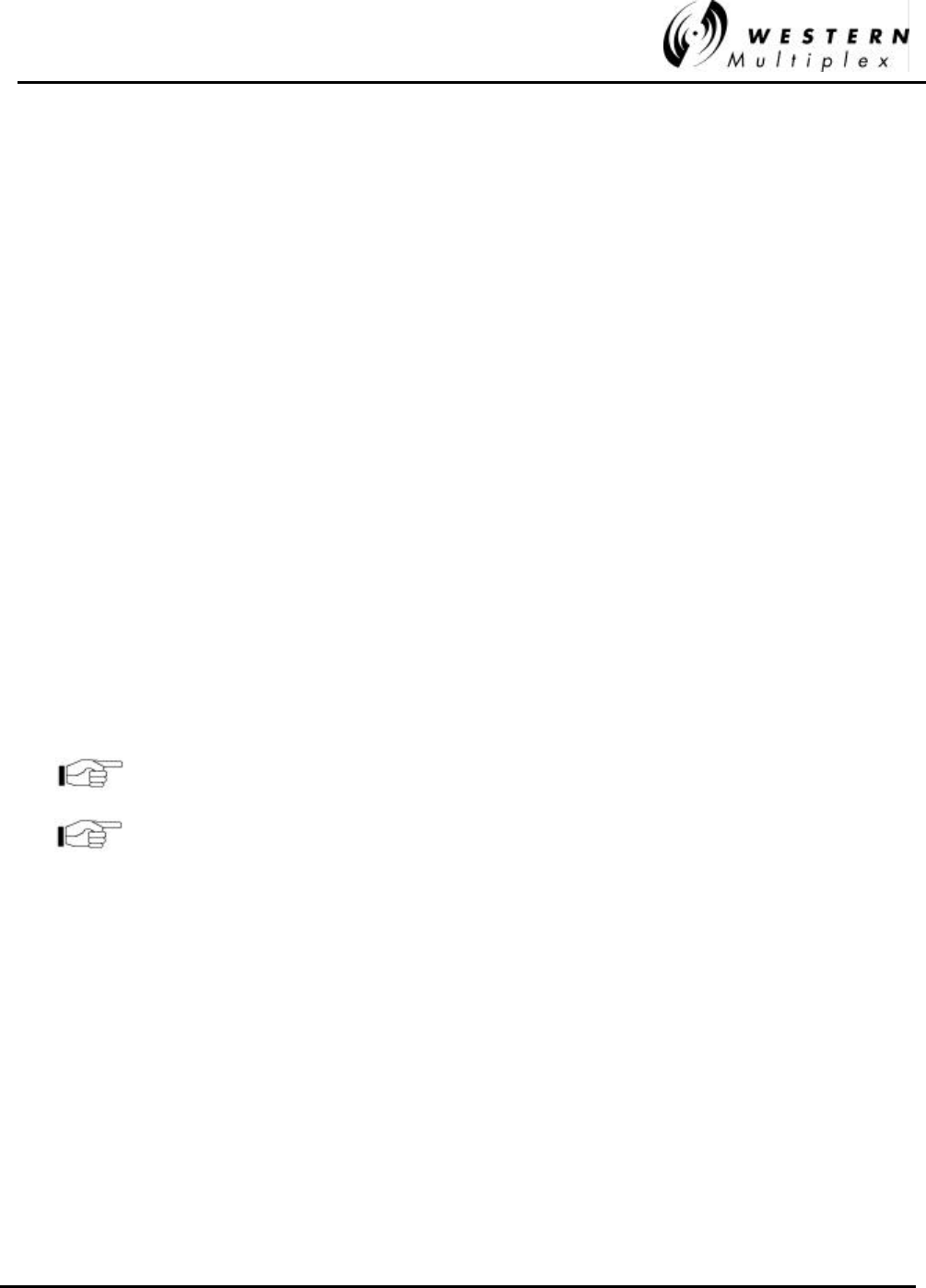
INSTALLATION AND MAINTENANCE MANUAL
Tsunami FAMILY
GIGABIT ETHERNET WIRELESS BRIDGES
JANUARY 2001
SECTION 4: TROUBLESHOOTING PAGE 4-3
4.3 Repair Policy
The Tsunami terminal includes comprehensive alarm indicators designed to diagnose potential
faults. Should a fault occur, it often may be resolved by operator adjustment.
Should a fault occur that cannot be resolved by operator adjustment and has been confirmed by
looping terminals together on the bench (See Section 4.7), then the equipment should be returned
to the factory for repair.
The Tsunami radio is a complex system not designed for user repair. Do not remove the cover or
open any part of the Tsunami terminal. The complete Tsunami terminal should be sent back in its
original packing material for factory repair.
Please contact the factory in advance of returning the product. You will be assigned a Return
Material Authorization (RMA) number that authorizes your return. Units sent to the factory without
an RMA number may be delayed in the processing of the repair. Be sure to include the following
information:
vRMA number
vdescription of the problem
vyour name and telephone number
vreturn shipping address
vurgency of repair
Please refer to the published Warranty policy for repair policy
details.
Tsunami radios should be packaged in their original packing
boxes for shipment whenever possible Western Multiplex can
provide an empty box shipment to facilitate proper packaging.
Regardless, proper and adequate packaging must be used for
shipments to protect the radio(s) from damage. Western
Multiplex can not be held responsible for any repairs due to
inadequately packed materials. Damage caused by improper
packing will likely result in higher repair costs and delays (refer
to the Warranty section at the beginning of this manual).

INSTALLATION AND MAINTENANCE MANUAL
Tsunami FAMILY
GIGABIT ETHERNET WIRELESS BRIDGES
JANUARY 2001
PAGE 4-4 SECTION 4: TROUBLESHOOTING
4.4 Front Panel Status LEDs
There are several front panel status LEDs on the Tsunami radio. These LEDs indicate conditions
where either a hardware failure has occurred or the radio link is not optimum. In many cases, a
combination of LEDs may be illuminated. The following sections describe the necessary
troubleshooting procedures should any LED(s) indicate a problem during or after installation.
IDU Green = Indoor Unit OK
Red = Indoor Unit detected hardware failure
Cable Green = ODU Cable OK
Red = ODU Cable shorted
ODU Green = Outdoor Unit OK
Red = Outdoor Unit detected hardware failure
Radio Fail Green = Radio hardware OK
Red = Hardware failure detected
RF Link
Green = Error-free operation
Yellow = Bit errors occurring
Red = Excessive bit errors or radio link failure
Flashing = Link ID mismatched
TXD Green = 100BaseT data transmit present
Yellow = 100BaseT port connected (no data present)
Off = No 100BaseT connection detected
RXD Green = 100BaseT data receive present
Yellow = 100BaseT port connected (no data present)
Off = No 100BaseT connection detected
COLL Yellow = Collisions occurring on 100BaseT (half-duplex mode)
FAR END Red = Alarm(s) present on the far-end radio**
NMS (10BaseT) Green = Tx or Rx data present on the NMS interface
Yellow = NMS interface connected (no data present)
Off = No NMS interface connection detected
T1 INPUT
Green = Alarm enabled and T1 connection detected
Red = Alarm enabled and no T1 connection detected
Yellow = Alarm disabled and T1 connection detected
Off = Alarm disabled and no T1 connection detected
** Radio Fail, RF Link (yellow or red), T1 Input (yellow or red)

INSTALLATION AND MAINTENANCE MANUAL
Tsunami FAMILY
GIGABIT ETHERNET WIRELESS BRIDGES
JANUARY 2001
SECTION 4: TROUBLESHOOTING PAGE 4-5
4.4.1 RF LINK Alarm
Function:
This LED indicates that the demodulator function is not synchronizing with the intended received
signal.
Possible Causes:
vSevere path fading due to atmospheric conditions, usually accompanied by low RSL
voltage reading
vPoor transmission line connections usually accompanied by low RSL voltage reading
vAntenna problems, misalignment, or path clearance usually accompanied by low RSL
voltage reading
vImproper radio settings (e.g. frequency channel)
vReceived signal level (RSL) is too strong
vInterference
vFar-End radio transmitter circuitry is faulty
vNear-End radio receiver circuitry is faulty
vLink security ID not the same for each radio
Recommended Actions:
Check the following at each end of the link:
vVerify that rear panel filters are opposite channel plans on each end (e.g. one is A1 and
other is A2).
vVerify that radio frequency settings match each installed filter (in NMS menus).
vVerify that all connections between radios and antennas are secure and all devices
between radios and antennas are rated for the radio frequency band (5.3/5.8 GHz).
Measure RSL by placing a voltmeter across RSL and GND test points. Compare this voltage to
the Factory Test Data Sheet and estimate the RSL in dBm. Compare this to the RSL that was
expected using path calculations (see Section 3.3.3). Press and hold the DISPLAY FAR END
button and measure the far-end RSL (while continuing to hold the button). Compare this RSL to
the Factory Test Data Sheet for the far-end radio and estimate the RSL in dBm. Again, compare
this RSL to the expected RSL from the link budget calculations.
If RSL from both ends of the radio are approximately the same as each other, but lower than
anticipated for this installation, then the likely cause of the BER alarm(s) is excessive losses
between the radios. Excessive loss problems could include the transmission line at either end, all
adapters, connectors, the antennas, the antenna alignment as well as the path itself (any
obstructions or clearance problems). Antenna alignment, line-of-sight and path clearance should
be verified; if this does not improve RSL, all devices between the radios and their antennas at
both ends should be checked. Make sure all transmission line, connectors and any other devices
are properly rated for operation at the radio's frequency (5.3/5.8 GHz).

INSTALLATION AND MAINTENANCE MANUAL
Tsunami FAMILY
GIGABIT ETHERNET WIRELESS BRIDGES
JANUARY 2001
PAGE 4-6 SECTION 4: TROUBLESHOOTING
If only one end has low RSL, this could be caused by low transmit output power from the opposite
end radio. Verify that the transmitter output power of the radio opposite to the low RSL receiver
has been set in accordance to path calculations, or EIRP restrictions (where applicable). Power
adjustment must be performed by professional installation personnel only. The PWR test point
can be used and compared with the Factory Test Data Sheet, the front panel recessed
potentiometer can be turned clockwise to increase power. If an RF power meter is available, this
can be connected to the RF output of the radio for precision measurement. This test will also
verify that the radio transmitter is working properly.
If one terminal (or both) has high RSL, this could be caused by a very short path or interference.
To verify the possible presence of interference, remove DC power to the radio which is opposite to
the one that is reading high RSL. Once power is removed, measure RSL on the remaining radio.
If RSL voltage is lower than that which is listed for "Threshold" in the Factory Test Data Sheet,
then an interfering signal is present. If interference is suspected, the easiest potential remedy is to
swap frequency channels on both sides of the link. See Section 4.2 for details. Swap terminals at
both ends of the link so that they are the opposite from their original installation. After both ends
are moved, reconnect the radios and determine if the BER alarm is still active. If the BER alarm is
still active, other frequency channels can be installed, or other interference countermeasures can
be tried, in accordance with Section 4.8.
If all path related and data input problems have been pursued and the BER alarm is still active,
the problem could be related to a radio failure. While radio failure is typically indicated by more
severe alarm conditions, it is possible that one of the radios may be out of specification, and this
could be the cause of the BER alarm. A back-to-back test will verify proper radio operation. See
Section 4.9 for details. A threshold test on both radios along with a test to verify proper RF output
power would be beneficial.
Perform a back-to-back test before returning any radio terminal to
the factory for repair. A back-to-back test verifies radio operation.
(See Section 4.7).
If the radios successfully pass their back-to-back testing, the problem is likely with the path or the
connections between the radio and the antenna or interference. Before reinstalling the radios, be
sure to set the output power to the appropriate level for the installation.

INSTALLATION AND MAINTENANCE MANUAL
Tsunami FAMILY
GIGABIT ETHERNET WIRELESS BRIDGES
JANUARY 2001
SECTION 4: TROUBLESHOOTING PAGE 4-7
4.4.2 RADIO FAIL Alarm
Function:
The RADIO FAIL alarm indicates a known problem with the radio hardware.
Possible Causes:
vInternal synthesizers are unlocked
vInternal digital circuits have failed
Recommended Actions:
1. Remove power from the unit.
2. Check to make sure power supply voltages are within specification.
3. Even if the voltages were within specification, reapply power to the unit.
4. If RADIO FAIL alarm clears, place the radio back into service.
5. If RADIO FAIL alarm does not clear, perform a back-to-back test to verify radio operation, as
described in Section 4.7.
6. If RADIO FAIL alarm is still active in a back-to-back test, return the radio to the factory for
repair (see Section 4.3).

INSTALLATION AND MAINTENANCE MANUAL
Tsunami FAMILY
GIGABIT ETHERNET WIRELESS BRIDGES
JANUARY 2001
PAGE 4-8 SECTION 4: TROUBLESHOOTING
4.4.3 FAR END Alarm
Function:
This LED indicates that there is an alarm condition present on the far-end radio. When the
DISPLAY FAR END button is pressed (and held), the status LEDs indicate the alarm conditions of
the far-end radio.
Possible Cause:
vOne or more alarm condition(s) exist on the far-end radio
Recommended Actions:
1. Press and hold the DISPLAY FAR END button and observe the LED status.
2. Follow instructions for troubleshooting the far-end radio in accordance to the appropriate
LEDs which are in alarm, as described in Section 4.6.1.

INSTALLATION AND MAINTENANCE MANUAL
Tsunami FAMILY
GIGABIT ETHERNET WIRELESS BRIDGES
JANUARY 2001
SECTION 4: TROUBLESHOOTING PAGE 4-9
4.5 Errors in the Data Stream
When the radio is in service, errors in the data stream may occur. This is usually known to the
operator by either faulty data indications of downstream equipment or external bit error rate
testing.
It is possible that no alarms appear on the front panel during normal operations, but there are
errors present in the data stream. Some errors will not result in no alarm (such as bipolar
violations, slow "dribbling" errors, improperly terminated connections or incorrect settings), but will
be exhibited on downstream data processing equipment or during a BER test. In other cases,
there may be data errors due to atmospheric conditions (fading), interference or other reasons,
but not at a high enough error level to be indicated with the BER alarm LED. In the case of these
types of errors, the following information can be helpful to troubleshoot the radio link.
Indications:
vDuring external BER test, test equipment indicates errors
vDownstream equipment (mux, channel bank, CODEC, router, etc.) indicates errors
Possible Causes:
vPath fading due to atmospheric conditions
vPoor transmission line connections
vAntenna problems, misalignment or path clearance
vReceived signal level (RSL) is too strong
vFar-End radio transmitter circuitry is faulty
vNear-End radio receiver circuitry is faulty
vInterference
Recommended Actions:
1. Verify 1000BaseF fiber connection and cable.
2. Follow the instructions described in Section 4.4.1
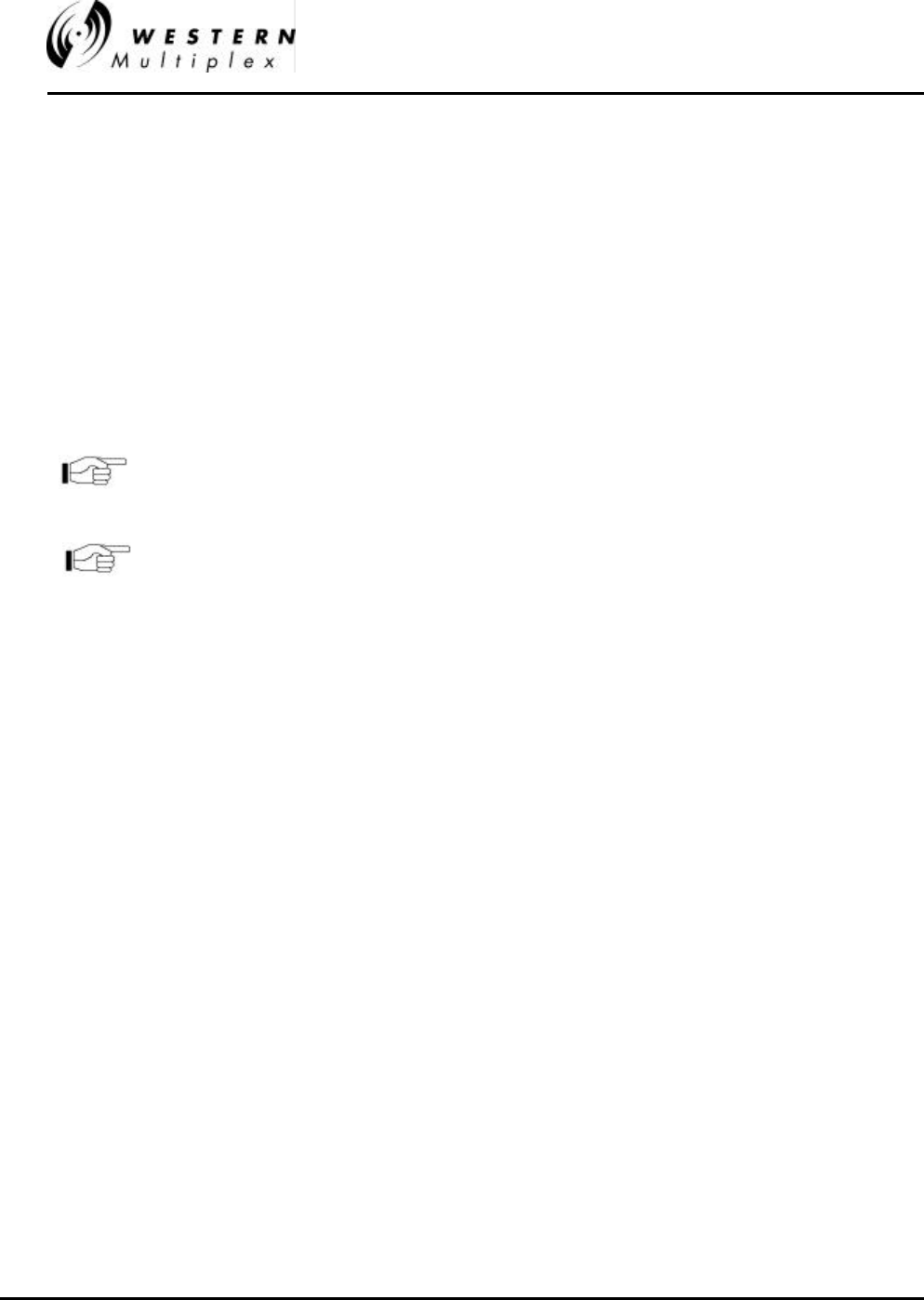
INSTALLATION AND MAINTENANCE MANUAL
Tsunami FAMILY
GIGABIT ETHERNET WIRELESS BRIDGES
JANUARY 2001
PAGE 4-10 SECTION 4: TROUBLESHOOTING
4.6 Back-to-Back Testing
Back-to-back testing, as shown in Figure 4-1, is an ideal method of testing the Tsunami radios.
This testing eliminates link problems caused by auxiliary equipment, installation, or the radio path
and isolates potential radio hardware problems. Back-to-back testing must be performed with both
radios at the same location. The following test equipment is required:
vDC power source capable of supplying approximately 250 Watts (total) to the radios.
vTwo coax couplings and 70dB loss attenuation per cable.
vBER tester
Back-to-back testing must be performed to verify a radio
problem before returning any radio to the factory for repair.
Use two coax cables and approximately 70dB attenuation per
cable
When the equipment is connected as shown in Figure 4-1, both Tsunami radios should have no
alarm conditions. If these conditions have been met, then it is likely that the Tsunami radio is
operating in accordance to specifications. If errors or alarms occur during this test, verify that all
configuration settings are properly set. If alarms or errors are still present, the radio is likely to be
faulty.
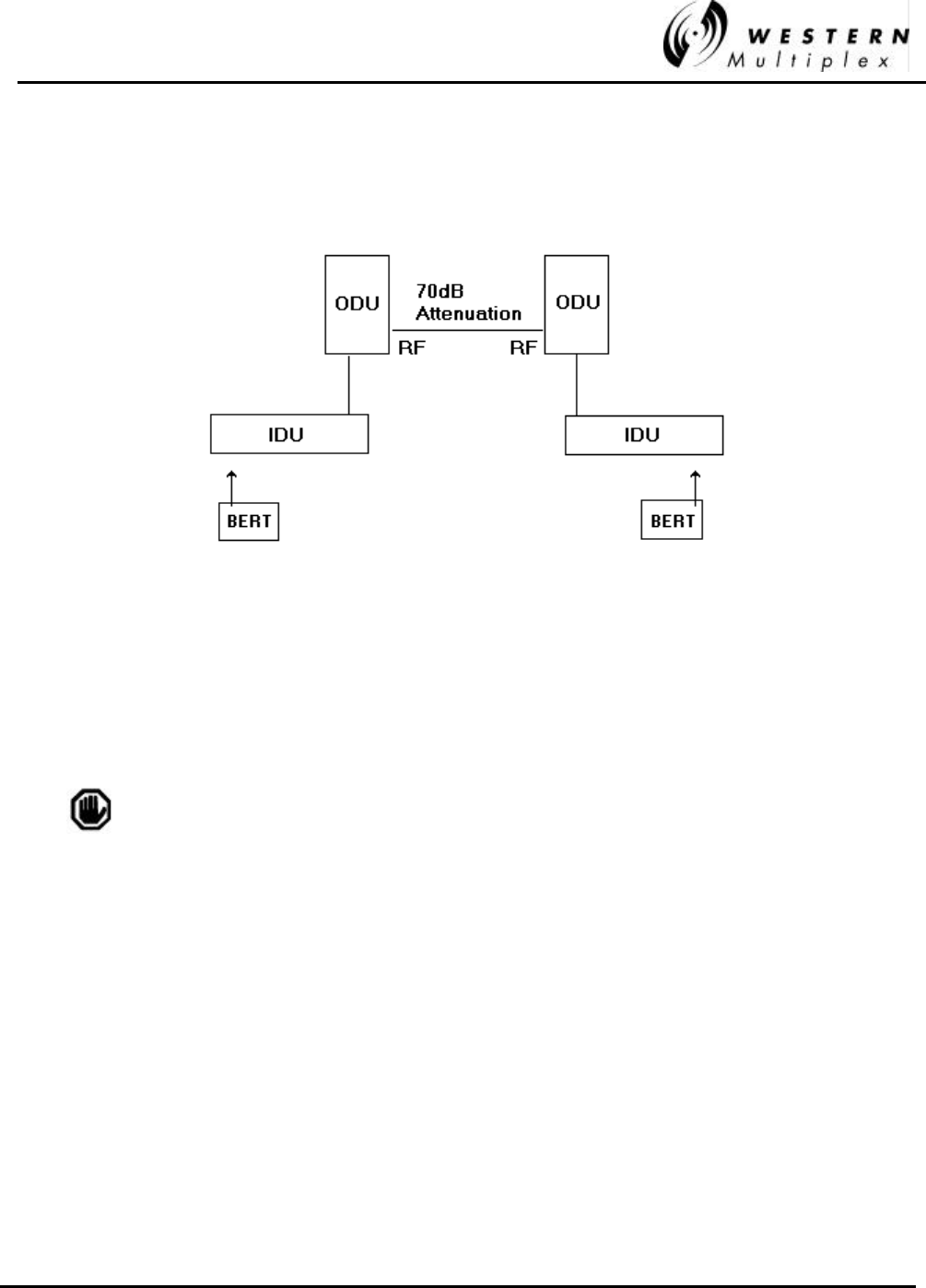
INSTALLATION AND MAINTENANCE MANUAL
Tsunami FAMILY
GIGABIT ETHERNET WIRELESS BRIDGES
JANUARY 2001
SECTION 4: TROUBLESHOOTING PAGE 4-11
Figure 4-1: Back-to-Back Test Configuration
The Tsunami radios will be damaged if appropriate attenuation is
not supplied between radios. You must provide a minimum of 40
dB and no more than 80 dB attenuation between the two radios.
Use this attenuation in EACH of the two connection cables!
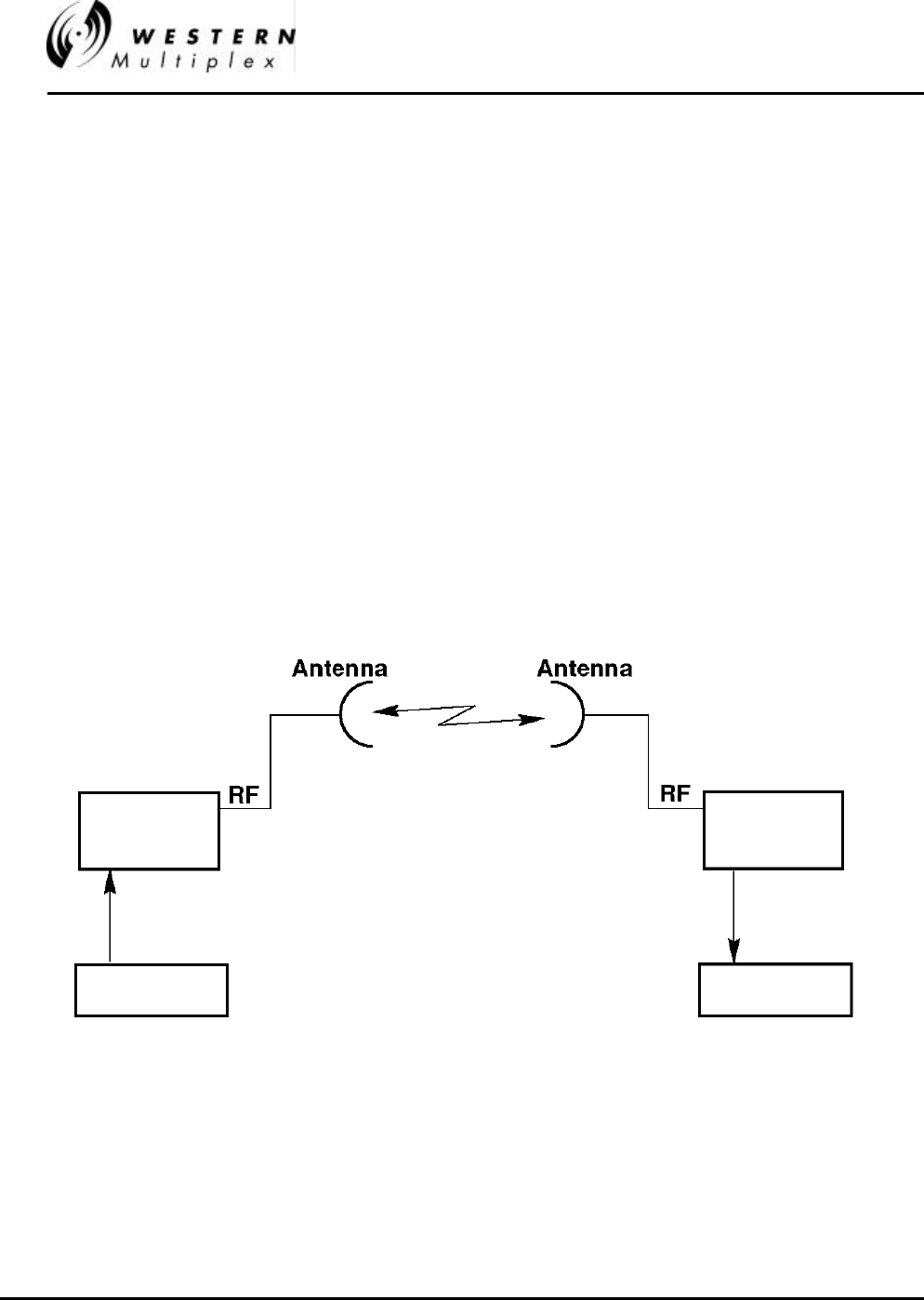
INSTALLATION AND MAINTENANCE MANUAL
Tsunami FAMILY
GIGABIT ETHERNET WIRELESS BRIDGES
JANUARY 2001
PAGE 4-12 SECTION 4: TROUBLESHOOTING
4.7 LINK Testing
Link testing is the preferred way to evaluate a radio link’s performance. It can be performed from
end-to-end or in link test mode (which tests both directions of the radio path). Figure 4-2 illustrates
a typical test configuration (which may include the radio’s path instead of in-line attenuators).
Figure 4-2 illustrates a typical test configuration for end-to-end testing.
When performing testing, make sure of the following:
- Disconnect all 1000BaseF inputs and outputs to both radios.
- Verify all configuration settings.
Link testing may be performed on the bench, with two terminals back to back, or over the radio
path. Also, it may be performed from end-to-end (which requires two 1000BaseF test sets over a
link, the far-end unit slaved to the near-end unit’s clock) or in loopback mode)
If link testing indicates an unacceptable level of errors, follow the instructions in Section 4.4.1. or
perform a back-to-back test.
Figure 4-2: End-to-End Test Configuration
Tsunami Tsunami
1000baseF
Tester
1000baseF
Tester

INSTALLATION AND MAINTENANCE MANUAL
Tsunami FAMILY
GIGABIT ETHERNET WIRELESS BRIDGES
JANUARY 2001
SECTION 4: TROUBLESHOOTING PAGE 4-13
4.8 Network Management System (NMS)
The Tsunami 1000BaseF radio platform provides multiple methods of managing the radio
network:
1) SNMP
2) Browser (IE, Netscape, etc.) graphical user interface
3) Software upgrade procedure
4) TelNet (via VT100 session using Windows Hyperlink)
4.8.1 SNMP
Use your favorite SNMP access software such as HP OpenView. Please contact customer
service/support to get a copy of the MIB file e-mailed to you or from our FTP site.
4.8.2 Browser GUI
Use Internet Explorer™ or Netscape™ to access the radio by typing in its IP address. If you are
setting up the radios for the first time, the default IP address is: 10.0.0.1 You will have to configure
your computer to this domain first by setting its address to 10.0.0.5 and then changing the radio’s
IP to one within the domain of your network. After changing one radio’s IP address (see
Configuration tab) change the other radio’s IP address also, but not to the same address of the
previous radio. Reconfigure the IP address of your computer to it’s original address and then
restart the PC so it is now in the same domain as the radios.
The browser interface shows a “virtual” front panel of the radio that is addressed. To view the front
panel of the associated far-end radio, click on the window that is located on the virtual front panel
(see following illustrations). Illustrations on the next few pages of this manual provide details on all
browser screens and operations.
4.8.3 In-band NMS Set-up
Use a 4-port (or larger) 100/1000 switch (recommended as opposed to a hub that will also work)
at each radio to operate the NMS in-band with the 100BaseT/F traffic. The NMS port can have a
unique domain that is valid only with the PC that is being used for network management and
system-wide operational status and will not interfere with 100BaseT/F traffic as the radio's MAC
address plus its IP address are unique.
Radios are set at the factory to IP addr: 10.0.0.1. Temporally set your PCs domain (write down its
present IP address) to a suggested setting of PC=10.0.0.5-the PC will force a re-boot. Re-boot
the PC computer attached to the first radio's 100BaseT NMS port and log-in to radio NMS
w/favorite browser (IE or Netscape) after log-in (manager:manager). Change the IP address
(Configuration) to an unused one in your domain (if you want to also change the password at this
time, do this first). Do the same with other radio (may have to reboot computer attached to this
other 10.0.0.1 radio as the other's MAC address does not match the MAC/IP address the PC
knows about). Set the IP address this radio to a different IP address in your normal operating
domain. Set your PC back to its original domain (will force reboot again). This should allow for
typical LAN operation. Type http://10.0.0.1/index.htm to gain initial access.
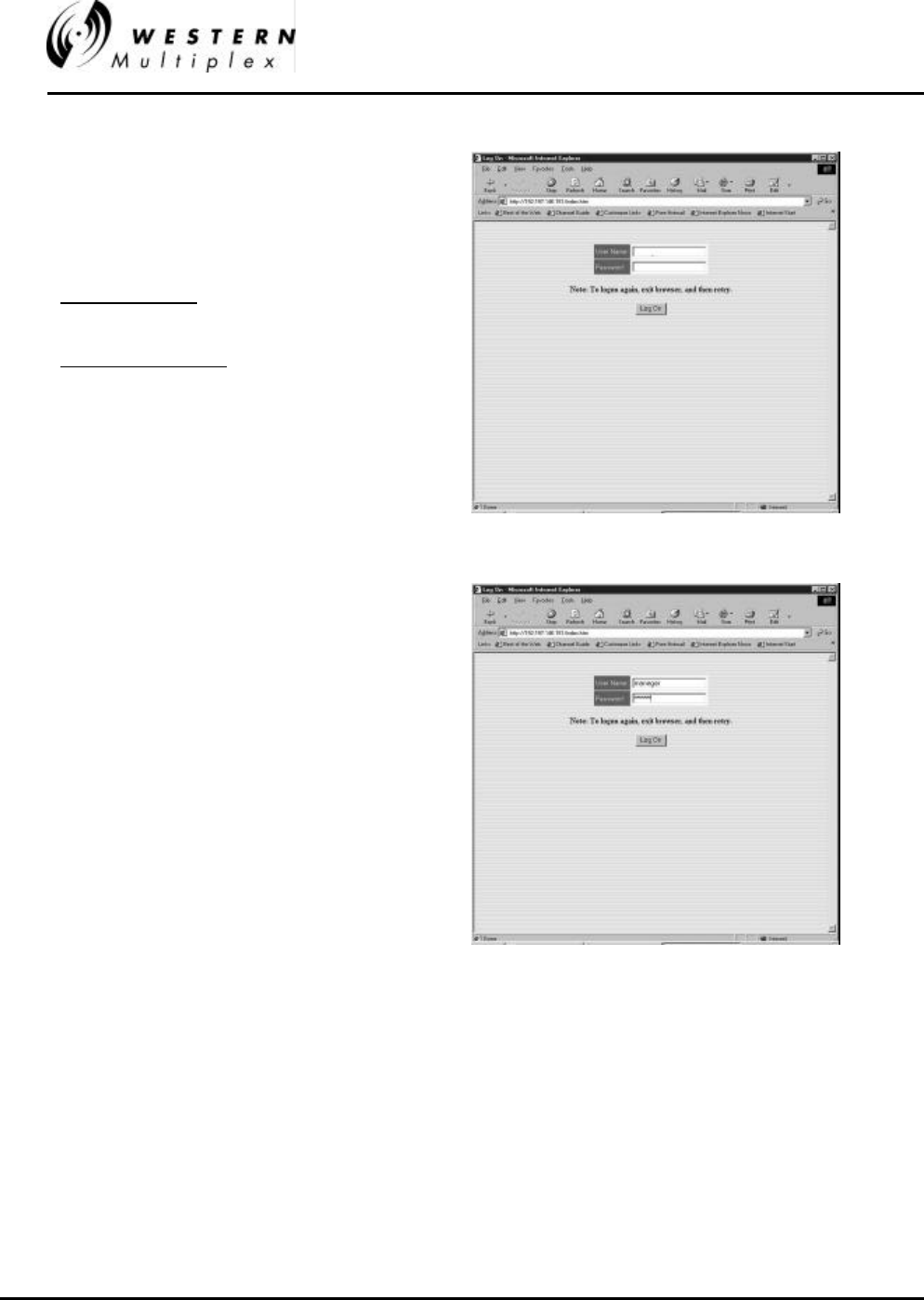
INSTALLATION AND MAINTENANCE MANUAL
Tsunami FAMILY
GIGABIT ETHERNET WIRELESS BRIDGES
JANUARY 2001
PAGE 4-14 SECTION 4: TROUBLESHOOTING
Login Screen 1
Enter User Name and Password. If using for
the first time or the radio has been reset, use:
Full User Rights:
User Name: manager
Password: manager
Limited User Rights:
User Name: operator
Password: operator
It’s advisable to change the password setting
on the administration (Admin) page to protect
radio settings, configuration and illegal entry
into the radio system.
Login Screen 2
With default Name and Password
Click on “Log On” to gain entry
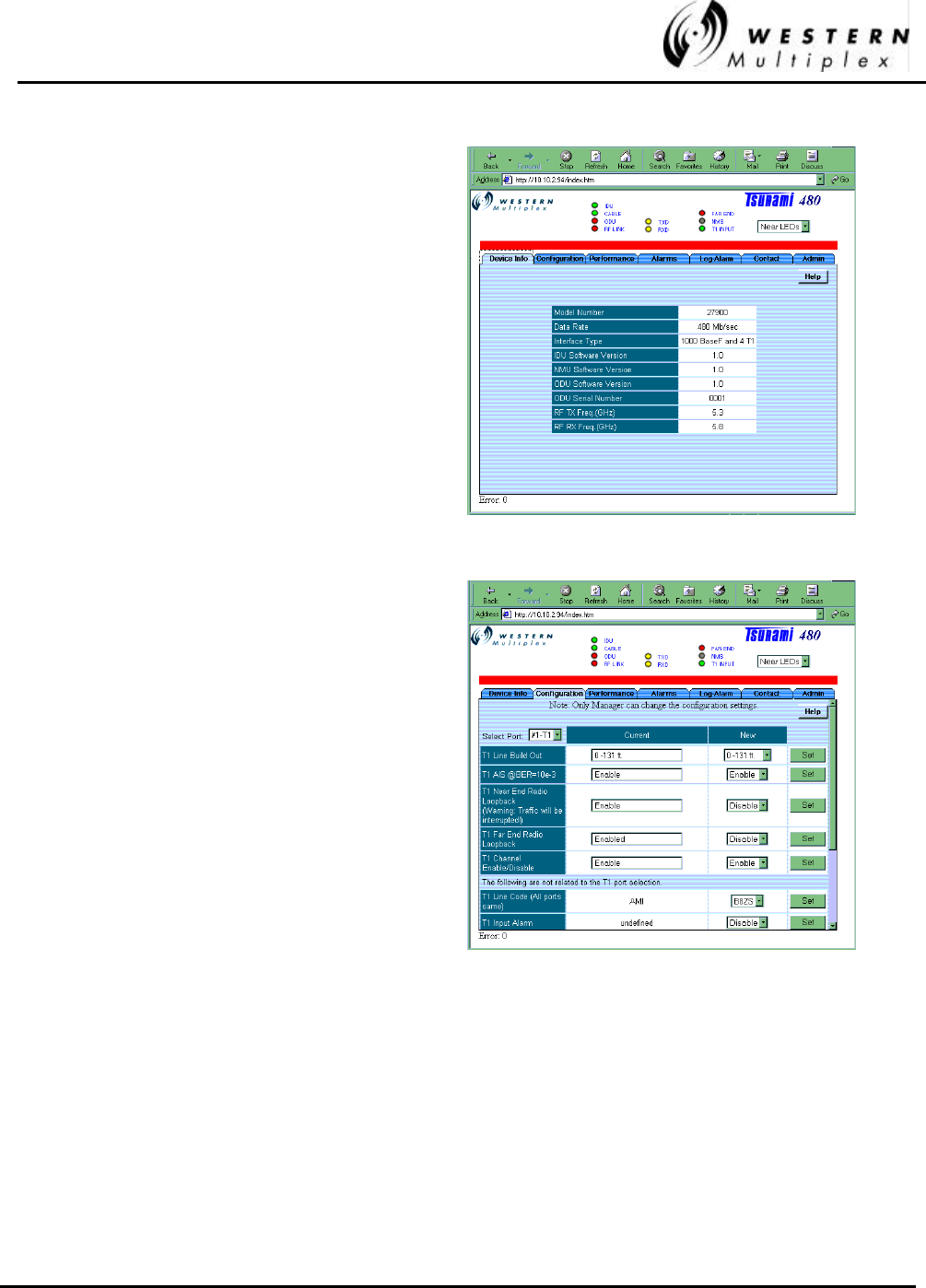
INSTALLATION AND MAINTENANCE MANUAL
Tsunami FAMILY
GIGABIT ETHERNET WIRELESS BRIDGES
JANUARY 2001
SECTION 4: TROUBLESHOOTING PAGE 4-15
Device Screen
Tsunami model information including software
revision versions and product serial number.
Configuration 1
The radio’s characteristics can be modified
from this page. The ‘Current’ column indicates
current settings and the ‘New’ column the radio
setting(s) that can be changed. Use the pull-
down menus to select the new setting. Then,
click on the Set button to invoke the setting.
In some cases it may be necessary to “refresh”
the screen to see changes to settings.
Warning: the Tx/Rx Frequency can not be
changed without also changing the physical
diplexer.
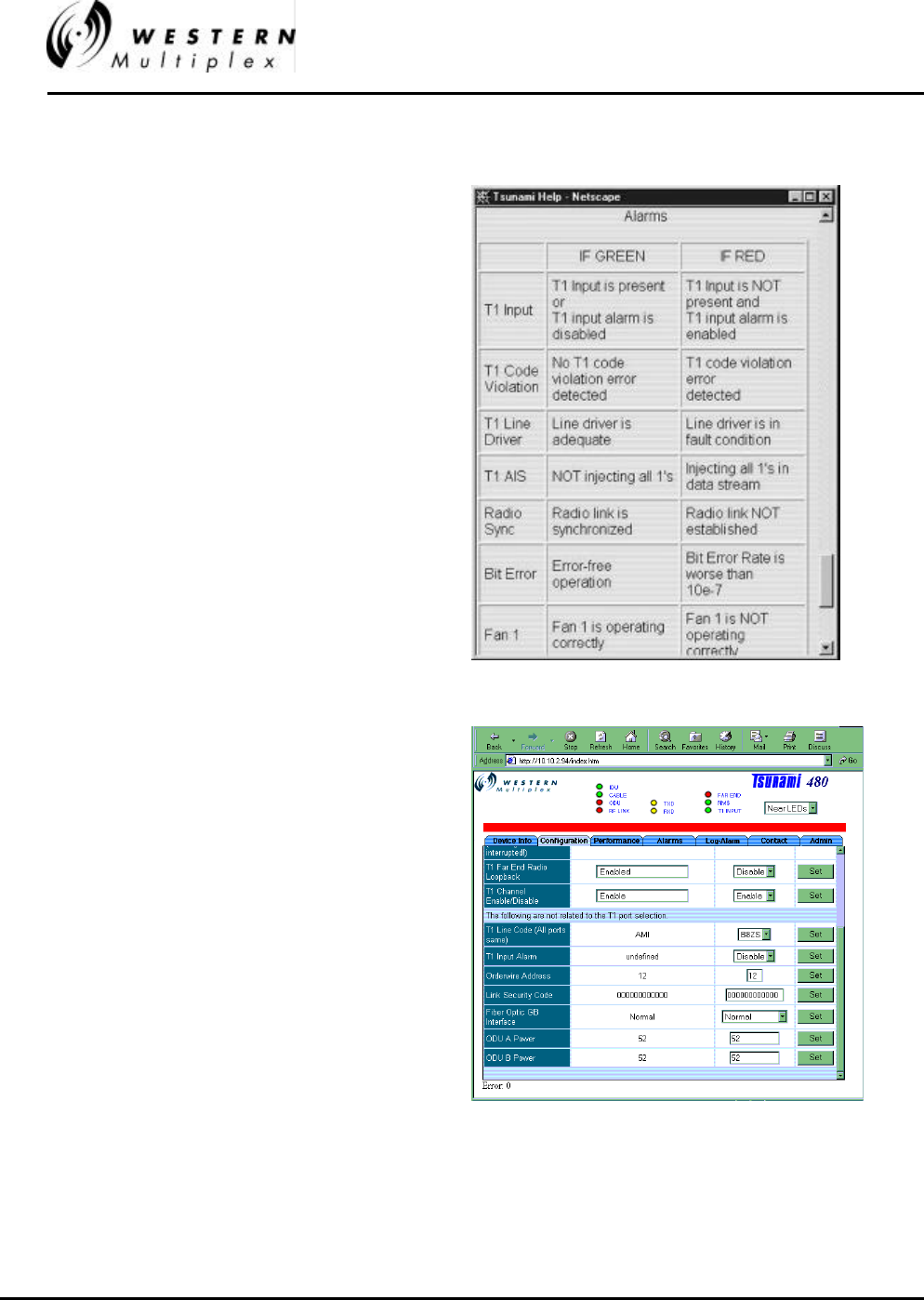
INSTALLATION AND MAINTENANCE MANUAL
Tsunami FAMILY
GIGABIT ETHERNET WIRELESS BRIDGES
JANUARY 2001
PAGE 4-16 SECTION 4: TROUBLESHOOTING
Help Screen
At any time, on any page, clicking on Help will
open a separate help window to facilitate
operation of the Browser NMS.
Use the help page to provide details on the
configuration settings.
Use the window close box to dispense with the
help screen when finished.
Configuration 2
Scroll down to see the complete list of radio
configuration settings.
Here is where the radio’s IP setting can be
modified from the factory default 10.0.0.1
Note: To return to defaults, power up the radio
while depressing the link test button and
holding until the LEDs flash RED.
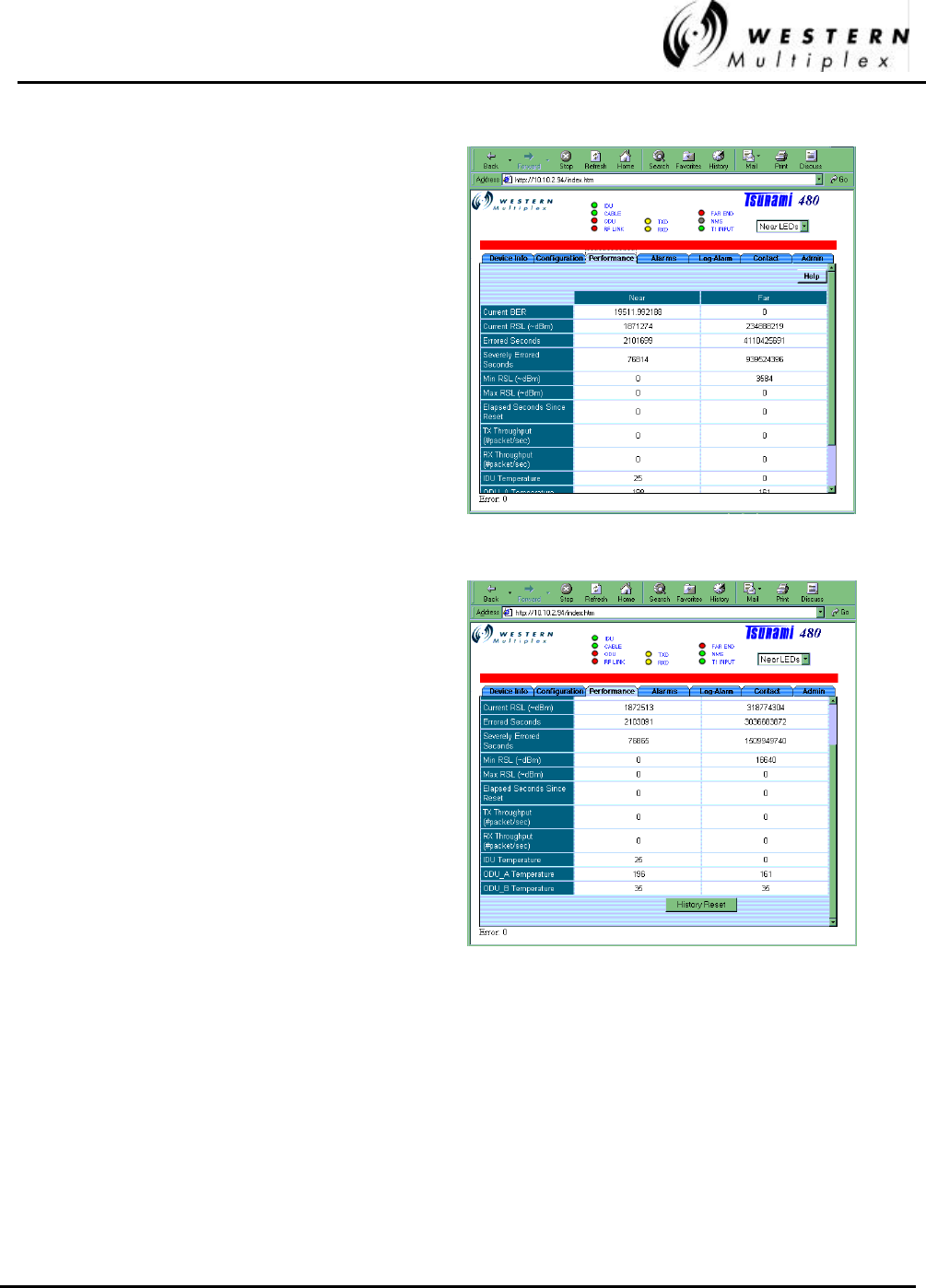
INSTALLATION AND MAINTENANCE MANUAL
Tsunami FAMILY
GIGABIT ETHERNET WIRELESS BRIDGES
JANUARY 2001
SECTION 4: TROUBLESHOOTING PAGE 4-17
Performance 1
Running data on the operation of the radio link.
To reset the historical data, click on History
Reset.
Note alarm bar between front panel depiction
and performance data.
Performance 2
New screen after resetting history.
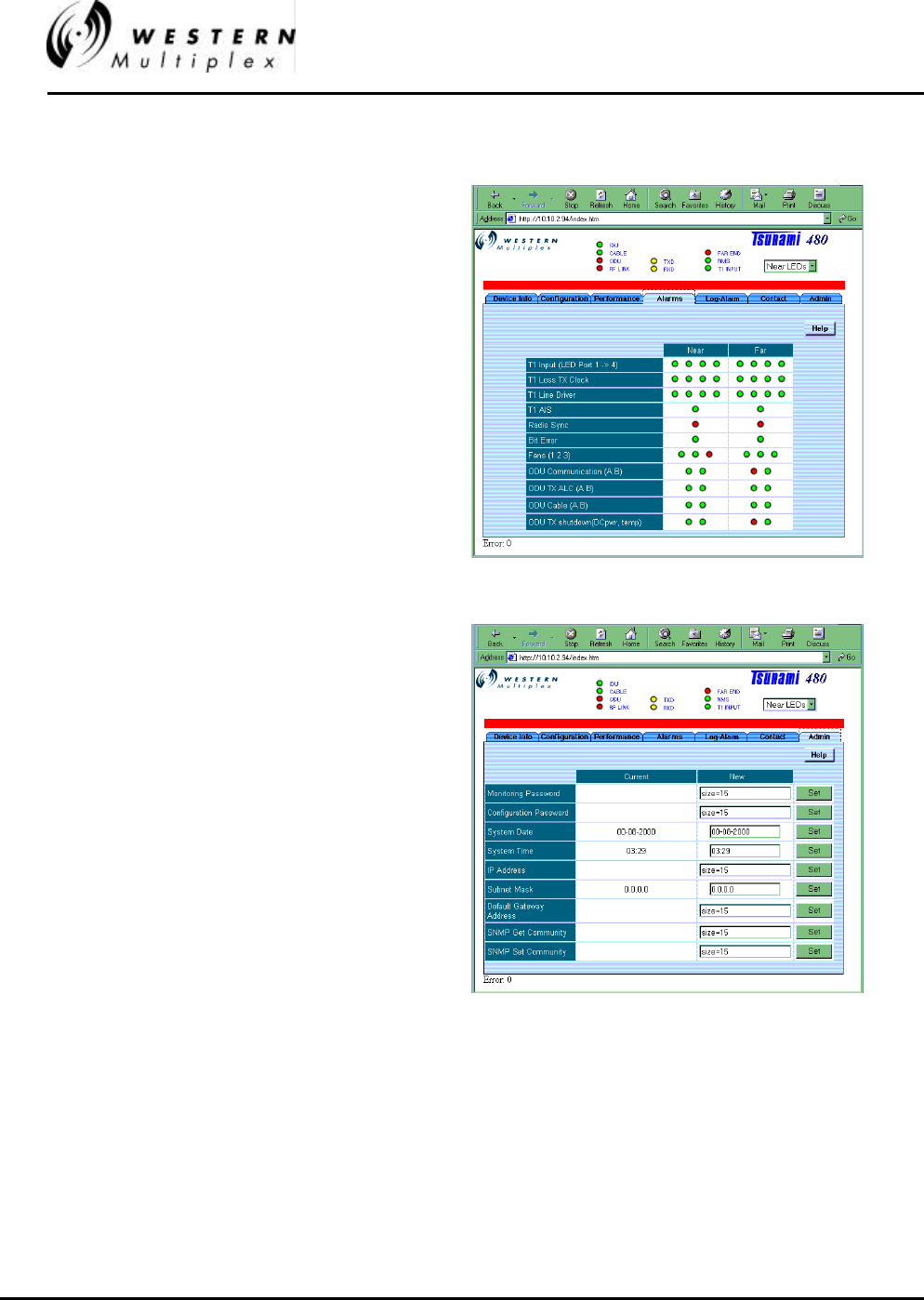
INSTALLATION AND MAINTENANCE MANUAL
Tsunami FAMILY
GIGABIT ETHERNET WIRELESS BRIDGES
JANUARY 2001
PAGE 4-18 SECTION 4: TROUBLESHOOTING
Alarms
Both near-end and Far-end information on the
running status of the link are displayed on this
single page.
Administration
Change the default password (manager or
operator) for subsequent entry into the browser
NMS.
Click on set after changing the password.
If you forget the password, you must fully reset
the radio by holding in the far-end button on the
front of the radio while powering it up.
Here is also where the IP address, subnet
mask, default gateway and SNMP community
information is located.
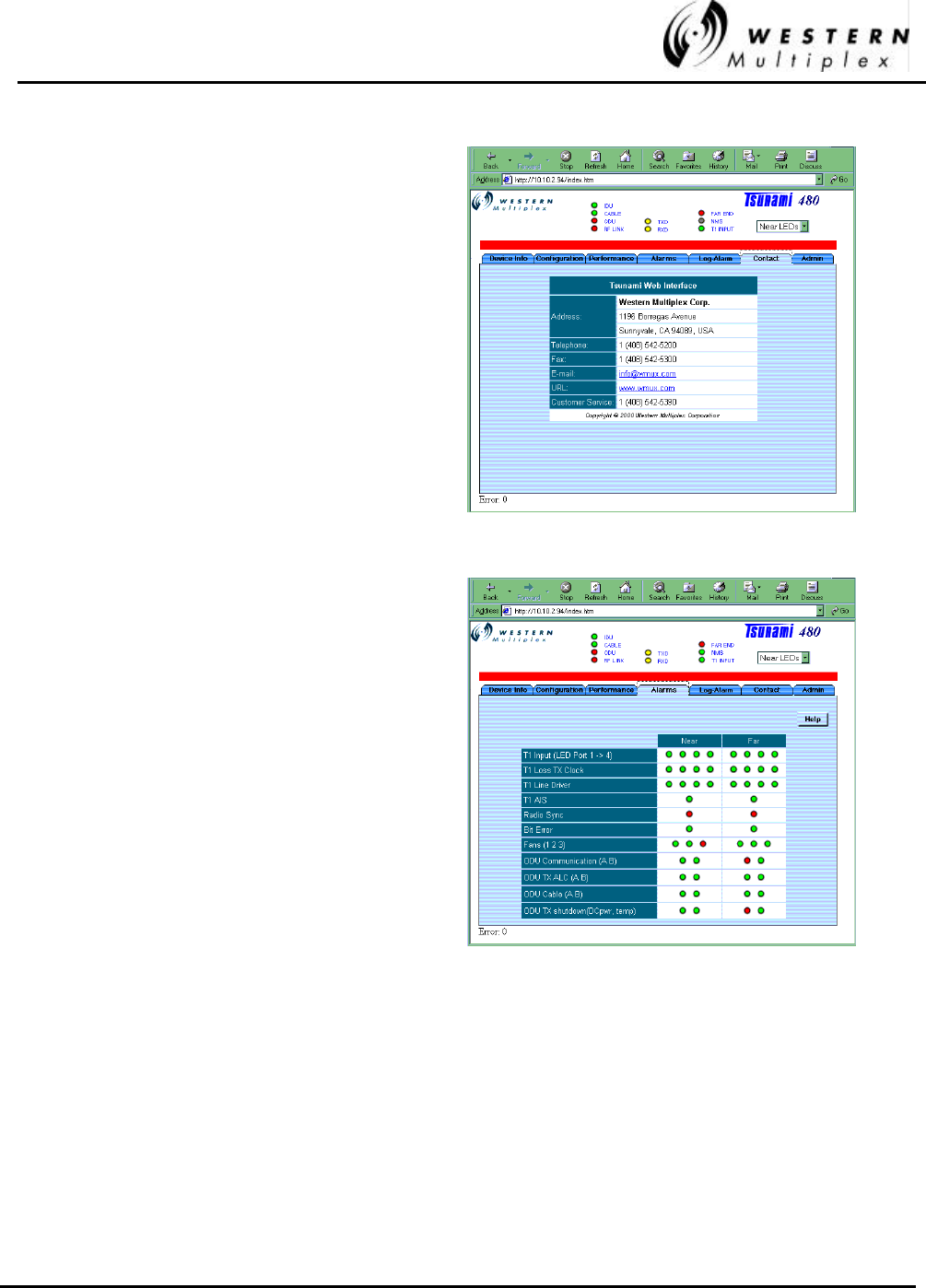
INSTALLATION AND MAINTENANCE MANUAL
Tsunami FAMILY
GIGABIT ETHERNET WIRELESS BRIDGES
JANUARY 2001
SECTION 4: TROUBLESHOOTING PAGE 4-19
Contact Information
The E-mail and the URL links are active text if
selected. Each will start your e-mail or browser
when either is clicked on.
Link failure indication!
If the link is lost, the severely errored seconds
will display the amount of time the link was not
passing sufficient data (see above).
In this example, the near-end radio lost sync
with the far-end radio.
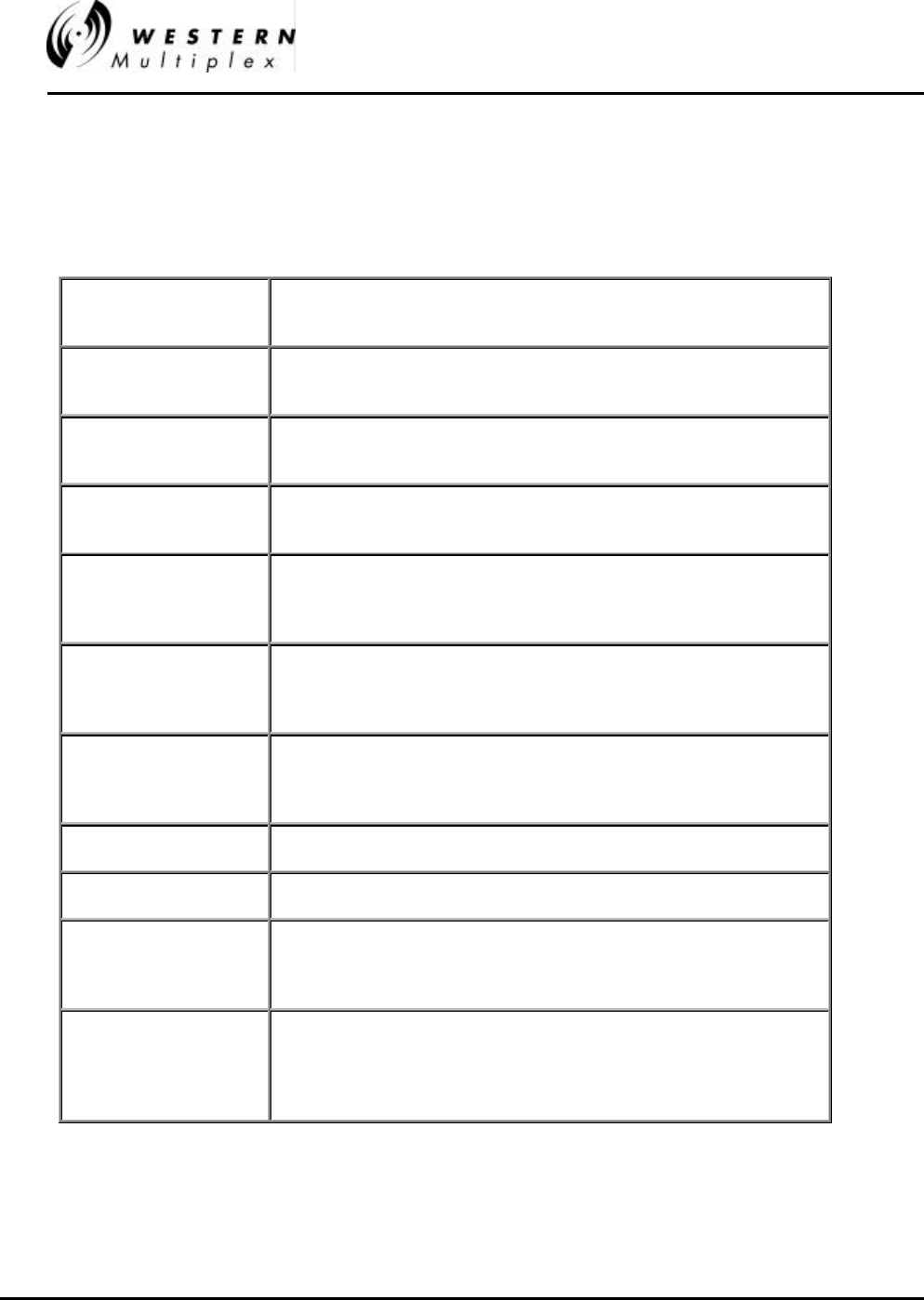
INSTALLATION AND MAINTENANCE MANUAL
Tsunami FAMILY
GIGABIT ETHERNET WIRELESS BRIDGES
JANUARY 2001
PAGE 4-20 SECTION 4: TROUBLESHOOTING
4.8.2.1 NMS Help screen details:
LEDs
IDU Green = Indoor Unit OK
Red = Indoor Unit detected hardware failure
Cable Green = ODU Cable OK
Red = ODU Cable shorted
ODU Green = Outdoor Unit OK
Red = Outdoor Unit detected hardware failure
Radio Fail Green = Radio hardware OK
Red = Hardware failure detected
RF Link Green = Error-free operation
Yellow = Bit errors occurring
Red = Excessive bit errors or radio link failure
TXD Green = 100BaseT data transmit present
Yellow = 100BaseT port connected (no data present)
Off = No 100BaseT connection detected
RXD Green = 100BaseT data receive present
Yellow = 100BaseT port connected (no data present)
Off = No 100BaseT connection detected
COLL Yellow = Collisions occurring on 100BaseT (half-duplex mode)
FAR END Red = Alarm(s) present on the far-end radio**
NMS (10BaseT) Green = Tx or Rx data present on the NMS interface
Yellow = NMS interface connected (no data present)
Off = No NMS interface connection detected
T1 INPUT
Green = Alarm enabled and T1 connection detected
Red = Alarm enabled and no T1 connection detected
Yellow = Alarm disabled and T1 connection detected
Off = Alarm disabled and no T1 connection detected
** Radio Fail, RF Link (yellow or red), T1 Input (yellow or red)

INSTALLATION AND MAINTENANCE MANUAL
Tsunami FAMILY
GIGABIT ETHERNET WIRELESS BRIDGES
JANUARY 2001
SECTION 4: TROUBLESHOOTING PAGE 4-21
Configuration
T1 Line Code AMI/B8ZS setting for the T1 interface
T1 Line Build Out T1 interface line length setting
T1 AIS @BER=10e-3 If selected, automatic injection of 1's into the T1
data stream during RF Link red alarm state
T1 Input Alarm If selected, activates alarm on loss of T1 signal
T1 Near-end Radio Loopback Activates loopback at the T1 input port of the near-end,
towards the far-end of the link
T1 Far-end Radio Loopback Activates loopback at the T1 input port of the far-end,
towards the near-end of the link
Orderwire Address Orderwire telephone address (any 2 digit number 00-99)
Link Security Code
Security code set by user (any 6 bytes=12 characters)
Valid characters are 0-9, A-F only (2 to the 48th codes)
Note: Must match code on far-end radio to establish link
Example: 3A45EBA27F65 or BDAF3976D2C5
Tx/Rx Frequency Selects Tx and Rx frequencies – setting must match
installed diplexer filter assembly – see manual for details
Ethernet Duplex Selects half or full duplex for the 100BaseT interface
Learning Filter Enables the ability to acquire and store IP addresses
for efficient bridging operation (normally enabled)
Fiber Optic Interface Enables the fiber 100BaseT interface
Device IP Address Configure the IP address for the network
management Ethernet interface
Device Subnet Mask Configure the subnet mask for the network
management Ethernet interface
SNMP Get Community Configure the ‘Get’ community string for the radio's
SNMP network management agent
SNMP Set Community Configure the ‘Set’ community string for the radio's
SNMP network management agent

INSTALLATION AND MAINTENANCE MANUAL
Tsunami FAMILY
GIGABIT ETHERNET WIRELESS BRIDGES
JANUARY 2001
PAGE 4-22 SECTION 4: TROUBLESHOOTING
Performance
Current BER Current estimated RF link bit error rate
Current RSL (dBm) Current estimated received signal level, in dBm
Errored Seconds Number of seconds that incurred an error since the last reset
of the "clear history" function. Indicates errored packets.
Severely Errored Seconds Number of seconds that incurred errors in excess of
BER=10e-6 since the last reset of the "clear history" function
Usually indicates total loss of data/packets, not just errors
Min RSL (dBm) Minimum estimated received signal level (in dBm) measured
since the last reset of the "clear history" function
Max RSL (dBm) Maximum estimated received signal level (in dBm) measured
since the last reset of the "clear history" function
Elapsed Seconds Since Reset Number of seconds since the last reset of the "clear history"
function
Alarms
IF GREEN IF RED
T1 Input T1 Input is present or
T1 input alarm is disabled T1 Input is NOT present and
T1 input alarm is enabled
T1 Code
Violation No T1 code violation error detected T1 code violation error detected
T1 Line Driver Line driver is adequate Line driver is in fault condition
T1 AIS NOT injecting all 1s Injecting all 1s in data stream
Radio Sync Radio link is synchronized Radio link NOT established
Bit Error Error-free operation Bit Error Rate worse than 10e-7
Fan 1 Fan 1 is operating correctly Fan 1 is NOT operating correctly
Fan 2 Fan 2 is operating correctly Fan 2 is NOT operating correctly
Rx Synth Receive synthesizer is locked Receive synthesizer NOT locked
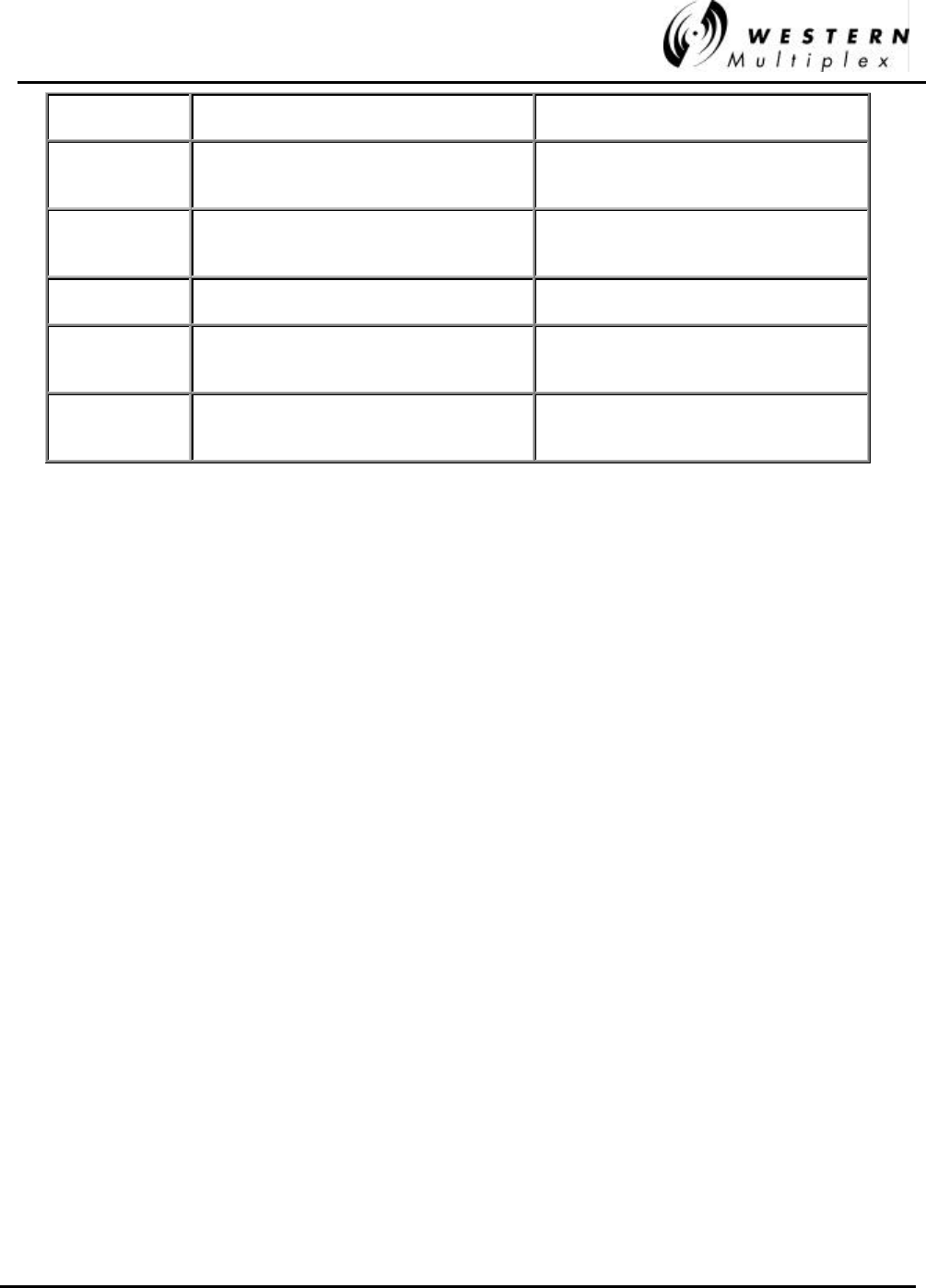
INSTALLATION AND MAINTENANCE MANUAL
Tsunami FAMILY
GIGABIT ETHERNET WIRELESS BRIDGES
JANUARY 2001
SECTION 4: TROUBLESHOOTING PAGE 4-23
Tx Synth Transmit synthesizer is locked Transmit synthesizer NOT locked
ODU PLO
Alarm ODU Phase Lock Loop is locked ODU PLL is not locked
ODU
Synth Alarm ODU Synthesizer is locked ODU Synthesizer is NOT locked
ODU Comm ODU is communicating w/IDU ODU NOT communicating w/IDU
ODU
PWS15V 15V Power Supply is normal 15V Power Supply is out of range
ODU
Cable Alarm ODU Cable is normal ODU Cable is shorted

INSTALLATION AND MAINTENANCE MANUAL
Tsunami FAMILY
GIGABIT ETHERNET WIRELESS BRIDGES
JANUARY 2001
PAGE 4-24 SECTION 4: TROUBLESHOOTING
4.8.4 Software Update Download Procedure
Software download procedure on Tsunami 100 (second release V 2.0):
1) Connect the host PC tot the radio terminal through the NMS 10BaseT port.
2) Point the browser to the radio's Web page "http//xxx.xxx.xxx.xxx/upload.htm".
(For factory default use 10.0.0.1 for the http: address)
3) Login as "manager" for name and password on the GUI prompt.
4) Follow the instructions on the screen.
a) Enter the file name you want to upload, e.g. (a:ts_nmu.udl software bianary image
file), or select the browse button and point to the proper location.
b) While the file name is displayed on the screen, select the install button.
c) It will display a status child window indicating it is erasing and writing to the unused
Bank.. (Note the Bank # for ref.)
d) After it is complete, you will see this message "File upload finished and system will
reboot! Restart browser to logon again"
e) Now, you can re-enter the upload GUI and insure the new uploaded Bank is valid
and is the current Bank in use.
Memory Banks:
The radio has two banks of flash memory available, Bank 0 and Bank 1, only one bank will be in
use at a time. The radio will automatically utilize the new uploaded bank.
In addition, through the procedure, you can also manually select Bank 0 or Bank 1 by selecting
the (switch) button. Switching between Banks is quick and you will need to re-start the browser.
Also, to determine if a flash memory Bank has any software, you can read the Bank status. E.g.
Valid or invalid, invalid indicating that it is an empty memory Bank.

INSTALLATION AND MAINTENANCE MANUAL
Tsunami FAMILY
GIGABIT ETHERNET WIRELESS BRIDGES
JANUARY 2001
SECTION 4: TROUBLESHOOTING PAGE 4-25
4.8.5 Telnet
Use a standard TELNET session (i.e. Windows Hyperlink). Program will emulate a VT100
monitor. Plug into the radio’s CONFIGuration port.
Set the session to an unused COM port (e.g. COM1) and use 19,200 baud, 8 bits, No parity and
One stop bit. Cable is two (2) DB-9F connectors with pins 2-3, 3-2 and 5-5 using 3 conductor wire.
To start a session (type what is within the single quotes and then the Enter key):
Hit the PC’s CR/Enter key two (2) times after the radio has reinitialized
Type ‘1’ and CR/Enter to enter the User Name and then Enter key (factory default=manager)
Type ‘2’ and CR/Enter to enter the Password and then the Enter key (factory default=manager)
Type ‘a’ and Enter Key to accept the two entries - you should now see a menu list (a=accept)
Any time you wish to go back to a previous screen, type ‘o’ for out (if an ‘o’ does not exit from the
page you working from, use ‘logout’ to exit).
There are many user changeable functions that may not be present in the browser such as setting
the “Default Gateway” if the radio’s NMS port is connected through a router.
As an example, the following steps can be used to check the radio’s Network Status:
From the NMU Main Menu, type 3 and Enter.
Note the radio’s IP address, subnet mask, MAC address and other radio parameters.
Example 2: Set a Default Gateway:
From the main menu (after logging in), type ‘11‘ to get to the VxWorks Shell prompt (->).
Type ‘help’ to get a list of all the advanced commands. Use the Enter key or ‘Q’ to complete.
From the -> prompt, type ‘netHelp’ to see a list of the network help commands
(Use Enter key or ‘Q’ to quit/stop).
From the -> prompt, type ‘nmuHelp’ to see a list of the nmu (Network Management Unit)
commands (Use Enter key or ‘Q’ to quit/stop).
From the -> prompt, type ‘staticShow’ to check to see if there is a current Default Gateway already
set (if set, you may want to write down the settings for future re-use).
Type ‘staticAdd’ to get to the Default Gateway setup command. Note the example.

INSTALLATION AND MAINTENANCE MANUAL
Tsunami FAMILY
GIGABIT ETHERNET WIRELESS BRIDGES
JANUARY 2001
PAGE 4-26 SECTION 4: TROUBLESHOOTING
You can always type ‘help’ to get the appropriate help for the area you are accessing.
Follow the guidelines to set the Default Gateway command string:
For example: staticAdd “0.0.0.0”, “100.0.0.111”, “255.255.255.0”
Check to confirm that the Default Gateway has been set properly by typing ‘staticShow’ again
When done with the TELNET session, type ‘o’ or ‘logout’ until back to the Name-Password entry
page you started from.
To print a complete list of available functions, type ‘help’ from a main menu screen and then print
the page to your default printer connected to your PC.

INSTALLATION AND MAINTENANCE MANUAL
Tsunami FAMILY
GIGABIT ETHERNET WIRELESS BRIDGES
JANUARY 2001
SECTION 4: TROUBLESHOOTING PAGE 4-27
Your Notes on the Tsunami Radio
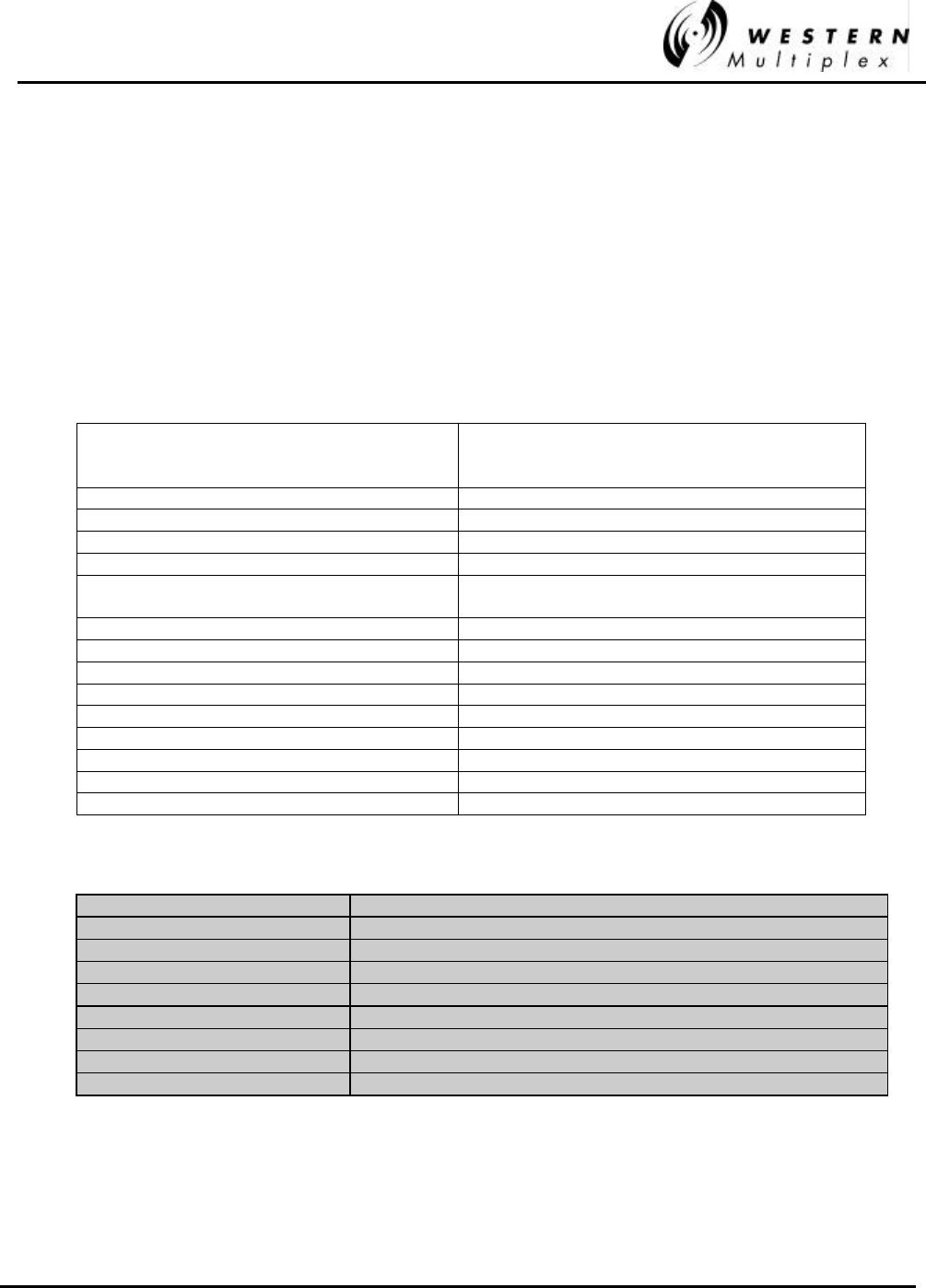
INSTALLATION AND MAINTENANCE MANUAL
Tsunami FAMILY
GIGABIT ETHERNET WIRELESS BRIDGES
JANUARY 2001
SECTION 5: APPENDICES PAGE 5-1
5. Appendices
Appendix A - Digital Interface Specifications
1. General Characteristics (Regulatory)
1000baseF (IEEE 802.3u) Fully compliant to Ethernet V.2
Model Model 27200-G1XX
Tsunami 5.3/5.8 GHz 1000BaseF Ethernet
Bridge
Manufacturer Western Multiplex Corp.
Frequency Band 5.3 and 5.8 GHz bands
Identifier HZB-U5358-1000
Emission Designator UNII
Transmitter Power Output 5.3 band: +10 dBm (~15 mW)
5.8 band: +17 dBm (50 mW)
Tolerance (%) 0.001
Baseband Type Signal Digital
Maximum Channel Capacity Both channels
Digital Modulation Rate 50.791 Mbps
Digital Modulation 16 QAM or 32 QAM
Automatic Power Control No
Receive Threshold at BER = 1 x 10-6 -77 dBm
RF Bandwidth 100 MHz each band, both polarizations
Table A-1: Regulatory Information
2. Specifications
Transmission Medium UTP
Signaling Technique Manchester
Topology Star
LAN Table 1,024 addresses (automatic learning and aging)
Filtering 15,000 pps
Data Rate Up to throughput of particular radio model
Delay 2-5 frames
Buffer 400 packets
Duplex Full
Table A-2: Interconnection Specification

INSTALLATION AND MAINTENANCE MANUAL
Tsunami FAMILY
GIGABIT ETHERNET WIRELESS BRIDGES
JANUARY 2001
PAGE 5-2 SECTION 5: APPENDICES
Appendix B – Networking Q&As
Q: What is Ethernet?
A: Ethernet is a type of network cabling and signaling specifications (OSI Model layers 1
[physical] and 2 [data link]) originally developed by Xerox in the late 1970. The IEEE's
(Institute of Electrical and Electronics Engineers) used Ethernet Version 2 as the basis for the
802.3 CSMA/CD network standard.
Q: What is an 802.3 network?
A: That's IEEE-ish for Ethernet.
Q: What is CSMA/CD?
A: CSMA/CD is the media access control mechanism used by Ethernet and 802.3 networks;
in other words, it determines how a packet of data is placed on the wire. CSMA/CD
stands for "Carrier Sense Multiple Access, with Collision Detection". Before an Ethernet
device puts a packet "on the wire", it listens to find if another device is already
transmitting. Once the device finds the wire is clear, it starts sending the packet while also
listening to hear if another device started sending at the same time (which is called a
collision). Refer to the Q&A on collisions for more info about this phenomena.
Q: What is an OSI Model?
A: The Open Systems Interconnect (OSI) reference model is the ISO (International
Standards Organization) structure for the "ideal" network architecture. This Model outlines
seven areas, or layers, for the network. These layers are (from highest to lowest):
LAYER
7) Applications: Where the user applications software lies. Such issues as file access
and transfer (FTP), virtual terminal emulation, Internet connections (HTTP), inter-
process communication and the like are handled here.
6) Presentation: Differences in data representation are dealt with at this level. For
example, UNIX-style line endings (CR only) might be converted to MS-DOS style
(CRLF), or EBCIDIC to ASCII character sets.
5) Session: Communications between applications across a net- work is controlled at
the session layer. Testing for out-of-sequence packets and handling two-way
communication are handled here.
4) Transport: Makes sure the lower three layers are doing their job correctly, and
provides a transparent, logical data stream between the end user and the network
service s/he is using. This is the lower layer that provides local user services.
3) Network: This layer makes certain that a packet sent from one device to another
actually gets there in a reasonable period of time. Routing and flow control are
performed here. This is the lowest layer of the OSI model that can remain ignorant of
the physical network.

INSTALLATION AND MAINTENANCE MANUAL
Tsunami FAMILY
GIGABIT ETHERNET WIRELESS BRIDGES
JANUARY 2001
SECTION 5: APPENDICES PAGE 5-3
2) Data Link: This layer deals with getting data packets on and off the physical layer,
error detection and correction and retransmission. This layer is generally broken into
two sub-layers: The LLC (Logical Link Control) on the upper half, which does the error
checking, and the MAC (Medium Access Control) on the lower half, which deals with
getting the data on and off the physical layer (wire, fiber and Tsunami Wireless
Bridges).
1) Physical: The nuts and bolts layer. Here is where the cable, fiber, radio, connector
and signaling specifications are defined.
Q: What does an Ethernet packet look like?
A. See the information below, as described in the National Databook. The Ethernet packet
preamble is normally generated by the chipset. Software is responsible for the destination
address, source address, type, and data. The chips normally will append the frame check
sequence.
+------------+
| | Preamble –
| 62 bits | A series of alternating 1's and 0's used by the
| | Ethernet receiver to acquire bit synchronization.
| |
+------------+
| | Start Of Frame Delimiter –
| 2 bits | Two consecutive 1 bits used to acquire byte
| | alignment.
+------------+
+------------+
| | Destination Ethernet Address –
| 6 bytes | Address of the intended receiver.
| | The broadcast address is all 1's.
+------------+
| | Source Ethernet Address –
| 6 bytes | The unique Ethernet address of the sending
| | station.
+------------+
| | Length or Type field –
| 2 bytes | For IEEE 802.3 this is the number of bytes of
| | data.
+------------+
| 46 bytes | Data –
| to | Short packets must be padded to 46 bytes.
| 1500 bytes |
+------------+
+------------+
| | Frame Check Sequence(CRC) -
| 4 bytes | The FCS is a 32 bit CRC calculated using
| | the AUTODIN II polynomial.
+------------+
The shortest packet is: 6 + 6 + 2 + 46 = 60 bytes The longest packet is: 6 + 6 + 2 + 1500
= 1514 bytes
Q: What is a MAC address?
A: It is the unique hexadecimal (numbering base 16) serial number assigned to each
Ethernet network device to identify it on the network.. With Ethernet devices (as with most

INSTALLATION AND MAINTENANCE MANUAL
Tsunami FAMILY
GIGABIT ETHERNET WIRELESS BRIDGES
JANUARY 2001
PAGE 5-4 SECTION 5: APPENDICES
other network types), this address is permanently set at the time of manufacturer, though
it can usually be changed through software (though this is generally a Very Bad Thing to
do).
Q: Why must the MAC address to be unique?
A: Each communicating end device (not bridges) has a unique MAC address, so that it will
be able to exclusively grab packets off the network meant for it. If MAC addresses are not
unique, there is no way to distinguish between two devices. Devices on the network watch
network traffic and look for their own MAC address in each packet to determine whether
they should decode it or not. Special circumstances exist for broadcasting to every
device.
Q: Is there a special numbering scheme for MAC addresses?
A: The MAC addresses are exactly 6 bytes in length, and are usually written in hexadecimal
as 12:34:56:78:90:AB (the colons may be omitted, but generally make the address more
readable). Each manufacturer of Ethernet devices applies for a certain range of MAC
addresses they can use. The first three bytes of the address determine the manufacturer.
RFC-1700 (available via FTP) lists some of the manufacturer-assigned MAC addresses.
A more up-to-date listing of vendor MAC address assignments is available on
ftp.lcs.mit.edu in pub/map/Ethernet-codes.
Q: What does CRC mean?
A: Cyclical Redundancy Check - A method of detecting errors in a message by performing a
mathematical calculation on the bits in the message and then sending the results of the
calculation along with the message. The receiving work-station performs the same
calculation on the message data as it receives it and then checks the results against
those transmitted at the end of the message. If the results don't match, the receiving end
asks the sending end to send again.
Q: What do 10Base5, 10BaseT, 10Base2, etc mean?
A: These are the IEEE names for the different physical types of Ethernet. The "10" stands
for maximum signaling speed: 10MHz. "Base" means Baseband. 10BaseT, where the T
means twisted pair, and 10BaseF where the F means fiber (see the following Q&A for
specifics). This actually comes from the IEEE committee number for that media.
In actual practice:
10Base2 Is a maximum of 10MHz Ethernet running over thin, 50 Ohm baseband coaxial
cable. 10Base2 is also commonly referred to as thin-Ethernet or Cheapernet. 10Base5 is
10MHz Ethernet running over standard (thick) 50 Ohm baseband coaxial cabling.
10BaseF is Ethernet running over fiber-optic cabling. 10BaseT is Ethernet running over
unshielded, twisted-pair cabling.
Q: What is UTP?
A: Twisted pair cables. UTP is for Unshielded, Twisted Pair, while STP is for Shielded,

INSTALLATION AND MAINTENANCE MANUAL
Tsunami FAMILY
GIGABIT ETHERNET WIRELESS BRIDGES
JANUARY 2001
SECTION 5: APPENDICES PAGE 5-5
Twisted Pair. UTP is what's typically installed by phone companies (though this is often
not of high enough quality for high- speed network use) and is what 10BaseT Ethernet
runs over. UTP is graded according to its data carrying ability (e.g., Level 3, Level 4, Level
5). 10BaseT Ethernet requires at least Level 3 cable. Many sites now install only Level-5
UTP (CATegory 5), even though level 4 is more than sufficient for 10BaseT, because of
the greater likelihood that emerging high-speed standards will require cable with better
bandwidth capabilities.
Q: Are there any restrictions on how Ethernet is cabled?
A: Yes, there are many, and they vary according to the media used. First of all, there are
distance limitations: 10BaseT generally accepted to have a maximum run of 100-150M,
but is really based on signal loss in dB's (11.5db maximum loss source to destination).
Then there are limitations on the number of repeaters and cable segments allowed
between any two stations on the network.
The rule is, any possible path between two network devices on an unbridged/unrouted
network cannot pass through more than 4 repeaters or hubs, nor more than 3 populated
cable segments. 10BaseT and 10BaseF are star-wired, so there is no minimum distance
requirement between devices, since devices cannot be connected serially. You can install
up to the Ethernet maximum of 1024 stations per network with both 10BaseT and
10BaseF.
Q: When should I choose BaseT, BaseF (or others)?
A: The specific environment and application must be considered when selecting your media
type. However, there are some general rules-of-thumb that you can consider:
Avoid using copper between buildings. The electrical disturbances caused by lightning, as
well as naturally occurring differences in ground potential over distance, can very quickly
and easily cause considerable damage to equipment and people. The use of fiber-optic
cabling between buildings eliminates network cabling as a safety risk. There are also
various wireless media available for inter-building links, such as laser, spread-spectrum
RF and microwave.
10BaseT is the most flexible topology for LANs, and is generally the best choice for most
network installations. 10/100/1000BaseT hubs, or multi-hub concentrators, are typically
installed in a central location to the user community, and inexpensive UTP cabling is run
to each network device (which may be 100m, or 330ft, from the hub). The signaling
technology is very reliable, even in somewhat noisy environments, and 1 hubs will usually
detect many network error conditions and automatically shut-down the offending port(s)
without affecting the rest of the network (unless, of course, the offending port was your
server, shared printer, or router to the rest of the world.
100/1000BaseF, and its predecessor, FOIRL, are the only recommended topologies for
inter-building links. However, they need not be limited to this role. 100/1000BaseF can
also be run to the desktop, though the cost is prohibitively high in all but the most
specialized environments (generally, extremely noisy manufacturing facilities, or very
security-conscious installations). More commonly, FOIRL (and now, 10BaseF) is used
inside buildings and long distance wireless connections to form backbone networks.
Q: Is there an official "standard" punch down scheme for 10BaseT?

INSTALLATION AND MAINTENANCE MANUAL
Tsunami FAMILY
GIGABIT ETHERNET WIRELESS BRIDGES
JANUARY 2001
PAGE 5-6 SECTION 5: APPENDICES
A: Get a copy of EIA/TIA-568, it covers all of that sort of stuff: horizontal, vertical,
connectors, patch cords, cross-connects, etc.
Q: Is it safe to run Unshield Twisted Pair next to power cable?
A: According to EIA/TIA-569, the standard wiring practices for running data cabling and
companion to the above referenced EIA/TIA-568, you should not run data cable parallel to
power cables. However, in reality, this should not be a problem with networks such as
10BaseT. 10BaseT uses differential signaling to pick the data signals off the wire. Since
any interference from nearby power lines will usually affect all pairs equally, anything that
is not canceled-out by the twists in the UTP should be ignored by the receiving network
interface.
Q: Can I connect the 10BaseT interface of two devices directly together, without using a hub?
A: Yes, but not more than 2 devices, and you also need a special jumper cable between the
two 10BaseT ports:
RJ45 pin RJ45 pin
======== ========
1 <--[TX+]--------[RX+]--> 3
2 <--[TX-]--------[RX-]--> 6
3 <--[RX+]--------[TX+]--> 1
6 <--[RX-]--------[TX-]--> 2
Q: What is a "segment"?
A: A piece of network wire bounded by bridges, routers, repeaters or terminators.
Q: What is a "subnet"?
A: Another overloaded term. It can mean, depending on the usage, a segment, a set of
machines grouped together by a specific protocol feature (note that these machines do
not have to be on the same segment, but they could be) or a big nylon thing used to
capture enemy subs.
Q: What is a repeater?
A: A repeater acts on a purely electrical level to connect to segments. All it does is amplify
and reshape (and, depending on the type, possibly retime) the analog waveform to extend
network segment distances. It does not know anything about addresses or forwarding,
thus it cannot be used to reduce traffic as a bridge can in the example above.
Q: What is a "hub"?
A: A hub is a common wiring point for star-topology networks, and is a common synonym for
concentrator (though the latter generally has additional features or capabilities). 10BaseT
and 10BaseF Ethernet and many proprietary network topologies use hubs to connect
multiple cable runs in a star-wired network topology into a single network. Hubs have

INSTALLATION AND MAINTENANCE MANUAL
Tsunami FAMILY
GIGABIT ETHERNET WIRELESS BRIDGES
JANUARY 2001
SECTION 5: APPENDICES PAGE 5-7
multiple ports to attach the different cable runs. Some hubs (such as 10BaseT) include
electronics to regenerate and retime the signal between each hub port. Others (such as
10BaseF) simply act as signal splitters, similar to the multi-tap cable-TV splitters you
might use on your home antenna coax (of course, 10BaseF uses mirrors to split the
signals between cables).
Q: What is a bridge?
A: A bridge will connect to distinct segments and transmit traffic between them. This allows
you to extend the maximum size of the network while still not breaking the maximum wire
length, attached device count, or number of repeaters for a network segment.
Q: What does a "learning bridge"?
A: A learning bridge monitors MAC (OSI layer 2) addresses on both sides of its connection
and attempts to learn which addresses are on which side. It can then decide when it
receives a packet whether it should cross the bridge or stay local (some packets may not
need to cross the bridge because the source and destination addresses are both on one
side). If the bridge receives a packet that it doesn't know the addresses of, it will forward it
by default. IEEE’s standard for a learning bridge is 802.1D.
Q: Is there a maximum number of bridges allowed on a network?
A: Per IEEE 802.1 (d), the maximum number of concatenated brides in a bridged LAN is 7.
This number is rather arbitrary, however, and is based on simulations of application
performance with expected bridge delays.
In addition, the number assumes that all bridges are LOCAL (no remote WAN connections),
and that the default Hold Time of 1 second is in place (this is the time after which a bridge will
discard a frame it is holding). This prevents extra-late frame delivery. (i.e, a frame should
never be delivered more than ~7 seconds after is it sent). The rule of thumb for wireless WAN
bridged LANs is to limit the number of hops to 4.
Q: What is a router?
A: Routers work much like bridges, but they pay attention to the upper network layer
protocols (OSI layer 3) rather than data link layer (OSI layer 2) protocols. A router will
decide whether to forward a packet by looking at the protocol level addresses (for
instance, TCP/IP addresses) rather than the MAC address. Because routers work at layer
3 of the OSI stack, it is possible for them to transfer packets between different media
types (i.e., leased lines, Ethernet, token ring, X.25, Frame Relay and FDDI). Many routers
can also function as bridges.
Q: So should I use a router or a bridge?
A: There is no absolute answer to this. Your network layout, type and amount of hosts and
traffic, and other issues (both technical and non-technical) must be considered. Routing
would always be preferable to bridging except that routers are slower and usually more
expensive (due to the amount of processing required to look inside the physical packet

INSTALLATION AND MAINTENANCE MANUAL
Tsunami FAMILY
GIGABIT ETHERNET WIRELESS BRIDGES
JANUARY 2001
PAGE 5-8 SECTION 5: APPENDICES
and determine which interface that packet needs to get sent out), and that many
applications use non-routable protocols.
Rules of thumb:
Bridges are usually good choices for small networks with few, if any, slow redundant links
between destinations or for connecting distant LANs. Further, bridges may be your only
choice for certain protocols, unless you have the means to encapsulate (tunnel) the un-
routable protocol inside a routable protocol.
Routers are usually much better choices for larger networks, particularly where you want
to have a relatively clean WAN backbone. Routers are better at protecting against
protocol errors (such as broadcast storms) and bandwidth utilization. Since routers look
deeper inside the data packet, they can also make forwarding decisions based on the
upper-layer protocols.
Occasionally, a combination of the two devices are the best way to go. Bridges can be
used to segment small networks that are geographically close to each other, between
each other and the router to the rest of the WAN.
Q: Are there problems mixing Bridging & Routing?
A: Only if you plan on having bridged links in parallel with routed links. You need to be very
careful about running bridges providing links in parallel to a router. Bridges may forward
broadcast requests which will confuse the router there are lots of protocols you may not
think of filtering (e.g. ARP, Apple ARP over 802.3 etc. etc.). Also, DECnet routers have
the same MAC address on all ports. This will probably cause the bridge to think it is
seeing an Ethernet loop.
Q: Who makes the fastest/easiest/most advanced bridges or routers?
A: The IETF runs bench marks on a wide selection of wired/fiber bridges and routers.
Network Computing runs bench marks for wireless routers (point-to-multipoint) and
bridges (point-to-point).
Q: What does "IPG" mean?
A: The InterPacket Gap (more properly referred to as the InterFrame Gap, or IFG) is an
enforced quiet time of 9.6 us between transmitted Ethernet frames.
Q: What means "promiscuous mode"?
A: Promiscuous mode is a condition where the network interface controller will pass all
Ethernet frames, regardless of destination address, up to the higher level network layers.
Normally the network controller will only pass up frames that have that device's
destination address. However, when put in promiscuous mode, all frames are passed on
up the network stack regardless of destination address. Promiscuous mode is usually
used by network monitoring tools and transparent bridges.
Q: What is a collision?

INSTALLATION AND MAINTENANCE MANUAL
Tsunami FAMILY
GIGABIT ETHERNET WIRELESS BRIDGES
JANUARY 2001
SECTION 5: APPENDICES PAGE 5-9
A: A condition where two devices detect that the network is idle and end up trying to send
packets at exactly the same time (within 1 round-trip delay). Since only one device can
transmit at a time, both devices must back off and attempt to retransmit again.
The retransmission algorithm requires each device to wait a random amount of time, so
the two are very likely to retry at different times, and thus the second one will sense that
the network is busy and wait until the packet is finished. If the two devices retry at the
same time (or almost the same time) they will collide again, and the process repeats until
either the packet finally makes it onto the network without collisions, or 16 consecutive
collision occur and the packet is aborted.
Q: What causes a collision?
A: See above. Ethernet is a CSMA/CD (Carrier Sense Multiple Access/ Collision Detect)
system. It is possible to not sense carrier from a previous device and attempt to transmit
anyway, or to have two devices attempt to transmit at the same time; in either case a
collision results. Ethernet is particularly susceptible to performance loss from such
problems when people ignore the "rules" for wiring Ethernet.
Q: How many collisions are too many?
A: This depends on your application and protocol. In many cases, collision rates of 50% will
not cause a large decrease in perceived throughput. If your network is slowing down and
you notice the percentage of collisions is on the high side, you may want try segmenting
your network with either a bridge or router to see if performance improves.
Q: How do I reduce the number of collisions?
A: Disconnect devices from the network. Seriously, you need to cut- down on the number of
devices on the network segment to affect the collision rate. This is usually accomplished
by splitting the segment into two pieces and putting a bridge or router in between them.
Q: What is a late collision?
A: A late collision occurs when two devices transmit at the same time, but due to cabling
errors (most commonly, excessive network segment length or repeaters between
devices) neither detects a collision. The reason this happens is because the time to
propagate the signal from one end of the network to another is longer than the time to put
the entire packet on the network, so the two devices that cause the late collision never
see that the other's sending until after it puts the entire packet on the network. Late
collisions are detected by the transmitter after the first "slot time" of 64 byte times. They
are only detected during transmissions of packets longer than 64 bytes. It's detection is
exactly the same as for a normal collision; it just happens "too late."
Typical causes of late collisions are segment cable lengths in excess of the maximum
permitted for the cable type, faulty connectors or improper cabling, excessive numbers of
repeaters between network devices, and defective Ethernet transceivers or controllers.
Another negative concerning late collisions is that they occur for small packets also, but
cannot be detected by the transmitter. A network suffering a measurable rate of late
collisions (on large packets) is also suffering lost small packets. The higher protocols do
not cope well with such losses. Well, they cope, but at much reduced speed. A 1% packet

INSTALLATION AND MAINTENANCE MANUAL
Tsunami FAMILY
GIGABIT ETHERNET WIRELESS BRIDGES
JANUARY 2001
PAGE 5-10 SECTION 5: APPENDICES
loss is enough to reduce the speed of NFS by 90% with the default retransmission timers.
That's a 10 times increase of the problem!
Finally, Ethernet controllers do not retransmit packets lost to late collisions.
Q: What is a jam?
A: When a workstation receives a collision, and it is transmitting, it puts out a jam so all other
stations will see the collision also. When a repeater detects a collision on one port, it puts
out a jam on all other ports, causing a collision to occur on those lines that are
transmitting, and causing any non-transmitting stations to wait to transmit.
Q: What is a broadcast storm?
A: An overloaded term that describes an overloaded protocol. Basically it describes a
condition where devices on the network are generating traffic that by its nature causes the
generation of even more traffic. The inevitable result is a huge degradation of
performance or complete loss of the network as the devices continue to generate more
and more traffic. This can be related to the physical transmission or to very high level
protocols.
Q: How do I recognize a broadcast storm?
A: That depends on what level it is occurring. Basically you have to be aware of the potential
for it beforehand and be looking for it, because in a true broadcast storm you will probably
be unable to access the network. This can change dramatically for a higher level protocol.
NFS contention can result in a dramatic DROP in Ethernet traffic, yet no one will have
access to resources.
Q: How can I prevent a broadcast storm?
A: Avoid protocols that are prone to it. Route (with routers) or Bridge (with wired/wireless
bridges) when it is practical.
Q: What is *high* traffic on an Ethernet? 5%? 20%? 90%?
A: High traffic is when things start slowing down to the point they are no longer acceptable.
There is not set percentage point, in other words. Usually start paying attention when it
gets over 40-50%.
Q: Why do I see different throughput speeds?
A: Bridges (such as Tsunami) are ISO Layer 2 Data Link Layer (use MAC address for
filtering) devices where they provide their full stated throughput. At level 2 (bridges) or 3
(routers) where hardware plays the major part, the most common tester is the SmartBits
200 product from NetCom Systems. At Application Layer 7, you will see less than 40%
throughput from the maximum capacity measured w/SmartBits due to the increased
protocol/software overhead at that level. Layer 7 can be tested with software such as
Ganymede's Chariot or Qcheck product.

INSTALLATION AND MAINTENANCE MANUAL
Tsunami FAMILY
GIGABIT ETHERNET WIRELESS BRIDGES
JANUARY 2001
SECTION 5: APPENDICES PAGE 5-11
As an example: testing copper CAT5 cable with SmartBits will test 100% throughput (let's
say you can send/rcv a full 10Mbps). At Layer 7 you will be transferring data at the
10Mbps rate, but only 4Mbps of user data will transfer (Ethernet has a high overhead of
bytes added to each data packet each time you go up a layer). The advantage is the more
complex overhead makes the data virtually resilient to corruption and minor errors (i.e.
collisions), it’s easy to reroute and can use inexpensive plug/play devices like
hubs/switches instead of multiplexers as used in the telco industry (i.e. LYNX T1 radios)
Western Multiplex tests at Layer 2 where bridges are defined. At layer 7 (Application
Layer), you will see less than 40% or more depending on the other traffic that may be on
the LAN as this layer is more dependent on the type of data being sent (it does not matter
if it's wire, fiber or any Ethernet bridge -wired or wireless). Another way to look at it: the
model 31145 12Mbps (10Mbps 10BaseT+T1/E1 wayside) bridge will test the same as a
piece of CAT5 Ethernet cable.
Q: How can I test an Ethernet?
A: This depends on what level you want to test. The most basic test (a.k.a., "the fire test") is
to connect a pair of devices to the network and see if they can communicate with each
other. If you want to test the electrical integrity of the wire (i.e., will it carry a signal
properly), a TDR or cable scanner that incorporates TDR and other functions, would be
the most comprehensive tool. If you need to test the performance or troubleshoot protocol
transmission problems, you will need special and usually very expensive software, usually
coupled with custom hardware, to capture, optionally filter, and analyze the network
packets. Also, see the answer to the question above.
Q: What is a "TDR"?
A: A Time-Domain Reflectometer is a tool used to detect cable faults. This device operates
by sending a brief signal pulse down the cable and looking for its reflection to bounce
back. By analyzing the reflected pulse, it is possible to make judgments about the quality
of the cable segment. More advanced units can not only detect and identify the nature of
the problem, but give a reasonably accurate indication of the problem's location (distance
from the point of the test). There is also a device known as an OTDR, which is an Optical
Time-Domain Reflectometer for fiber-optic cables.
Q: What is a "BERT"?
A: Bit Error Rate Tester. This equipment is used to analyze the amount and types of errors
that occur on a cable segment.
Q: What (free) tools are there to monitor/decode/etc an Ethernet?
A: There are many built into most DOS ,Unix and other operating systems. For example, the
ping command can be used to determine if a given host is alive, and will also tell you the
round trip transmission time. The command “ifconfig” will tell you the status of the network
interfaces. “netstat” will summarize statistics for network usage.
DOS commands (through Windows DOS application) are:
ARP

INSTALLATION AND MAINTENANCE MANUAL
Tsunami FAMILY
GIGABIT ETHERNET WIRELESS BRIDGES
JANUARY 2001
PAGE 5-12 SECTION 5: APPENDICES
Displays and modifies the IP-to-Physical address translation tables used by address
resolution protocol (ARP).
ARP -a [inet_addr] [-N if_addr]
-a Displays current ARP entries by interrogating the current protocol data. If
inet_addr is specified, the IP and Physical addresses for only the specified
computer are displayed. If more than one network interface uses ARP, entries for
each ARP table are displayed.
-g Same as -a.
inet_addr Specifies an internet address.
-N if_addr Displays the ARP entries for the network interface specified by if_addr.
-d Deletes the host specified by inet_addr.
-s Adds the host and associates the Internet address inet_addr with the Physical
address eth_addr. The Physical address is given as 6 hexadecimal bytes
separated by hyphens. The entry is permanent.
eth_addr Specifies a physical address.
if_addr If present, this specifies the Internet address of the interface whose
address translation table should be modified. If not present, the first
applicable interface will be used.
Example:
> arp -s 157.55.85.212 00-aa-00-62-c6-09 .... Adds a static entry.
> arp -a .... Displays the arp table.
FTP
Transfers files to and from a computer running an FTP server service (sometimes called
a daemon). FTP can be used interactively.
FTP [-v] [-d] [-i] [-n] [-g] [-s:filename] [-a] [-w:windowsize] [-A] [host]
-v Suppresses display of remote server responses.
-n Suppresses auto-login upon initial connection.
-i Turns off interactive prompting during multiple file transfers.
-d Enables debugging.
-g Disables filename globbing (see GLOB command).
-s:filename Specifies a text file containing FTP commands; the commands will
automatically run after FTP starts.
-a Use any local interface when binding data connection.
-A login as anonymous.
-w:buffersize Overrides the default transfer buffer size of 4096.
host Specifies the host name or IP address of the remote host to connect to.
Notes:
- mget and mput commands take y/n/q for yes/no/quit.
- Use Control-C to abort commands.
NET CONFIG Displays your current workgroup settings.
NET DIAG Runs the Microsoft Network Diagnostics program to display
diagnostic information about your network.
NET HELP Provides information about commands and error messages.

INSTALLATION AND MAINTENANCE MANUAL
Tsunami FAMILY
GIGABIT ETHERNET WIRELESS BRIDGES
JANUARY 2001
SECTION 5: APPENDICES PAGE 5-13
NET INIT Loads protocol and network-adapter drivers without binding them
to Protocol Manager.
NET LOGOFF Breaks the connection between your computer and the shared
resources to which it is connected.
NET LOGON Identifies you as a member of a workgroup.
NET PASSWORD Changes your logon password.
NET PRINT Displays information about print queues and controls print jobs.
NET START Starts services.
NET STOP Stops services.
NET TIME Displays the time on or synchronizes your computer's clock with
the clock on a Microsoft Windows for Workgroups, Windows NT,
Windows 95, or NetWare time server.
NET USE Connects to or disconnects from a shared resource or displays
information about connections.
NET VER Displays the type and version number of the workgroup redirector
you are using.
NET VIEW Displays a list of computers that share resources or a list of
shared resources on a specific computer.
For more information about a specific Microsoft NET command, type the command name
followed by /? (for example, NET VIEW /?).
PING
PING [-t] [-a] [-n count] [-l size] [-f] [-i TTL] [-v TOS] [-r count] [-s count] [[-j host-list] | [-k
host-list]] [-w timeout] destination-list
-t Ping the specified host until stopped. To see statistics and continue - type
Control-Break; To stop - type Control-C.
-a Resolve addresses to hostnames.
-n count Number of echo requests to send.
-l size Send buffer size.
-f Set Don't Fragment flag in packet.
-i TTL Time To Live.
-v TOS Type Of Service.
-r count Record route for count hops.
-s count Timestamp for count hops.
-j host-list Loose source route along host-list.
-k host-list Strict source route along host-list.
-w timeout Timeout in milliseconds to wait for each reply.
ROUTE

INSTALLATION AND MAINTENANCE MANUAL
Tsunami FAMILY
GIGABIT ETHERNET WIRELESS BRIDGES
JANUARY 2001
PAGE 5-14 SECTION 5: APPENDICES
Manipulates network routing tables.
ROUTE [-f] [command [destination] [MASK netmask] [gateway] [METRIC metric]]
-f Clears the routing tables of all gateway entries. If this is used in conjunction with
one of the commands, the tables are cleared prior to running the command.
command Must be one of four:
PRINT Prints a route
ADD Adds a route
DELETE Deletes a route
CHANGE Modifies an existing route
destination Specifies the destination host.
MASK Specifies that the next parameter is the 'netmask' value.
netmask Specifies a subnet mask value to be associated with this route entry. If
not specified, it defaults to 255.255.255.255.
gateway Specifies gateway.
METRIC Specifies that the next paramenter 'metric' is the cost for this destination
All symbolic names used for destination are looked up in the network database file
NETWORKS. The symbolic names for gateway are looked up in the host name database
file HOSTS.
If the command is PRINT or DELETE, wildcards may be used for the destination and
gateway, or the gateway argument may be omitted.
Diagnostic Notes:
Invalid MASK generates an error, that is when (DEST & MASK) != DEST.
Example> route ADD 157.0.0.0 MASK 155.0.0.0 157.55.80.1
The route addition failed: 87
Examples:
> route PRINT
> route ADD 157.0.0.0 MASK 255.0.0.0 157.55.80.1 METRIC 3
^destination ^mask ^gateway ^metric
> route PRINT
> route DELETE 157.0.0.0
> route PRINT
SNMP
Starts SNMP agent
-close Closes previously running instance of snmp
-help Displays SNMP help dialog box
TELNET

INSTALLATION AND MAINTENANCE MANUAL
Tsunami FAMILY
GIGABIT ETHERNET WIRELESS BRIDGES
JANUARY 2001
SECTION 5: APPENDICES PAGE 5-15
Opens telnet window
TRACERT
TRACERT [-d] [-h maximum_hops] [-j host-list] [-w timeout] target_name
-d Do not resolve addresses to hostnames.
-h maximum_hops Maximum number of hops to search for target.
-j host-list Loose source route along host-list.
-w timeout Wait timeout milliseconds for each reply.
WINIPCFG
Opens IP configuration window
/All - Display detailed information
/Batch - [filename] Write to file or .\winipcfg.out
/renew_all - Renew all adapters
/release_all - Release all adapters
/renew N - Renew adapter N
/release N - Release adapter N
Q: What books are good about Ethernet LAN's?
A: The IEEE 802.3 documents are considered the definitive source for information on
Ethernet. However, these may not be suitable for all levels of users. Surprisingly, there
are few good books specifically dealing with Ethernet LANs, but here are a few that you
might find useful:
Local Area Networks, An introduction to the technology by John E. McNamara, published
by Digital Press, 1985 165 pps. with index and glossary, $29.00 ISBN 0-932376-79-7,
Digital Press part number EY-00051-DP.
Network Troubleshooting Guide by Digital Equipment Corporation, August 1990 Approx.
278 pps. with index and glossary, $95.00 Digital Press part number EK-339AB-GD-002.
These books and others are recommended in the network reading list, net-read.txt, from
ftp.utexas.edu.
Q: Where can I get IEEE802.x docs online?
A: Not available online. IEEE documents can be ordered directly from the IEEE themselves.
You can contact them at:
Institute of Electrical and Electronic Engineers 445 Hoes Lane P.O. Box 1331 Piscataway,
NJ 08855-1331 U.S.A. (800) 678-IEEE
Q: Where can I get EIA/TIA docs online?
A: Not available online They can be ordered from:

INSTALLATION AND MAINTENANCE MANUAL
Tsunami FAMILY
GIGABIT ETHERNET WIRELESS BRIDGES
JANUARY 2001
PAGE 5-16 SECTION 5: APPENDICES
Global Engineering 800-854-7179
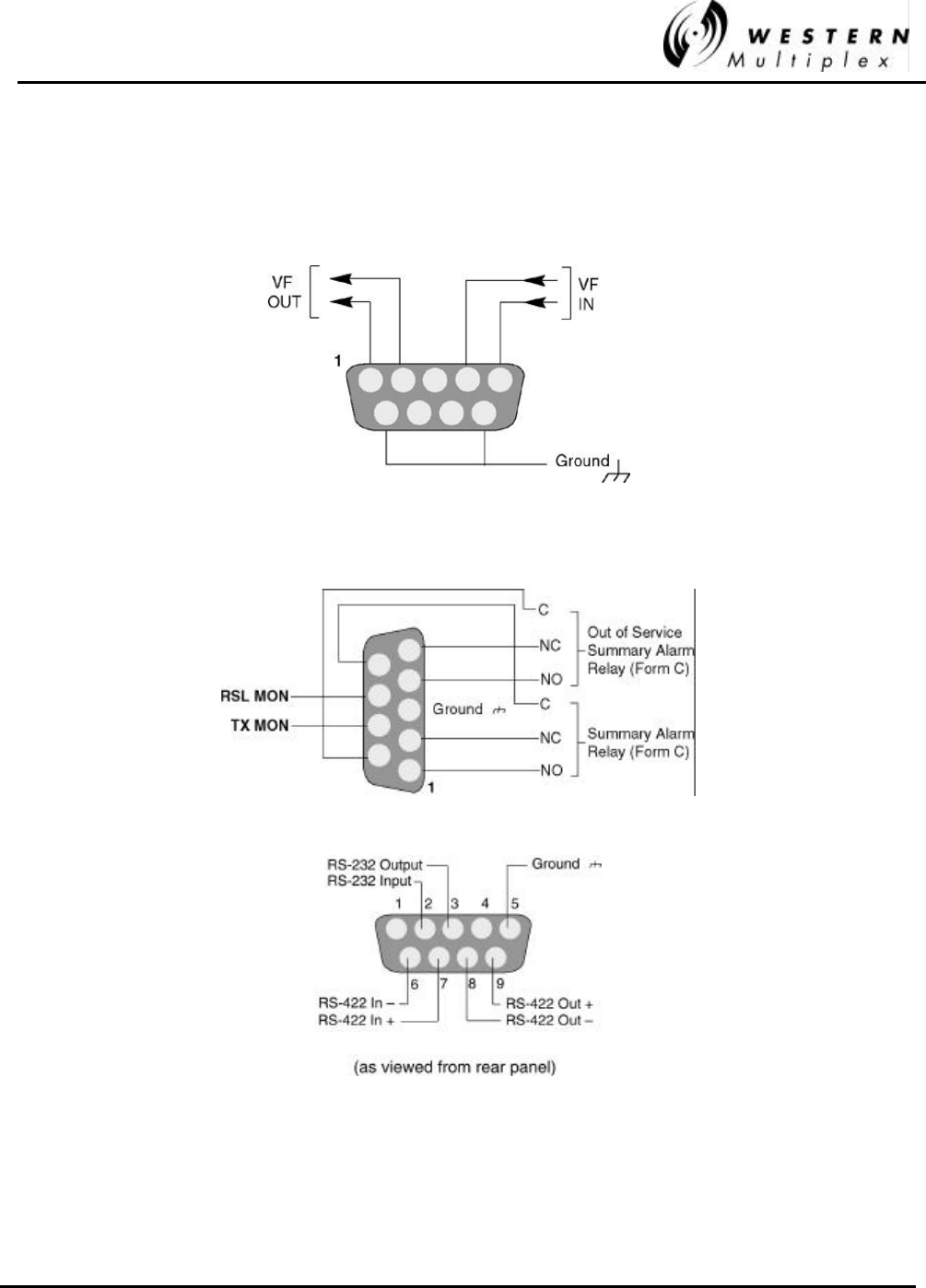
INSTALLATION AND MAINTENANCE MANUAL
Tsunami FAMILY
GIGABIT ETHERNET WIRELESS BRIDGES
JANUARY 2001
SECTION 5: APPENDICES PAGE 5-17
Appendix C – Auxiliary Data Connectors
The following figures illustrate the pin structure for all auxiliary connections. All figures are
oriented as a customer would view them, facing the connector. DC power connection information
is found in Section 3.7 of this manual.
Figure D-1: VF Port Connection
Figure D-2: Alarm Port Connections
Figure D-3: Config(uration) Port 9-Pin D-Style Connector
Do NOT connect to RS-422 pins at any time.
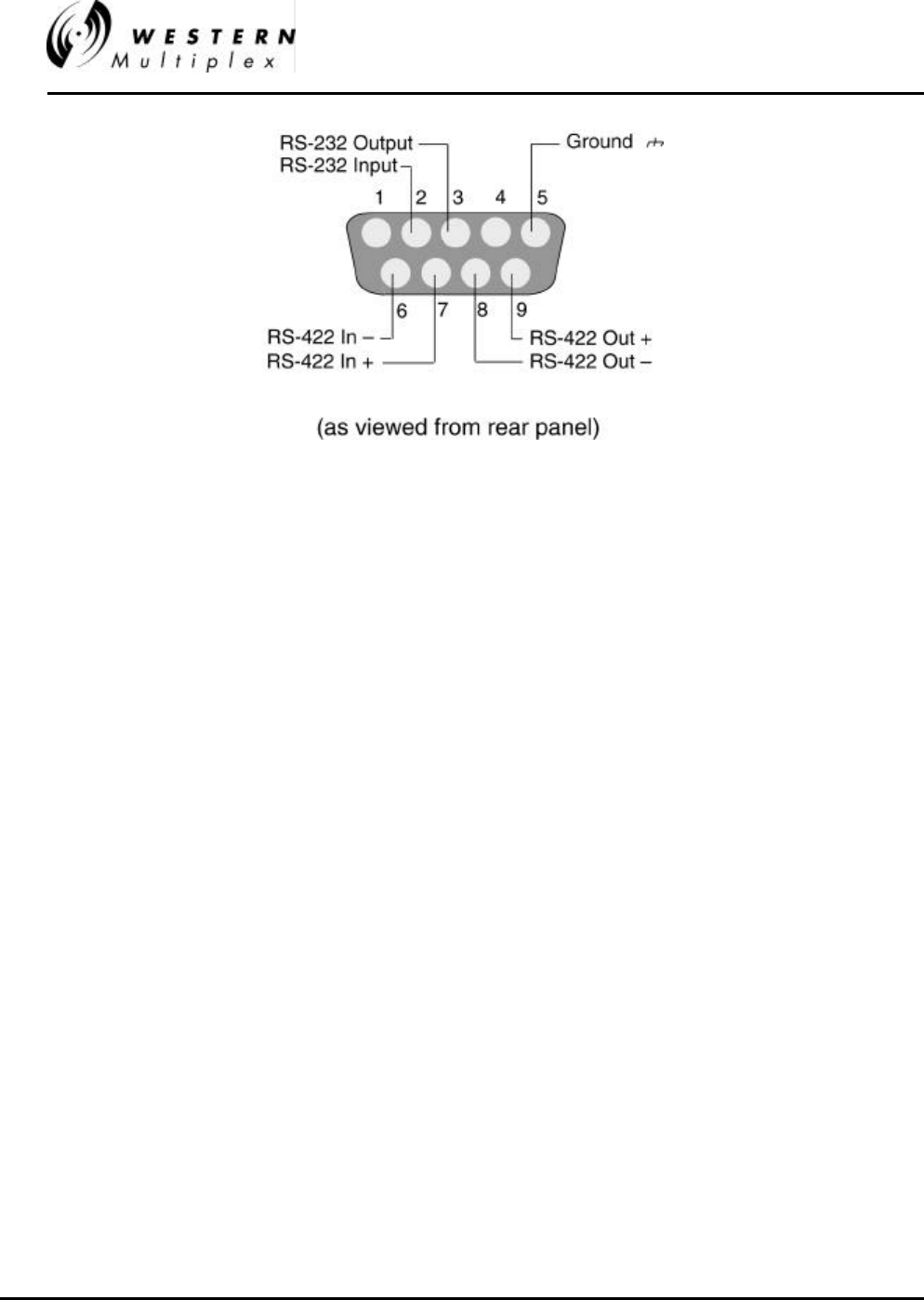
INSTALLATION AND MAINTENANCE MANUAL
Tsunami FAMILY
GIGABIT ETHERNET WIRELESS BRIDGES
JANUARY 2001
PAGE 5-18 SECTION 5: APPENDICES
Figure D-4: AUX DATA Port 9-Pin D-Style Connector
Do NOT connect to RS-422 pins at any time.

INSTALLATION AND MAINTENANCE MANUAL
Tsunami FAMILY
GIGABIT ETHERNET WIRELESS BRIDGES
JANUARY 2001
SECTION 5: APPENDICES PAGE 5-19
Appendix D – Installation and Troubleshooting (foldout)
Fold-out page inserted after this page

INSTALLATION AND MAINTENANCE MANUAL
Tsunami FAMILY
GIGABIT ETHERNET WIRELESS BRIDGES
JANUARY 2001
PAGE 5-20 SECTION 5: APPENDICES
Your Notes on the Tsunami Radio
Index
A
AC..............................................................................................................................................................3-13
Accessories................................................................................................................................................ 2-14
AIS...............................................................................................................................................................2-5
Alarm connections..................................................................................................................................... 3-24
Alarms .......................................................................................................................................................3-21
Alignment, antenna....................................................................................................................................3-16
AMI .............................................................................................................................................................2-5
Antenna.............................................................................................................................. 2-3, 3-3, 3-16, 3-20
Antenna installation................................................................................................................................... 3-14
Antenna planning.........................................................................................................................................3-7
ARP ...........................................................................................................................................................5-12
Auxiliary connectors.................................................................................................................................. 5-17
Availability calculation................................................................................................................................3-6
B
B8ZS............................................................................................................................................................ 2-5
Bit Error Rate ..............................................................................................................................................3-6
bridge...........................................................................................................................................................5-7
Buffer....................................................................................................................................................2-4, 5-1
C
Calculations .................................................................................................................................................3-5
Caution ........................................................................................................................................................1-2
collision .......................................................................................................................................................5-9
Connections ................................................................................................................2-4, 2-5, 2-11, 3-18, 5-1
Container .....................................................................................................................................................3-1
CRC............................................................................................................................................................. 5-4
D
DC ......................................................................................................................................................3-7, 3-11
Delay............................................................................................................................................................5-1
Digital Capacity........................................................................................................................................... 2-4
DSX-1..........................................................................................................................................................2-5
Duplex .........................................................................................................................................................5-1
E
EIRP ..........................................................................................................................................................3-20
Environment ................................................................................................................................................2-6
Errors........................................................................................................................................................... 4-9
Ethernet........................................................................................................................................................5-2
Ethernet packet ............................................................................................................................................5-3
F
Fade margin .................................................................................................................................................3-6
Filtering ................................................................................................................................................2-4, 5-1
Fresnel .........................................................................................................................................................3-4
Front panel...................................................................................................................................................2-7
FTP............................................................................................................................................................5-12
G
Grounding..................................................................................................................................................3-11
H
hub............................................................................................................................................................... 5-7
I
Icons ............................................................................................................................................................1-2
IEEE ..........................................................................................................................................................5-15
Indicators.....................................................................................................................................................2-9
Installation ................................................................................................................1-1, 2-14, 3-3, 3-14, 3-19
ISO.............................................................................................................................................................5-11
ISO 9000.......................................................................................................................................................... i
L
LAN............................................................................................................................................................. 2-4
LAYER........................................................................................................................................................5-2
learning........................................................................................................................................................5-7
Line-of-sight ................................................................................................................................................3-4
Link budget..................................................................................................................................................3-5
Loopback.....................................................................................................................................................2-5
M
MAC address............................................................................................................................................... 5-4
Mechanical...................................................................................................................................................2-6
Mounting .....................................................................................................................................................3-9
N
NMS ..........................................................................................................................................................4-13
Note .............................................................................................................................................................1-2
O
Orderwire................................................................................................................2-5, 2-11, 3-19, 3-21, 3-22
OSI Model ...................................................................................................................................................5-2
P
Path..............................................................................................................................................................3-4
Path planning ...............................................................................................................................................3-7
PING..........................................................................................................................................................5-13
Power..........................................................................................................................2-2, 2-6, 2-14, 3-3, 3-10
Power connection.......................................................................................................................................3-13
Power connection, DC...............................................................................................................................3-11
Power supply planning................................................................................................................................. 3-7
Professional installation..........................................................................................................................iii, 1-1
R
Rear panel..................................................................................................................................................2-13
Receive signal level ...........................................................................................2-8, 3-3, 3-5, 3-14, 3-15, 3-16
Receiver.......................................................................................................................................................2-3
Regulatory ...................................................................................................................................... iii, 2-6, 5-1
REN...........................................................................................................................................................3-22
Repair ..........................................................................................................................................................4-3
repeater ........................................................................................................................................................5-6
RF Exposure ..............................................................................................................................................3-14
ROUTE......................................................................................................................................................5-14
router ...........................................................................................................................................................5-7
RS-232.................................................................................................................................... 2-12, 3-26, 3-27
RSL............................................................................................................................................................3-16
S
Shipping..............................................................................................................................................2-14, 3-1
SNMP ........................................................................................................................................................5-15
subnet...........................................................................................................................................................5-6
System .........................................................................................................................................................2-4
T
Technical support ........................................................................................................................................4-2
Telephone ..................................................................................................................................................3-22
Telnet.........................................................................................................................................................4-25
TelNet........................................................................................................................................................4-13
TELNET...........................................................................................................................................2-12, 5-15
Test.............................................................................................................................................................. 2-5
Tips..............................................................................................................................................................1-2
Tools............................................................................................................................................................3-8
traffic .........................................................................................................................................................5-10
Transmitter...................................................................................................................................................2-2
Troubleshooting........................................................................................................................................... 4-1
Turn-up......................................................................................................................................................3-19
U
Update .......................................................................................................................................................4-24
UTP .............................................................................................................................................................5-5
W
Warranty......................................................................................................................................................... v
WINIPCFG................................................................................................................................................ 5-15
For ISO Purposes -
Last Page of this Manual